May 31, 2019
Lise Davidsen sings Wagner and Strauss
Besides her Norwegian roots, she shares with the distinguished Wagnerian soprano a warm, gold-flecked timbre and full, incandescent top notes. Hers is a Rolls-Royce among voices. Now in her early thirties, Davidsen’s schedule is already booked up with engagements at A-list opera houses. This is not the first record she appears on, but it is her debut solo album for Decca, with whom she has an exclusive contract. With two Wagner arias and familiar songs by Richard Strauss, the program contains no surprises, just Davidsen claiming the repertoire that is her birthright by virtue of her exceptional talent.
The recital opens with Elisabeth’s two arias from Wagner’s Tannhäuser, a role in which the soprano will make her Bayreuth debut this year. With big dramatic voices there is always the challenge of capturing their full breadth on recordings. It’s like trying to stuff a silk parachute into a matchbox. Climactic notes, such as at the conclusion of Dich, teure Halle, are indeed too resonant for mere living room speakers to handle. But, on the whole, the technical team has done an excellent job, beautifully preserving Davidsen’s velvety warmth. In Elizabeth’s prayer, she sustains the measured lines with no difficulty, but also evokes the pathos, if not the fragility, of this broken woman. Esa-Pekka Salonen and the Philharmonia Orchestra accompany her in Wagner with athletic vigor and in Strauss with bright, glinting colors, but this recital is all about the diva. If the Wagner excerpts hold the promise of memorable Elizabeths, Elsas and heavier roles such as Isolde, the sole Strauss aria, from Ariadne auf Naxos, benefits from Davidsen already having sung the role in staged productions, including ones at Glyndebourne and Aix en Provence. She sings Es gibt ein Reich sumptuously, but also with nuance and a tinge of melancholy that lingers. She brings the same gorgeous wistfulness to orchestrated songs by Strauss such as Ruhe, meine Seele! and Morgen. Meeting the narrative demands of Heimliche Aufforderung, Davidsen emerges as an intelligent painter of text, and her voice bursts effortlessly in the rapturous Cäcilie.
In Malven, the very last song Strauss composed, the voice is lightened against Wolfgang Rihm’s 2012 orchestration, which evokes summer flowers teased by the wind. There are several fine interpretations of Strauss’s Four Last Songs (technically, the last four but one), but this one joins the list of those most gorgeously sung. There is no register or hue in which Davidsen’s voice doesn’t ripple, glide and soar, making any voice-loving heart skip a beat or two. No doubt she will sing these songs of introspection and resignation many times and on many stages and her insight into them will deepen with age and experience. But, catching her in youthful opulent freshness, this transfixing account will demand to be played over and over again. In fact, the whole recording invites unabashed wallowing in a rare voice coupled with the communicative power of a true artist. So wallow away, and let’s hope that, even though the golden times of studio recordings are long gone, this will be one of many tracking the path of this golden voice.
Jenny Camilleri
image=http://www.operatoday.com/Davidsen.png image_description=Decca 4834883 product=yes product_title=Lise Davidsen sings Wagner and Strauss product_by=Lise Davidsen (soprano), Esa-Pekka Salonen (conductor), Zsolt-Tihamér Visontay (violin), Philharmonia Orchestra product_id=Decca 4834883 [CD] price=$12.59 product_url=https://amzn.to/2WfeIJFNicky Spence and Julius Drake record The Diary of One Who Disappeared
He and pianist Julius Drake are evocative storytellers in this unsettling tale of desire and doom. Janáček himself was in the grip of romantic obsession when he composed the Diary, the first of several works inspired by Kamila Stösslová, whom he met in 1917. Almost forty years younger and married, Stösslová neither fanned nor spurned Janáček’s attentions. As his muse, she inspired characters in his operas Káťa Kabanová, The Cunning Little Vixen and The Makropoulos Affair. Zefka the gypsy was her first artistic incarnation. As per Janáček’s instructions, she was the model for the woman on the front cover of the published score. The text, anonymous poems that appeared in a Brno newspaper, is scored for tenor, mezzo-soprano, piano and a small choir.
Spence, who has performed Janáček on the operatic stage, is eminently at home in the composer’s distinctive vocal writing, with its speech-like cadences and folk music lineage. His delivery is immediate, as if he’s confiding to a sympathetic listener. In an emotionally layered portrayal, his hero falls in love with sweet head tones. His fate is sealed when Zefka proffers to show him “how gypsy people sleep”. At the moment of surrender, Spence, sounding dazed, pares down his voice to a sliver of resigned sadness. Later on, he projects mordant self-hatred as the young man realizes he has fallen for someone he considers his social inferior – the undertone of violence is palpable. Mezzo-soprano Václava Housková avoids crass earthiness, giving the folky lilt of her siren call a youthful guilelessness. The offstage female chorus, recorded with a pronounced reverb, surrounds her with eerie echoes, evoking the almost supernatural role that destiny plays in this work. “Who can escape his fate?”, asks the troubled hero. Drake gives an unequivocal answer in the Intermezzo erotico, with its tattered rhythms and final, plummeting 32nd notes. Like the beautiful Zefka, Drake’s piano playing is ravishing and tenacious, with assertive coloring that leaves the harmonies transparent. Dissonances are forceful without ever sounding ugly. After Spence’s anguished, closing top Cs, there can be no doubt about the protagonist’s unhappy future. This performance was recorded at All Saints’ Church in East Finchley, London. Piano and solo voices are encircled with space, but sound close enough to preserve intimacy.
The second half-hour of the recording is more cheerful. The choir sings the first version of Říkadla (Rhymes), eight nursery rhymes for one to three voices, clarinet and piano. (In the later, definitive version, Janáček more than doubled the number of songs, scoring them for chamber choir and ten instruments.) Drake and clarinetist Victoria Samek accompany the charmingly nonsensical words with a sparkling sense of fun. This time, the reverb around the singing trio is obtrusive, giving them a disembodied quality that jars with the material. Spence and Housková feature again in the last set, twelve selections from Moravian folk poetry in songs. These folk tune arrangements, a mix of wistful ballads, love songs and brisk dances, illuminate the influence of traditional music on Janáček’s idiom. They are also utterly captivating. Housková interprets them with endearing simplicity, like someone sharing native songs learned in childhood. Spence’s approach is a tad more operatic. He shades the words with a feather-light touch, suggesting a sigh on a diminuendo, or an increasing heartbeat on a rising phrase. The recital ends with a foot-tapping duet, a party number called Musicians. For those who feel like singing along, the accompanying booklet contains the original poems in Czech, with English rhyming translations. Texts in Czech and English translations are also included for The Diary of One Who Disappeared and the nursery rhymes.
Jenny Camilleri
image=http://www.operatoday.com/CDA68282.png image_description=Hyperion CDA68282 product=yes product_title=Leoš Janáček: The Diary of One Who Disappeared product_by=Nicky Spence (tenor), Julius Drake (piano), Véclava Housková (mezzo-soprano), Voice Vocal Trio, Victoria Samek (clarinet) product_id=Hyperion CDA68282 [CD] price=$16.99 product_url=https://amzn.to/2YYC17gMay 29, 2019
Time Stands Still: L'Arpeggiata at Wigmore Hall
Music for a While similarly brought the Baroque into relaxed conversation with jazz, folk and world music; La dama d’Aragó homed in on songs and dances from Catalonia and Mallorca. More recently, in Himmelsmusik , L’Arpeggiata explored connections between the seventeenth-century German and Italian traditions, as German traditions of counterpoint and chorale were both sustained and developed, while also integrating Italian innovations such as poly-choral antiphony and solo song.
Time Stands Still , presented last night at Wigmore Hall, was a rather curious affair, though. Even the title seemed paradoxical, as Alexandra Coghlan points out in her programme article: ‘it’s a concert of musical change and evolution, tracing the shifts, twists and turns of a century of social, political and aesthetic upheaval for the British Isles’. (Plus ça change, then …)
So, we started with a sequence celebrating the Art of Melancholy, as Dowland couched political complaint within romantic suffering. Then followed some sweetly soporific songs by Robert Johnson and John Bennet, while the latter part of the programme - performed without an interval, with several items segue, and lasting just over one hour - took us into the Jacobean alehouse for Broadside ballads and dances by John Playford et al. Purcell’s ‘Music for a While’ brought proceedings to a close, Dryden’s imagery of medicine, science and religion mingling with Purcell’s music to evoke the latter’s power. On paper, at least, it looked a bit of a musical menagerie.
The vocal items were sung by Belgian soprano Céline Scheen. Commenting on the above-mentioned Himmelmusik, I remarked the ‘purity’ of Scheen’s soprano, her ‘exquisite phrasing and carefully placed nuance’ which ‘perfectly captured the text’s spirit of tenderness and love’, her ‘crystalline tone, and considerable vocal agility’. All such attributes were again on display.
But, on the previous occasion I also felt that the ‘purity’ of the tone did not always serve the text well and wished for ‘greater variety of colour to complement and bring to the fore the textual inflections’. And, if the ‘sacred’ items of Himmelmusik were sometimes well served by Scheen’s angelic ethereality, then that wasn’t the case in Time Stands Still. Quite simply, the text - which allows the singer to communicate and the listener to understand the context - matters in these items: as much in Dowland as in a bawdy ballad. Both may hold covert meaning and messages. Both are powerfully ‘human’ in expression, whether employing and demonstrating a refined sensibility or more earthier energies.
Scheen had a heavy music book in her hands, often holding it quite high before her and peering closely; however, I could scarcely discern a single word of the texts she sang. Her soprano is beautiful, and it is pure: so much so that it seemed almost disembodied on this occasion. And, its pristineness is unblemished, never tainted by even the most tantalising dust-speck of colour. There is undoubtedly repertoire for which such a voice is ‘perfect’, but Dowland’s lute songs are not that repertoire.
A good singer of lute song needs not just a clear voice and flexibility in the upper range - both of which Scheen possesses - but also refined poetic understanding. For example, in ‘Sorrow stay’, the penultimate line, ‘But down, down, down I fall,’ embodies the poet-protagonist’s struggle and defeat, but Scheen’s distorted vowel (I seemed to hear two syllables on ‘down’) and changeless tone did not communicate this, as had Ian Bostridge , for example, with Elizabeth Kenny at Kings Place in 2014.
In ‘Time stands still’ and ‘Flow, my tears’ it was, paradoxically, only when the instrumentalists joined the song that human emotions breathed and flowed. The warmth of Doron Sherwin’s cornetto was a delight throughout the evening while Francesco Turrisi played the organ with imaginative and wry fingers, developing counterpoint, elaborating ornaments. In ‘Flow, my tears’, Pluhar was eloquent in her engagement with the voice. In ‘I saw my lady weep’ it as Sherwin - performing from memory throughout the recital - who exploited the chromatic nuances and rhythmic tangles and tugs.
Perhaps Scheen’s soprano was more suited to Robert Johnson’s ‘Care-charming sleep’ and John Bennet’s ‘Venus’s birds’ where the lovely clean sound was beguiling, and the words are designed to be cumulative in effect rather than deliberately pointed. But, when we reached the ‘traditional’ songs and ballads, the story-teller’s glee and mischief was sadly missing. It take a natural ‘actor’, one with a love of language that can be expressed through articulation and tone, to make lines such as the repeated ‘Hi diddle um come feed-al’ of ‘The Tailor and the Mouse’ come alive and feel rich, raw and rollicking. Though, it must be noted that Turrisi did a good job of conjuring the mouse’s scurrying and fleeing from the tailor’s intent pursuit! Sherwin showed how it should be done in his forthright interjections in ‘The Frog and the Mouse’: now we had words, vibrancy and directness.
It was, in fact, the instrumental items that made the strongest impression. William Brade’s ‘Scottish Dance’ got my foot tapping as Sherwin pushed ‘freedom within constraints’ to its expressive peak, and Turrisi mimicked a brusque bag-pipe drone. Playford’s ‘Stanes Morris’ was similarly abandoned in its rhythmic fire, but never other than consummately controlled. The latter’s ‘Parson’s Farewell’ seemed to embody a neat ironic detachment, while in ‘Paul’s Steeple’ I loved the rhetorical confidence, even cheekiness, of Josep María Martí Duran’s baroque guitar as he explored timbre and texture with panache, while Turrisi brushed a tambourine with style.
We had an encore in which Morley’s ‘There was a lover and his lass’ morphed from madrigal to jazz improv, and Sherwin’s cornetto became Acker Bilk’s clarinet. But, such immediacy, invention and sheer fun wasn’t quite enough to overcome the preceding programme’s distance and detachment.
Claire Seymour
L’Arpeggiata: Céline Scheen (soprano), Francesco Turrisi (harpsichord, organ), Josep María Martí Duran (lute, baroque guitar), Doron Sherwin (cornet), Christina Pluhar (director, theorbo)
John Dowland - ‘Time stands still’, ‘Flow my tears’, ‘Sorrow, stay, lend true repentant tears’, Anthony Holborne - ‘The Image of Melancholy’; Dowland - ‘I saw my Lady weep’; Robert Johnson - ‘Care-charming sleep’, ‘Have you seen the bright lily grow?’; John Bennet - ‘Venus’ birds’; William Brade - Scottish Dance; Trad/English - ‘The Three Ravens’; John Playford - Stanes Morris; Trad/English - ‘The Tailor and the Mouse’; Playford - ‘Parson’s Farewell’; Trad/English - ‘The Oak and the Ash’; Playford - ‘Paul's Steeple’; Trad/English - ‘The Frog and the Mouse’; Henry Purcell - ‘Music for a while’.
Wigmore Hall, London; Tuesday 28th May 2019.
image=http://www.operatoday.com/C%C3%A9line%20Scheen.jpg image_description= product=yes product_title=Time Stands Still: L’Arpeggiata at Wigmore Hall product_by=A review by Claire Seymour product_id=Above: Céline ScheenPuccini’s Tosca at The Royal Opera House
One should at least be relieved that it’s set sometime during the 1800’s - and not in a carpark where a resurrected Scarpia returns in Act III to shoot Tosca as happens in Sturminger’s re-imagined production at Salzburg (shabby, and a shocker). When I reviewed this Covent Garden production back in January 2018, I seemed to view it more as one malevolent and cruel empire set against the backdrop of a city infected by poverty and moral decline. Andrew Sinclair’s revival seems a bit less focussed on this - or perhaps I simply couldn’t see it because what hasn’t changed is the simply unremitting darkness in which much of this production is set. I still think Paul Brown’s designs are largely impressive but what I noticed more this time was the imbalance of them. There is perhaps something askew when the church of Sant’Andrea della Valle in Act I lacked scale and Scarpia’s apartment at the Palazzo Farnese doesn’t. This is a church that often resembles a crypt, but it fits well with the oppressive feel of Act I where some are just nearer God and some are just unfortunate enough never to be.
Act II did seem a little less pallid this time which was just as well because it centred attention so much more neatly on the power struggle which is the centrepiece between Scarpia and Tosca. Act I in this production, despite all that is going on, still felt static; yet Act II never seemed constrained - though I think this largely had to do with the powerhouse performances of Terfel and Opolais who used every bit of the stage like warring tigers. One was perhaps a little more conscious of diversions, such as the opening and closing of window shutters (I really lost count of how many times that happened), but they prowled magnificently. Act III still seems problematic. I was more conscious than ever that it seemed back to front. Depending on where you sit in the stalls, the shooting posts have a tendency to block your view and the lighter this short act becomes the less it becomes visually convincing. As impressive as this particular immolation from Tosca might have been, one was still left with the impression she had simply flung herself off the end of a rather inconspicuous pier.
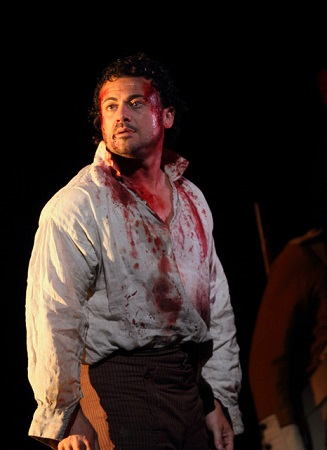 Vittorio Grigolo (Cavaradossi). Photo credit: Catherine Ashmore.
Vittorio Grigolo (Cavaradossi). Photo credit: Catherine Ashmore.
The shock value in this revival comes from the casting. The opening night audience clearly fell in love with Vittorio Grigòlo’s Cavaradossi. The role is a relatively recent one he has taken on, having made his debut with it at the Metropolitan Opera last year; I can’t help but feel somewhat equivocal about him. Joseph Calleja, who sang Cavaradossi in 2018 here, sounded rather small - Grigòlo is the exact opposite. His is not a voice to shy away from using its wide range, though what many might confuse as heft I’d rather describe as ungainliness. What is so frustrating about him is that there is such an undeniable originality he brings to his phrasing which, in part, is an extension of his quite remarkable acting. Okay, some might call it a little hammy, and certainly it stretches the boundaries of good taste relatively speaking, but just as his acting pushes limits so does his vocal characterisation of this part. If a tenor like Jonas Kaufmann is always pristine and rich in this role, Grigòlo cuts it with an unpolished legato and a roughness which seems much closer to Cavaradossi himself. He is really a little uncouth. But no one really falls in love with perfection, or even a remotely ideal personification of it. I’ve rarely heard a more visceral ‘Recondita Armonia’ but it did Grigòlo few favours because the voice was often at such full tilt it sometimes felt off-balance. Thrilling it might have been, but you also felt he was going to fall flat on his face (or, rather, off his scaffold). His acting during ‘E lucevan le stelle’ was enormously draining to watch - but at the same time compelling. Did one really care that the voice (again stretched at an unbelievably loud volume) fractured in places? Not one bit. He certainly has the ability to sing with restraint - this was notable in some of his duets - and he can scale the voice down when he wants to. But ultimately, this felt like a performance from a tenor who liked to live both in the fast lane and somewhat dangerously. A Cavaradossi who perhaps had parked his sportscar is Sturminger’s Salzburg carpark.
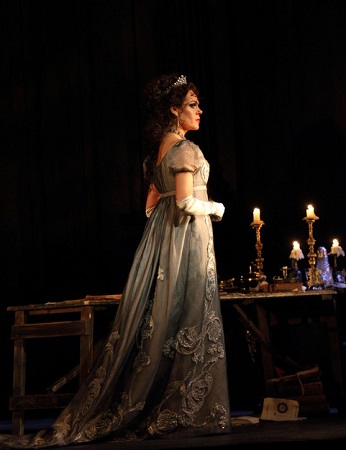 Kristine Opolais (Tosca). Photo credit:Catherine Ashmore.
Kristine Opolais (Tosca). Photo credit:Catherine Ashmore.
Kristine Opolais’s Tosca, on the other hand, seemed everything her Cavaradossi wasn’t. If he wobbled and seemed rough-hewn, she was like an empress with an ermine softness to her bottom register and a steely brilliance to her upper that never betrayed a hint of unsteadiness. I’ve never really noticed in many Tosca’s previously the underlying jealously that betrays her character in Act I but here Opolais was a real storyteller, unravelling her insecurity with touching sincerity and a little humour to pad it out. Some Tosca’s can - indeed do - seem very distant from their Cavaradossi but Opolais worked a beautiful chemistry with Grigòlo. But Tosca is a very complete role, one that requires a singer to be a great actress too and that is no more so that in the great Act II.
I suppose any Tosca today would be fortunate to have Bryn Terfel as her Scarpia and Opolais did not waste this opportunity. Perhaps because Terfel brings such sheer brutishness and malevolence to Scarpia, Opolais was formidable. The voice is just heavenly - those high notes were like jangling chains whipping against exposed flesh. But how rare to hear a ‘Vissi d’arte’ that was sung with so much reverence and depth to its inner meaning. So many sopranos sing this aria towards the audience; Opolais was bowed, penitent, the voice like an invocation. It made her killing of Scarpia all the more gruesome as she stabbed him not once, but twice, exposing his waistcoat so we could see his blood-soaked shirt.
Terfel’s Scarpia has lost nothing over the years. There are any number of things about his performance which still have the capacity to shock an audience. His stage presence is completely absolute, and you oddly feel he’s there when he really isn’t doing anything. His magnetism is beyond compelling. Terfel’s Scarpia is becoming very like Tito Gobbi’s - the snarling notes, the eyes that widen and glower with terrifying power, the stalking like a presumptive predator. When he unbuttons his waistcoat because he believes he has vanquished Tosca the shock he might actually rape her is quite real. The voice itself is a massive instrument, a hammer of Thor. What was so exquisite about this Act II - so completely compelling - was Terfel’s projection of the notes. Every nuance was there; it was simply astonishing.
What was also unquestionably better this time was the conducting of the score; Alexander Joel clearly knows his way through the treacherous terrain of Puccini’s music. There were moments when he felt the need to linger, or broaden his tempo - Act II was generally somewhat longer because of his tendency to just make it one long crescendo that suddenly collapses into final murderous resolution. He sometimes made Grigòlo’s more heroically-minded attempts at stage dominance more difficult by reigning him in, notably during ‘E lucevan le stelle’ which caused the tenor problems - but the opposite was the case during Grigòlo’s two cries of ‘Vittoria’ which pushed him into brinkmanship. The orchestral playing was glorious with beautiful string tone, and Joel evidently lavished attention to the brass playing; the horns at the opening of Act III were simply fabulous in both tone and precision.
This is a Tosca that still looks beautiful at times, though that beauty often means it looks somewhat gritty, perhaps even grungy in places. No amount of gold can make a crypt look ecclesiastical, and not even a star-lit sky can rescue a final act that looks like a couple of scrappy wooden posts beside a grey wall that, well, looks like a grey wall. This was an evening rescued by its singers - and in the case of Grigòlo’s Cavaradossi rather overshadowed by it. If Opolais and Terfel gave us a masterclass in great singing and acting, Grigòlo gave us something else. I came out of this undoubtedly interesting performance thinking I hadn’t really seen Puccini’s Tosca but a new opera called Puccini’s Cavaradossi.
From 30th May until 20th June 2019
Marc Bridle
Puccini: Tosca
Kristine Opolais (Tosca), Vittorio Grigòlo (Cavaradossi), Bryn Terfel (Scarpia), Hubert Francis (Spoletto), Jihoon Kim (Sciarrone), Michael Mofidian (Angelotti), Jonathan Lemalu (Sacristan); Jonathan Kent (director), Alexander Joel (conductor), Andrew Sinclair (revival director), Paul Brown (designer), Mark Henderson (lighting), Orchestra and Chorus of the Royal Opera House.
Royal Opera House, Covent Garden, London; Monday 27th May 2019.
image=http://www.operatoday.com/Terfel%20as%20Scarpia.jpg
image_description=
product=yes
product_title=Tosca: Royal Opera House, Covent Garden
product_by=A review by Marc Bridle
product_id=Above: Bryn Terfel (Scarpia)
Photo credit: Catherine Ashmore
May 27, 2019
A life-affirming Vixen at the Royal Academy of Music
However, while Janáček’s opera is based upon a comic strip - its libretto being drawn from the narrative which Rudolf Tĕsnohlídek wrote to accompany illustrations by Stanislav Lolek which were published in the Brno newspaper, Lidové noviny - as we follow the story of the life and adventures of the eponymous vixen, it’s no child’s play for a director to balance the elements of pure fantasy with the opera’s underlying realism.
In this production for Royal Academy Opera, director Ashley Dean has decided that simplicity is a virtue: and, with considerable assistance from Kevin Treacy’s terrific lighting design and Laura Jane Stanfield’s panoply of fabulous costumes, he’s proved right.
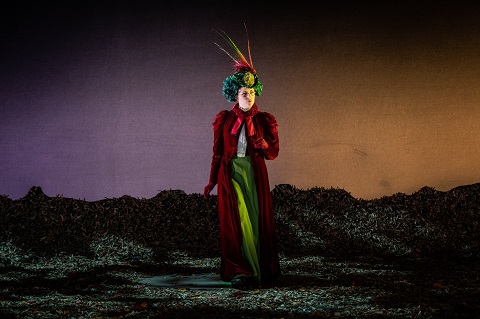 Helen May (Woodpecker). Photo credit: Robert Workman.
Helen May (Woodpecker). Photo credit: Robert Workman.
Stanfield’s set comprises just a carpet of wood-chippings which creep a little way up a backdrop swathed in gradated washes of deep hues - indigo, ultramarine, emerald - the floods of colour powerfully evoking the forest milieu. A few props are carried in now and then, to indicate a change of locale: the hens roost on wooden chairs, the Schoolmaster and Priest grumble around tables in the inn. Treacy’s lighting makes the forest world by turns vivid and alive, nostalgic and restful, the colour drawing us into the animals’ world. In this way, the animals are not simply ‘symbols’, reflecting human flaws and frailties; rather, nature is truly present and real. A recollection by Janáček himself, of the process of composition, seems apposite: ‘It was odd how red fur continually gleamed before my eyes.’ Dean and movement director Christina Fulcher create a strong sense of ‘communities’: of a human society and an animal milieu. Most importantly, the interaction between them is persuasive.
In this regard, Stanfield’s incredibly detailed costumes also play large part. The above-mentioned Brno preview article tempted its readers with a description of the ‘seventy costumes’ designed by artist Eduard Milén which they would enjoy: grasshoppers and crickets would hop about in ‘yellow-green tailcoats and magnificent little wings’; nocturnal glow-worms would be equipped with reflectors ‘to light up their bottoms’; the ‘melancholy beauty’ of an iridescent dragonfly would be enhanced by the glittering gold of its fragile underwings.
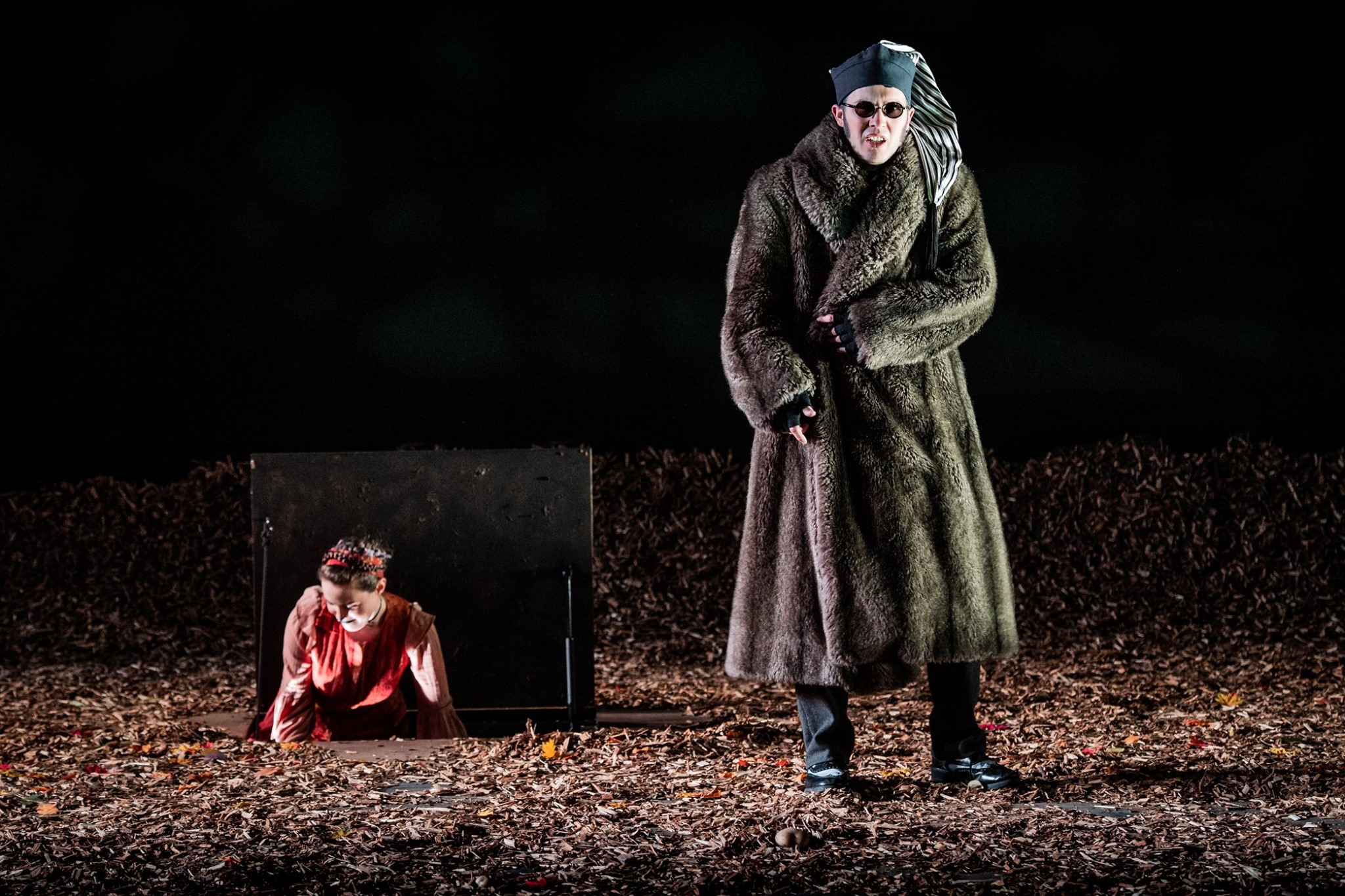 Thomas Bennett (Badger). Photo credit: Robert Workman.
Thomas Bennett (Badger). Photo credit: Robert Workman.
Stanfield’s attention to detail is no less comprehensive or imaginative, and the results are beguiling as she brilliantly anthropomorphises the animal world. Hats, turbans, scarfs, shawls, feathers, fur, brocade: textures and colours dance before one’s eyes. The Cockerel struts like a Persian prince in golden boots and towering turban-crest; Badger is cloaked in a glorious grey fur coat, topped with a bandana-cum-bedcap; the hens shake their white petticoats and stamp about in marigold-stockings. The Vixen’s layers of red, orange and brown are both down-to-earth and feminine; the Fox strides confidently in his tall leather boots, but his shabby corduroy waistcoat speaks of a warm heart behind the pride. Cleverly, Stanfield manages to suggest both a rustic earthiness and a Victorian primness - adding piquancy, for example, to the scene where the animals peer into the Vixen’s underground den, spitting out their disapproval and outrage at her amorous activities with the Fox.
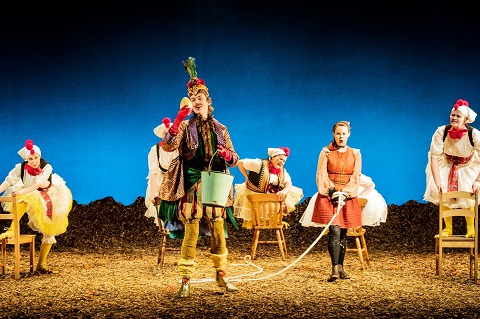 Samuel Kibble (Cock). Photo credit: Robert Workman.
Samuel Kibble (Cock). Photo credit: Robert Workman.
As the action unfolds, the immediacy and realism of the drama is wonderfully blended with fantasy and fable. There is a winning directness in scenes such as the henhouse, where the Machiavellian Cock forces the hens to lay ever-bigger eggs to feed his capitalist greed, while they remain blind to their own subjugation. When he meets a swift end, a dupe of the Vixen’s ‘playing dead’, we are both shocked and satisfied. The Act 1 dance between the Frog and the drunken Mosquito (he’s bitten the inebriated Forester), and the dawn games and chatter of the animals in Act 2, are enchanting.
 Peter Harris (Mosquito). Photo credit: Robert Workman.
Peter Harris (Mosquito). Photo credit: Robert Workman.
Having excelled in RAO’s recent productions of Semele and L’enfant et les sortilèges , here Lina Dambrauskaitė was a vivacious and tremendously engaging Vixen. Her soprano has a lovely freshness, but she also captured the Vixen’s strength and passion, as when she attacks the poacher Harašta or in her flirtation with the Fox, when she brags about her thievery and courage. Dambrauskaitė was well-partnered by Hazel Neighbour’s Fox, whose slightly heavier soprano shone richly against Dambrauskaitė’s brightness. Their love duet was a highpoint, but the revealed the gentle humour of their relationship too: there was a wicked glint in Fox’s eye as he glanced towards their den, wryly asking his Vixen, ‘How many children do we have? How many shall we have?’ (The opera was sung in Norman Tucker’s English translation.)
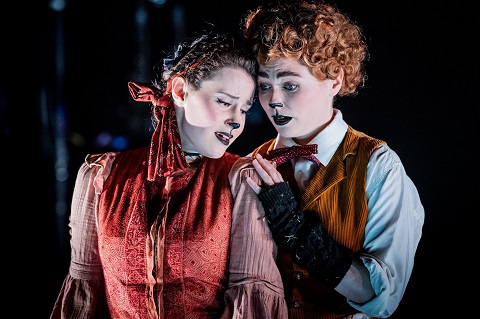 Lina Dambrauskaitė (Vixen) and Hazel Neighbour (Fox). Photo credit: Robert Workman.
Lina Dambrauskaitė (Vixen) and Hazel Neighbour (Fox). Photo credit: Robert Workman.
As the Forester, James Geidt revealed a strong, true baritone which conveyed the gamekeeper’s inner emotions with conviction. Initially evincing a morose world-weariness, his growing feeling for the Vixen - evidenced in a vulnerable hesitancy with his gun, allowing her to escape - flourished into a compassion which was both touching and credible.
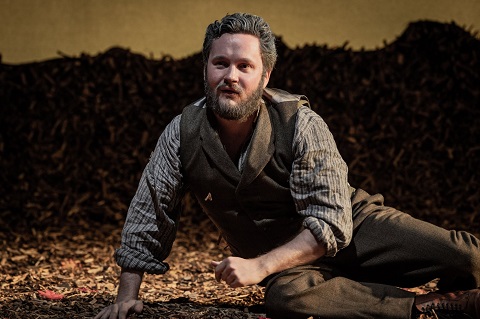 James Geidt (Forester). Photo credit: Robert Workman.
James Geidt (Forester). Photo credit: Robert Workman.
The characterisation was consistently good. Peter Harris’s narration conveyed every ounce of the Schoolmaster’s pessimism, concluding with a laconic shrug of indifference. Thomas Bennett was an eloquent Priest; Niall Anderson displayed a powerful baritone as Harašta. Robert Forrest and Yuki Akimoto formed an effective pair as the Innkeeper and his wife. One can see why Vixen is attractive repertoire for the conservatoires. The cast is large thus allowing many students to take solo roles. Here they did so with aplomb, with Gabrielė Kupšytė’s Dog and Lorna McLean’s Chief Hen particularly noteworthy.
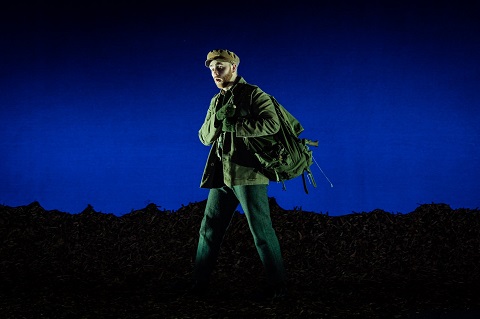 Niall Anderson (Poacher). Photo credit: Robert Workman.
Niall Anderson (Poacher). Photo credit: Robert Workman.
The death of the Vixen was truly shocking, in its suddenness, lack of mawkishness and finality. One moment the Vixen danced and taunted Harašta, free and invincible; the next she lay dead on the forest floor. The scenes of Janáček’s opera are rather episodic, and not connected in any linear or causal fashion, yet they seemed to have led inescapably to this moment. Subsequently, though, Dean struggled to maintain dramatic shape and momentum, and the final scenes drifted somewhat towards Geidt’s concluding reflections on the death of the Vixen and on his own mortality. This pantheistic creed was, however, beautifully sung, with warmth and flexibility: reconciled to life’s transience, the Forester was embraced by the beauty of forest.
Philip Sunderland conducted the Royal Academy Sinfonia in a crisp and rhythmically tight reading of the chamber arrangement of Janáček’s score made by Jonathan Dove. The dance episodes had real verve and lightness. But, while I can appreciate why this reduced scoring was used, with just five string players in the 18-strong ensemble the wind were overly dominant - at times it sounded more like Stravinsky - and while Sunderland maintained a clarity of texture which ensured that we could appreciate the details of harp, percussion and suchlike, I missed the surges of Romanticism in the orchestral episodes in which the lyricism communicates an emotional sensuousness to complement the leanness and realism elsewhere.
That said, if this production lacked a certain wistfulness, then the absence of sentimentality was welcome. Human weaknesses were exposed by their interaction with the animal world: such frailties were understood, accepted and forgiven. The Cunning Little Vixen meant so much to Janáček that he requested that the conclusion be played at his own funeral. This performance at the Royal Academy was both heart-warming and life-affirming.
Claire Seymour
Janáček (arr. Jonathan Dove): The Cunning Little Vixen
Vixen Sharp Ears - Lina Dambrauskaitė, Fox - Hazel Neighbour, Forester - James Geidt, Priest/Badger - Thomas Bennett, Schoolmaster/Mosquito - Peter Harris, Forester’s Wife - Clare Tunney, Pásek, the Innkeeper - Robert Forrest, Harašta, the poacher - Niall Anderson, The Innkeeper’s Wife - Yuki Akimoto, Dog - Gabrielė Kupšytė, Owl - Samantha Quillish, Cock Samuel Kibble, Chief Hen/Vixen Mother - Lorna McLean, Jay - Hope Lavelle, Woodpecker - Helen May, Pepík, the Forester’s son - Aimée Fisk, Frantík, the Forester’s son - Maya Colwell, Vixen Cub - Anna Mengel, Frog - Kathleen Nic Dhiarmada, Grasshopper - Ashleigh Charlton, Cricket - Jack Lee, Hens and Fox Cubs (Caroline Blair, Margaret Mitchell, Clara Lobo, Maria Ejderos Sveinungsen, Avital Green, Leah McCabe); Director - Ashley Dean, Conductor - Philip Sunderland, Designer - Laura Jane Stanfield, Lighting Designer - Kevin Treacy, Movement Director - Christina Fulcher, Royal Academy Sinfonia.
Susie Sainsbury Theatre, Royal Academy of Music, London; Friday 24 th May 2019.
image=http://www.operatoday.com/Fox%20and%20Vixen%20standing.jpg image_description= product=yes product_title=The Cunning Little Vixen: Royal Academy Opera product_by=A review by Claire Seymour product_id=Above: Hazel Neighbour (Fox) and Lina Dambrauskaitė (Vixen)Photo credit: Robert Workman
May 24, 2019
Glyndebourne’s first production of Dialogues des Carmélites to open Glyndebourne Festival 2020
Sarah Hopwood, who joined Glyndebourne as Finance Director in 1997 and subsequently became Chief Operating Officer, spoke about the unique business model that allowed Glyndebourne to fund the Production Hub: ‘It is well known that we receive no Government funding for our annual summer Festival, and it is through the financial success of that event that we are able to support our annual tour, year-round education activity (both also supported by Arts Council England) and the filming of full-length productions. We have just completed a £6.5m investment in this amazing Production Hub - creating a state-of-the-art facility to bring together our expert making teams, so that we maintain our competitive edge in creating world-class opera.’
Stephen Langridge, most recently Artistic Director at Gothenburg Opera, spoke about his long history with Glyndebourne; he took his first steps on the lawn when his father, Philip Langridge, performed on-stage and early in his career directed two youth operas at Glyndebourne, Misper (1997) and Zoë (2000). Introducing the 2020 season, he said:
‘I am thrilled to be announcing this exciting season, a classic Glyndebourne Festival smörgåsbord offering comic, tragic, and magical opera from three centuries - but with a steely through-line of amazing women, powerful in politics, strong in their relationships, and brave in their faith.’
Glyndebourne Festival 2020
Dialogues des Carmélites is one of the most devastatingly powerful works in the repertoire. Set against the backdrop of the French Revolution, it is based on a true story of religious martyrdom and follows the struggles of a young woman faced with a harrowing decision, made all the more moving by a breathtaking score.
Glyndebourne’s new production will be directed by Australian director Barrie Kosky, returning to the company for the first time since his triumphant production of Handel’s Saul in 2015. Glyndebourne’s Music Director Robin Ticciati will conduct the London Philharmonic Orchestra and an exciting ensemble cast led by Australian-American soprano Danielle de Niese, making a role debut as the opera’s heroine Blanche de la Force.
Also making its first appearance at Glyndebourne next summer is Handel’s Alcina, in a new production overseen by two Italian artists, director Francesco Micheli and conductor Gianluca Capuano.
Over the past two decades, Glyndebourne has consistently surprised and delighted audiences with its fresh take on works by Handel, including acclaimed productions of Theodora, Rodelinda, Giulio Cesare, Rinaldo and Saul. The company is building on that record with the first major new UK production of Alcina for over 20 years. Set in a world of enchantment and magic, the opera calls for lavish stage effects, promising a visual spectacle for Glyndebourne audiences next summer.
Taking the title role is Russian soprano Kristina Mkhitaryan, with Armenian soprano Nina Minasyan as Morgana, Anglo-French mezzo-soprano Anna Stéphany as Ruggiero and American contralto Avery Amereau as Bradamante.
The third new production of the 2020 season is Beethoven’s emotionally-charged opera Fidelio, directed by the up-and-coming young British director Frederic Wake-Walker and conducted by Robin Ticciati. It will be the first new production of the opera at Glyndebourne in nearly twenty years and marks the 250th anniversary of the composer’s birth.
Fidelio is Beethoven’s only opera, giving audiences a rare opportunity to hear the composer’s work in the opera house, and features music as powerful and beautiful as any that he wrote for the symphony hall. An impressive cast includes British soprano Emma Bell as Leonore and British tenor David Butt Philip as Florestan.
The 2020 Festival sees the return of one of Glyndebourne’s greatest ever productions - John Cox’s definitive 1975 staging of Stravinsky’s sophisticated comedy The Rake’s Progress, designed by David Hockney. It will be the first chance to see the production at Glyndebourne in over a decade, with Czech composer Jakub Hrůša at the helm of the London Philharmonic Orchestra and a cast that includes American tenor Ben Bliss as Tom Rakewell, British bass Matthew Rose as Nick Shadow and British soprano Louise Alder as Anne Trulove.
Completing the season are revivals of David McVicar’s insightful production of Mozart’s landmark work Die Entführung aus dem Serail and Annabel Arden’s colourful production of Donizetti’s romantic comedy L’elisir d’amore.
Gus Christie said: ‘I’m delighted to be announcing Glyndebourne’s 2020 season today alongside our new leadership team. We have a really exciting line-up featuring two works that have never been staged here before - Poulenc’s Dialogues des Carmélites and Handel’s Alcina. I’m also delighted that we’re presenting a new production of Beethoven’s Fidelio nearly twenty years on from the last. It’s always a treat to hear that great composer in the opera house.’
Following a successful launch in 2018, the Glyndebourne Opera Cup returns in 2020. The final will take place at Glyndebourne on 7 March 2020 and will once again be broadcast live by Sky Arts. Applications for the Glyndebourne Opera Cup open on 1 September 2019. Full details will be announced later this year.
The Glyndebourne Tour returns next autumn offering audiences across England a chance to enjoy world class opera on their doorstep. It features productions of Mozart’s The Magic Flute, Puccini’s Madama Butterfly and the return of the Behind The Curtain series with The Magic Flute: Behind the Curtain, taking audiences under the hood of Mozart’s final operatic masterpiece.
Glyndebourne Tour 2020 runs from 9 October - 5 December 2020. Following three weeks of performances at Glyndebourne, the Tour will visit Canterbury, Milton Keynes, Woking, Norwich and Liverpool. Further information and casting to follow.
Chair of Trustees of Glyndebourne Productions Ltd to Step Down
John Botts will step down as Chair of Trustees of Glyndebourne Productions Ltd at the end of this year’s Festival, but will remain on the Board. John will be succeeded as Chair by Hamish Forsyth, a Trustee since March 2013 and Chair of the Audit, Finance and Compliance Committee. Hamish, President of Capital Group Europe and Asia, brings a wealth of business, charity and opera experience. He is a Fellow of the Governing Body of Eton College, and a former Trustee of both the Royal Opera House and Grange Park Opera.
Gus Christie said: “My father asked John to join the Board in 1985 when he was working at Citibank and he has been a lynchpin for Glyndebourne ever since. He was instrumental in encouraging my father’s vision of rebuilding the new theatre and driving the fundraising strategy and membership structures which have kept us afloat throughout. He oversaw the transition from my father to me, and has constantly challenged and prodded us when we needed it, at the same time providing constant support and guidance. We are all hugely indebted to John for the leadership he has provided in keeping us financially independent, at the same time as maintaining our extremely high artistic and musical standards. I am delighted he is remaining on the Board and warmly welcome Hamish as his successor.”
image=http://www.operatoday.com/Glyndebourne.jpgPeter Sellars' kinaesthetic vision of Lasso's Lagrime di San Pietro
The dedication was a paean to the head of the Roman Catholic Church: “the most holy father, our lord Clement VIII, most excellent and great Pope. Most blessed father and most merciful lord”. But alongside such pragmatic and politic declarations lay more personal expression: “these tears of Saint Peter … have been clothed in harmony by me for my personal devotion in my burdensome old age’ (per mia particolare deuotione, in questa mia hormai graue età).
For his texts, Lasso chose 20 of the 42 octava rima stanzas which form the poem of the same title by Luigi Tansillo (1510-68). Tansillo’s poetry describes not the act of denial itself, as dramatized in Bach’s Passions, but rather the psychological after-effects of the agonised glance given by Christ to the apostle Peter, directly after the third denial, as recorded in the Gospel of Luke: ‘At that moment, while he was still speaking, the cock crowed. The Lord turned and looked at Peter. Then Peter remembered the word of the Lord, how he had said to him, “Before the cock crows today, you will deny me three times.” And he went out and wept bitterly.’
Peter then spends the rest of his life dwelling on his cowardice and error, living in the eternal moment of betrayal and longing for the release of death. In Tansillo’s poems, Peter contrasts his sin with the beatitude of the children massacred by Herod and goes to the site of Christ’s crucifixion where recognition of his undeniable and ineradicable cowardice overcomes him. He retreats to a cave and spends his remaining days repenting and, since self-forgiveness is impossible, yearning for divine grace.
The stanzas set by Lasso focus solely on the lacerating glance of Christ and its tormenting effect on Peter. Numbers 1 to 12 are concerned with the piercing power of Christ’s glance, with the act of betrayal recalled in the first four stanzas. The remaining 8 numbers tell of Peter’s self-rebuke; from number 15, the third-person voice is replaced by Peter’s own. There is no ‘narrative’ as such; rather the drama is internal, enacted with Peter’s soul.
In 1559, the Vatican placed Tansillo on the Forbidden Index: his Lagrime prompted an official pardon from Pope Clement VIII. It is tempting, and credible, to view Lasso’s Lagrime as an expression of the aging composer’s own individual penitence - and this is the reading adopted by Peter Sellars, the director of this kinaesthetic interpretation of Lasso’s composition, presented by the Los Angeles Master Chorale at the Barbican Hall. After all, the composer’s physical and mental state in his final years is documented in deed and letter: in the form of a pilgrimage to the Holy House of Loreto in 1585 and an appeal from his widow Regina to Duke Wilhelm of Bavaria attesting to her late husband’s ‘melancholia’ - on one occasion, he failed to recognise his wife, spoke often of his death and was afflicted by sleeplessness and ‘fandasey’ (fantasies).
Others, though, including scholar Alexander Fisher [1] , view Lagrime in broader contexts: as a meditative process that ‘served the ends of contrition for sin and, ultimately, penitance’, and thus representative of post-Tridentine ‘sacramental discourse’. Fisher notes that common to post-Tridentine Catholic meditation ‘is the devotee’s awareness of sin, lengthy mental examination of its nature and consequences, and implicit or explicit resolution to make amends, culminating in cathartic moments of dialogue with a divine figure.’: ‘What is clear is that the Lagrime resonates deeply with a specific brand of religious devotion that was assuming a dominant position in Counter-Reformation Bavaria.’ Fisher views the closing Latin motet, ‘Vide homo’, which follows the 20 madrigals as the conclusion of the ‘dialogue between individual sinner and saviour that was so central to these methods. For those skilled in music, the steady ascent through the modal system, culminating in the unexpected A durus [mode] as Christ responds to Peter in person, would probably have strengthened the impression of the Lagrime as a kind of spiritual journey leading inexorably from the consciousness of sin to that moment in which all sin was washed away’.
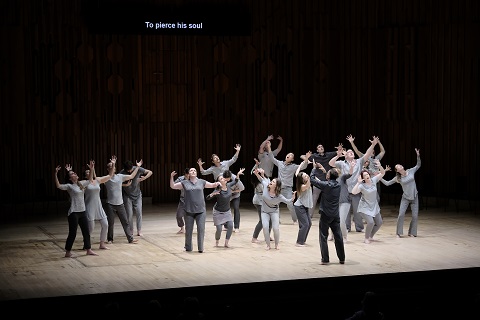 Photo credit: Tom Howard/Barbican.
Photo credit: Tom Howard/Barbican.
I allow that I digress here from the immediate purpose of this review but feel the need to do so in the light of Sellars’ adamant declaration that, “At this point in his life [Lasso] does not need to prove anything to anyone. He is [composing Lagrime] because this is something he has to get off his chest to purify his own soul as he leaves the world. It’s a private, devotion act of writing, but these thoughts are now shared by a community - by people singing to and for each other”. Arguing that the chorus “carries the drama forwards”, Sellars suggests that the work accords with the ancient Greeks’ understanding of tragedy, “which I could also call an African understanding, where an individual crisis is also a crisis of the community”. We hear one man’s thoughts, but it is the community that absorbs them “and has to take responsibility: a collective takes on this weight of longing and hope”.
Okay. Perhaps I should not have read Sellars' 'explanations' in the programme article - an extensive, very informative historical, contextual, musicological and interpretative account by Thomas May - before the performance itself. The latter was much more persuasive.
Three singers are assigned to each of Lasso’s seven vocal parts. The bare-foot singers are dressed in drab grey and mauve legging and slacks, shapeless tunics and ti-shirts. I was surprised to find Danielle Domingue Sumi credited as ‘costume designer’ - especially as conductor Grant Gershon (also barefoot, in black) explains that they strove for ‘clothes that look like they could come out of anyone’s wardrobe’: I thought they had. But, I guess the drab attire reflected the blanched landscape of Peter’s psychological wilderness. And, it allowed the singers to move naturally around and across the Barbican Hall stage.
For, this is what Sellars conceives as a physical and kinaesthetic representation of polyphony which is “totally sculptural”: the “muscular intensity in Lasso’s writing [that] is reminiscent of this expressive language we know so well, visually, from Michelangelo […] the muscle of spiritual energy and striving against pain to achieve self-transformation”.
So, ritualised movements, complemented by surtitles in colloquial vernacular, are designed to conjure the sculptural majesty of Renaissance art and architecture. And, how impressive the Los Angeles Master Chorale were in delivering harmonically and contrapuntally complex madrigals, their voices blending seamlessly and mesmerizingly, all the while adopting geometrical formations, pairings and poses; lying down, and sitting up; standing alone in alienated misery and clutching colleagues in warming consolation. Jim F Ingalls’ lighting followed the psychological modulations, now bleached white, now cool aquamarine, then fertile gold, or warming orange. Oh, yes; they had memorised the entire sequence - nearly 90 minutes of music.
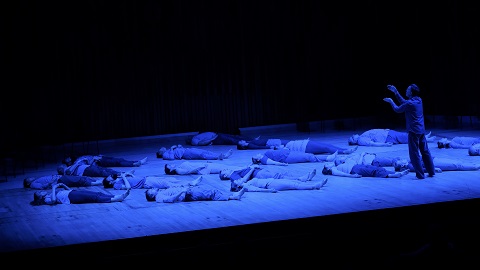 Photo credit: Tom Howard/Barbican.
Photo credit: Tom Howard/Barbican.
Would it have been preferable to have a single voice to a part? Perhaps I would have liked greater presence from the soprano voices? And more shading and variety of tempo? But Peter’s agonies were intensified by the smooth sweetness of the collective lyrical expression. And, the attention to the electric charge igniting the poetical text and detail was masterful, in the madrigalian manner, and physically impressive. At the close of the 15 th madrigal (‘Váttene, vita va’ - Life, get you gone), the chorus lay down, forming a crucifix: “Afraid to die, I denied life,” Peter admits. How could the LAMC sing with such unified ensemble and sure intonation from such a position?
The physicality of the performance was emphasised by sudden silences and shifts, mimicking Peter’s psychological ups and downs. Some were dramatic, others disruptive. I couldn’t help but recall the simplistic clichés of school drama lessons at times. “The deadliest arrows that pierced his heart were the eyes of the Lord, when they fixed on him …” prompted a collective collapse to the floor (and, the singers stayed in tune …). There was much handwringing, chest-clutching, colleague-embracing. When, for the final few madrigals the singers retreated to chairs placed left and right, I felt some relief.
Lagrime closes with a Latin motet, setting the 13th- century French poet Philippe de Grève’s representation of Jesus’s final words: a plea for mankind to behold the Lord’s suffering - ‘Vide homo, quae pro te patior’ (Behold, man, how I suffer for you). The Lagrime, thus, end not with consolation but with rebuke: we do not transcend despair. Fisher argues that ‘Christ’s rebuke … is consistent with a reading of Lasso's cycle as systematic meditation: the Lagrime, after all, concludes with the reflection on sin and does not proceed further into the illuminative and unitive.’
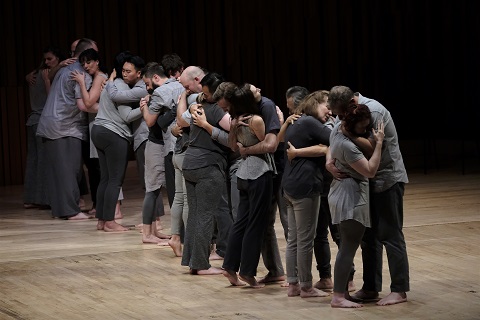 Photo credit: Tom Howard/Barbican.
Photo credit: Tom Howard/Barbican.
So, an accusing voice confronts not just Peter but mankind. But, Sellars interprets such words as spoken in love: the chorus rise from their chairs and embrace one another.
In cathedral naves, the human narrative of such works as Lagrime can be lost; as the polyphony swirls around the vaulted ceilings, words are lost in an embracing blend designed to render the individual receptive to the divine. Sellars focuses on the psychological rather than spiritual, setting the transience of human mortality against the almost unbearable eternal present of the consequences of our actions. And, his reading is not without power and pertinence.
Claire Seymour
Lasso: Lagrime di San Pietro (Tears of St Peter)
Los Angeles Master Chorale, Peter Sellars (director), Grant Gershon (conductor), Jim F Ingalls (lighting designer), Danielle Domingue Sumi (costume designer)
Barbican Hall, London; Thursday 23rd May 2019.
[1] In ‘“Per Mia Particolare Devotione”: Orlando Di Lasso’s Lagrime Di San Pietro and Catholic Spirituality in Counter-Reformation Munich’ Journal of the Royal Musical Association, vol.132, no.2, 2007: 167-220.
Photo credit: Tom Howard/Barbican
Garsington Opera Announces 2020 season and 2019 Paris Performance
Verdi’s Un giorno di regno is directed by Christopher Alden making his Garsington debut and Tobias Ringborg returns to conduct. Richard Burkhard performs Belfiore, Henry Waddington Barone di Kelbar. Mozart’s Mitridate, re di Ponto is conducted by Clemens Schuldt making his Garsington debut with Tim Albery returning to direct. Robert Murray performs the title role. Dvořák’s Rusalka features Natalya Romaniw in the title role with Douglas Boyd conducting and Michael Boyd directing. A revival of John Cox’s legendary production of Beethoven’s Fidelio with conductor Gérard Korsten making his Garsington debut, features Toby Spence as Florestan and completes the season. The Philharmonia Orchestra will play for the Verdi, Dvořák and Beethoven and the English Concert for the Mozart.
Opening nights
28 May Un giorno di regno Verdi - Tobias Ringborg, Christopher Alden
29 May Mitridate, re di Ponto Mozart - Clemens Schuldt, Tim Albery
14 June Rusalka Dvořák - Douglas Boyd, Michael Boyd
25 June Fidelio Beethoven - Gérard Korsten, John Cox
On 19 September 2019 this season’s production of Don Giovanni with principals and chorus from Garsington Opera will be given a semi-staged concert performance at the Théâtre des Champs-Élysées, Paris with the Orchestre de chambre de Paris conducted by Douglas Boyd and directed by Deborah Cohen.
The 30th anniversary season opens on Wednesday 29 May with four new productions - Smetana’s The Bartered Bride, Mozart’sDon Giovanni, the first UK stage performance of Offenbach’s Fantasio and Britten’s The Turn of the Screw. The season culminates with concert performances of Monteverdi’s Vespers of 1610, celebrating the start of a partnership with The English Concert.
Visit www.garsingtonopera.org for the few remaining seats.
image=http://www.operatoday.com/Garsington%20Logo.jpgMay 23, 2019
Karlheinz Stockhausen: Donnerstag aus Licht
This exploration is particularly ripe in Donnerstag aus Licht - an opera attuned to Stockhausen’s reshaping of musical perceptions. Take away the impossibility of what the composer asks us to see and what are you left with? The answer is a mystical cosmos which probes the notion of invisibility in music, the relationship between space and time, of spatial divisions and oscillating perspectives in sound, the fusion of the electronic and the instrumental, and a matrix of ideas that is quite simply ravishing on the ears.
There is a clear argument for suggesting that what Stockhausen does in his Licht operas is to ritualise the concert experience - and this is probably a little more easy to identify in Donnerstag aus Licht, the opera which was written first and which often seems less extravagant than some of those which followed. Benjamin Lazar’s stage direction for this concert performance placed ritual at its epicentre; but his real achievement was to remain entirely - or, at least largely - faithful to the text without swamping it with detail. In what is often quite a personal and autobiographical work from the composer, this semi-staging often made this strikingly clear.
This is an opera which begins and ends outside the theatre, and in one sense this is entirely in keeping with its accumulating mass of thematic ideas, especially in the music Stockhausen composed for it. ‘Donnerstags-Gruss’ begins in the foyer, taking in music we will hear in the opera (those Bali riffs, for example). ‘Donnerstags-Abschied’ which ends it takes place outside the theatre - and proved acoustically rich on this occasion. With five trumpeters playing from high up on the balcony of the Royal Festival Hall, and in the front of the river, it was that very spatial dimension, the ebbing and flowing of perspective, which repeated so much of what you heard in the hall itself.
Act I (Michaels Jugend) is sparsely scored, but it throws us immediately into the triplicate format that Stockhausen rarely deviates from. Eve, Luzifer and Michael emerge - and then merge. ‘Kindheit’ is a trio devoted to childhood - of a mother teaching her son the days of the week, of Luzifer the rote learning of numbers. But it is about remembrance of the past, too. Of soldiers in Nazi Germany, of childhood hunting trips, of a mother’s descent into madness. This is the tragedy of any dysfunctional family - and Lazar’s direction doesn’t shirk from showing us this. In ‘Mondeva’ Eve is restrained by doctors, a needle injected into her neck (almost recalling the horror of forced Nazi euthanasia) and drowned in a bathtub; Luzifer dies on a battlefield. In ‘Examen’ Michael is seen auditioning for entry to a conservatory. Stockhausen didn’t necessarily have to look too far for the plot here because it largely came from his own past. But the complexity is in the shadows he creates - the trio of singers is replicated in a trio of instruments (a trumpet, a trombone and a basset horn) and by the end of the act they have all gone through the incarnations that come to symbolise the fracturing of time in Stockhausen’s world.
It was immediately apparent from the very beginning of Act I how superlative the singing was, how entirely immersed in the roles the soloists were. It was to be a hallmark of the opera throughout. Léa Trommenschlager’s Eve was extraordinarily powerful - but she managed to bridge motherly tenderness with simplicity; when she began her descent into madness you were reminded of Seneca’s Medea - but in almost pocket-sized form. Hubert Mayer’s Michael managed to achieve the impossible - a reduction of his voice into youthfulness and innocence, with just a hint of inquisitiveness. Damien Pass’s Luzifer is a voice centred on a dark, rich bass - but how stentorian he was, almost terrifying at times. One could argue amplification made all these voices more focussed and more forward than they might normally sound, but the upside was their German was impeccably clear.
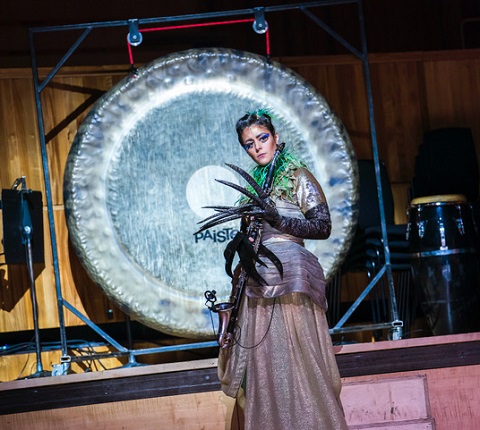 Iris Zerdoud (Eve, basset horn). Photo credit: Tristram Kenton/Southbank Centre.
Iris Zerdoud (Eve, basset horn). Photo credit: Tristram Kenton/Southbank Centre.
Act II (Michaels Reise um die Erde) is unusual in that it is derived entirely from instrumental and electronic forces. Stockhausen thinks somewhat outside the box here in that Michael (this time as a trumpeter) travels the earth in a vast globe while the orchestra are penguins at the bottom of a glacier-covered world. Lazar’s compromise (for that is all he can do) is to have a projector screening the rotating of a celestial orb - almost with the randomness of a dice being thrown - with each stop on this whistle-stop journey being shown. We travel to Cologne (perhaps not that coincidental since it was where Stockhausen was born), New York, Japan, Bali, Central Africa and India. The stops might be brief - but the styles are ever-changing, like a musical kaleidoscope.
This is an act that is about conflict and combat; but it also one that is about a journey entwined in love and eroticism. It is a tour de force of musical creativity, enormous virtuosity and skill - often asking its central characters to play their instruments and act simultaneously as well. Benjamin Lazar’s direction left nothing to the imagination here and this was simply galvanising theatre. In its most basic form, this whole second act is like a vast trumpet concerto though the interplay between instruments really makes it more than this. It opens with Michael’s trumpet (the magnificent Henri Deléger) and Luzifer’s trombone (the equally superb Mathieu Adam) engaged in a duel, sparring centre stage with instruments flashing like foils. A clarinet (Alice Caubit) and basset horn (Ghislain Roffat) buzz around the orchestra, menacingly and waspishly, acting like clowns. Michael duets with a tuba (Stuart Beard) and then slays him like a bear. A love scene is played out between Michael and Eve (here played on the basset horn by Iris Zerdout) though it seems both macabre and heavily ritualised in its love-making with an almost sleazily erotic edginess to it.
The two scenes that comprise Act III (Michaels Heimkehr) are vastly different in scale. ‘Festival’ is for large choral forces and orchestra; ‘Vision’ is like chamber music, focussed mostly on the Michael performers and acts as a kind of summation of all that has gone before. For some, ‘Vision’ can draw one in with its cathartic, hypnotic translucence; for others, it’s a long-drawn out epilogue where the attention flags. Which camp you fall into will largely depend on the quality of the three Michaels - and also on the dramatization which accompanies them through the half-hour stretch this music takes. I think this performance succeeded - perhaps narrowly - in taking us into the cathartic side.
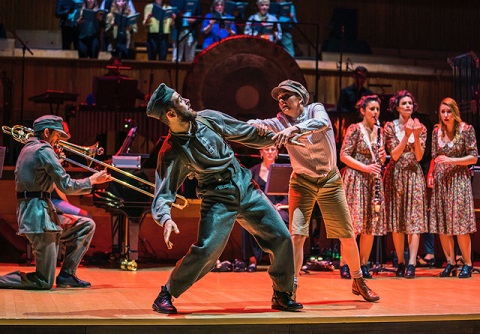 Damien Pass (Luzifer), Emmannuelle Grach (Michael). Photo credit: Tristram Kenton/Southbank Centre.
Damien Pass (Luzifer), Emmannuelle Grach (Michael). Photo credit: Tristram Kenton/Southbank Centre.
Act III didn’t really disappoint in its relative closeness to the text. This act is all about Donnerstag aus Licht in tri-form - Eve, Michael and Luzifer are all, at one stage or another, represented as singer, instrumentalist or dancer. Eve presents Michael with three plants, the branches of which he interprets as rays of light, and there follows three light shows. As the words “then streams come down” appeared on screen so the light show began - multi-coloured lasers, in broken shards, or diamond trellises, a web that stretched across the stage. A tam-tam glowed like a sun (or perhaps a moon), for it to shift into an eclipse. With the words “glass suns” it seemed to be refracted in a mirror, but then became the iris of an eye. Act III is the depiction of Michael returning to his celestial home - and Lazar took this more than literally.
Invisible choruses are heard on tape - but they are then taken up by five sectional choruses divided around the stage. But there is conflict as well. The Michael and Luzifer dancers tumble and fight, soon to be joined by the trumpet and trombone in battle - until Luzifer is vanquished. But he reappears in his human form as tormenter. ‘Vision’ is almost a kind of shadow play, the learning curve through which Michael has travelled on his journey.
There is an undeniable feeling of completeness in Donnerstag aus Licht as you experience it, not least because it seems self-contained as theatre. But, you can also begin to see the disintegration of the structure Stockhausen was to bring to later Licht operas in how the acts themselves are conceived. Benjamin Lazar’s concert staging perhaps isolated this more than one might have expected - the bareness of Act I seemed very hollow against the overwrought franticness of ‘Festival’ from Act III. Much of ‘Festival’ had been very impressive, even if it felt just a little too like a carnival at times - Mathieu Adams’s trombone-playing and tap-dancing Luzifer was simply extraordinary to watch, for example. Henri Deléger’s trumpet-playing Michael was so heroic, the timbre so assured whether the playing was muted or played open, that he was clearly the dominant force here. It’s rare that you hear such colour brought to this instrument, but here it was so variegated. Jamil Attar’s Luzifer (as dancer) was elliptical in his body-shaping, athletically brilliant but with every movement seemed to synchronise with the tenebrous shadows that Pass’s vocal Luzifer breathed like fire.
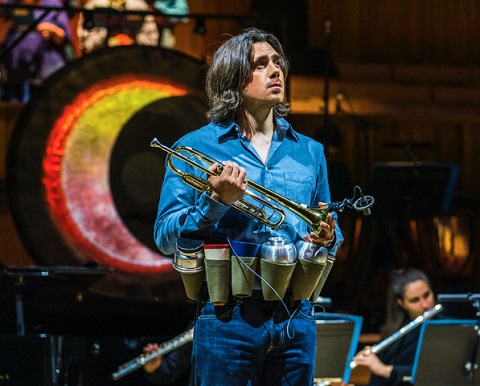 Henri Deléger (Michael, trumpet). Photo credit: Tristram Kenton/Southbank Centre.
Henri Deléger (Michael, trumpet). Photo credit: Tristram Kenton/Southbank Centre.
The three Michaels in ‘Vision’ were a mesmeric trio. One of the difficulties Stockhausen can sometimes over-emphasise in the Licht operas is an indistinct timbre in the vocal line. These are characters at different stages, and they imply different things through a long journey. Hubert Mayer’s younger Michael never wavered in his innocence. Safir Behloul was hugely impressive as the Act III Michael - especially in ‘Vision’ where so much of his singing shifts from German into a kind of Stimmung style of phrasing. Deléger’s often breathtaking trumpet playing just dazzled in its tone colours.
Le Balcon, the London Sinfonietta, the Royal Academy of Music Manson Ensemble and New London Chamber Choir - under the enormously assured and flexible baton of Maxime Pascal - couldn’t have given better support.
It’s rare you hear any opera where there are no weak links - but this performance of Donnerstag aus Licht was pretty faultless on multiple levels. So much of this had to do with the enormous clarity of the music we heard and not the obfuscation of a complex direction. What Benjamin Lazar advocated so strongly for is a design which had theatre, movement and lighting but allowed the conductor Maxime Pascal to illuminate the instrumental music, the tape sounds, the voices and soloists in a way which played to the strengths of Stockhausen’s sonorities. If the Royal Festival Hall can sometimes seem an opaque acoustic, here it was transformed into one which was rather revelatory. The ears were not just once or twice seduced by the mysterious effect of sound - it was a commonplace feature. This was an adventure, rather than simply a performance. Or, as a young man who happened to be passing through the terrace during the ‘Donnerstags-Abschied’ said to me: “It’s really trippy”. He really couldn’t have come up with a better description of what Stockhausen is all about and what this completely memorable evening so amply demonstrated.
Stockhausen: Cosmic Prophet continues on 1st - 2nd June 2019, Southbank Centre
Marc Bridle
Karlheinz Stockhausen: Donnerstag aus Licht
Léa Trommenschlager (soprano, Eve Act 1), Elise Chauvin (soprano, Eve Act 3), Hubert Mayer (tenor, Michael Act 1), Safir Behloul (tenor, Michael Act 3), Damien Pass (bass, Lucifer), Dancers (Emmanuelle Grach - Michael, Suzanne Meyer - Eve, Jamil Attar - Lucifer; Maxime Pascal (conductor), Christophe Naillet (lighting design), Florent Derex (sound projection), Augustin Muller (computer music design), Yann Chapotel (video design, Alice Caubit (clarinet, clownesque swallow Act 2), Ghislain Roffat (clarinet/basset horn, clownesque swallow Act 2), Iris Zerdoud Eve (basset horn), Henri Deléger (trumpet, Michael), Mathieu Adam (trombone, Lucifer), Alphonse Cémin (Michael's accompanist) Simon Guidicelli (double bass, Doctor Act 1), Le Balcon, London Sinfonietta, Royal Academy of Music Manson Ensemble, New London Chamber Choir.
Royal Festival Hall, London: 21st May 2019.
image=http://www.operatoday.com/Donnerstag%20aus%20Licht-RFH-817%20%281%29.jpg image_description= product=yes product_title=Stockhausen: Donnerstag aus Licht, Royal Festival Hall product_by=A review by Marc Bridle product_id=Above: Léa Trommenschlager (Eve)Photo credit: Tristram Kenton/Southbank Centre
May 22, 2019
David McVicar's Andrea Chénier returns to Covent Garden
There are indeed some elements of historical realism. On 17th July 1794, the poet André Chenier was taken by tumbrel from his cell in the Prison Saint-Lazare in the 10th arrondissement, in which he had been incarcerated since 7th March, to what is now the Place de la Nation (known as the Place du Trône-Renversé during the Revolution). Earlier that July day, he had been convicted of being an ennemi du people. He was one of the last people to be executed by Maximilien Robespierre, who was himself guillotined just three days later, during a period of chaotic violence which saw, in one 46-day period alone, nearly 1300 succumb to the guillotine’s slicing finality.
But, the verismo operatic ‘school’ does not equate with realism. Yes, Andrea Chénier gives us some anthems and songs - the ‘La Marseillaise’ and ‘Ça ira’ among them. And, Luigi Illica’s libretto, inspired by the life of the French poet André Chénier (1762-94) does draw upon historical and fictional documents such as the 1819 notebooks of Henri de Latouche, Chénier’s first editor; Jules Barbier’s 1849 drama about the eponymous poet-philosopher’s tragedy; and the Goncourt brothers’ History of French Society during the Revolution of 1854. Some of the numbers, such as the eponymous protagonist’s ‘Un di all’azzurro spazio’, which fuses revolutionary anger with poetical euphoria are derived from Chénier’s works (in that particular case, the 1787 Hymn to Justice). And, Giordano’s opera was a success in its day, perhaps because the battle-cries of the risorgimenti were still ringing in the air, and many a European monarch of the day was a victim of, or anxious about, an assassination attempt.
But the political context, which is so present in Massenet’s Thérèse or Poulenc’s Dialogue des Carmelites is blanched from Giordano’s ‘revolutionary’ opera. This is no surprise: the ‘verismists’ customarily modified history, particularly as their focus shifted from low-life suffering to exotic glamour.
So, it is neither surprising nor inapt that David McVicar’s ROH production for the ROH, revived here for the first time, is more a BBC Sunday-night television period-piece than republican bloodbath, for all the splashes of verisimilitude - one drop-cloth proclaims Robespierre’s damnation of Chénier: ‘Even Plato banned poets from his Republic’.
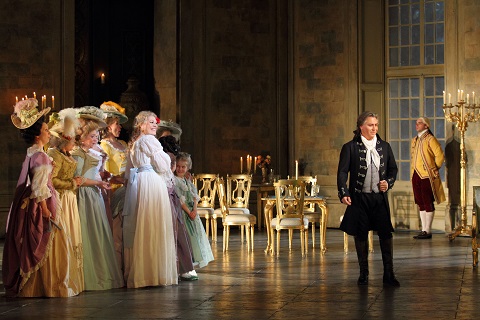 Photo credit: Catherine Ashmore.
Photo credit: Catherine Ashmore.
Though many have denigrated its shortcomings, Giordano’s opera has its merits, not least an economical and swift libretto by Illica, that conjures a dramatic sweep across varied locale and confines its protagonists to ever more oppressive and limiting domains: from ancien régime pleasures to the austere deprivations of prison; from public tribunal to the scaffold.
Revived for the first time, McVicar’s 2015 production tells its tale straight and plumps for designer-realism: even the san culottes look designer-attired. Low-hanging chandeliers glisten; gavottes are danced with an ironic lack of class-crossing awareness. Perhaps there are some political points being made here, but if so they make a weak impression. Robert Jones’s sets impress with their sumptuousness and adaptability, not for their subversion.
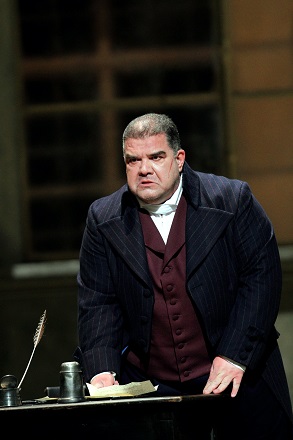 Dimitri Platanias as Carlo Gérard. Photo credit: Catherine Ashmore.
Dimitri Platanias as Carlo Gérard. Photo credit: Catherine Ashmore.
In 2015 , Jonas Kaufmann picked up the quill and defied the interrogation of Robespierre’s terrorists. On this occasion it was the turn of Roberto Alagna, marking his 100th performance at Covent Garden. Despite the present-day dearth of tenors equipped for the challenge, the three arias for Chénier -among the finest written for a ringing Italian tenor - have contributed to the opera’s ‘survival’ in the ‘canon’. And Alagna certainly has the necessary heft and volume. If that was all he delivered, then who are we to complain. The role lies low, yet Alagna had no problem finding the required declamatory pressure and projection in his baritonal range, and the high notes were true, sustained and sure. This Chénier may have been missing a bit of musical ‘poetry’ but there’s a lot to be said for security - even if it isn’t particularly ‘revolutionary’. Alagna’s self-defence at the Terror tribunal, ‘Sì fui soldato’, was a compellingly proud confrontation with death.
Dimitri Platanias communicated all of the footman (and rival of Chénier) Carlo Gérard’s complexity and inner struggles with conflicting loyalties and motives. His manner was a little rugged, but that’s probably true to the role. Platanias had the rawness of an Iago in the more declamatory episodes, while in ‘Nemico della patria’ the baritone wrung every drop from every note.
As Maddalena di Coigny, American soprano Sondra Radvanovsky exhibited a bit of a ‘wobble’ at the climactic highpoints but was wonderfully expressive when singing quietly - which she was not, fortunately, disinclined to do. Her narration of her mother’s tragic death, ‘La mamma morta’, was beautifully executed: compelling, replete with pathos and sincerity. Her duets with Alagna, particularly that at the close of Act 2, were gripping - there was some chemistry here - and dramatically and musically uplifting, as they should be.
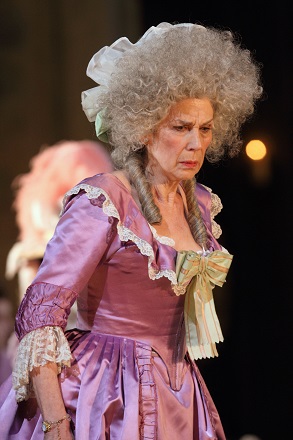 Rosalind Plowright as Countess di Coigny. Photo credit: Catherine Ashmore.
Rosalind Plowright as Countess di Coigny. Photo credit: Catherine Ashmore.
The choral scenes had great energy, and lyrical fervour; and those in the minor roles - Rosalind Plowright as Countess di Coigney (on the eve of her 70th birthday!), Christine Rice as Bersi, Stephen Gadd (as Pietro Fléville) and Aled Hall (as The Abbé) made a strong impression. Conductor Daniel Oren didn’t tap the suavity of the score - the overall effect was as rough and ready as Gérard’s complaints - but he kept things moving along.
In comparison with the political (and social) meltdown that is imminent as our the lower House attempts to negotiate its own ‘revolutionary’ path, this production may seem more reactionary than revolutionary; but, Alagna et al deliver the goods and there’s a sumptuous sheen that glosses historical grimness and gore.
Claire Seymour
Andrea Chénier - Roberto Alagna, Maddalena di Coigny - Sondra Radvanovsky, Carlo Gérard - Dimitri Platanias, Bersi - Christine Rice, Countess di Coigny - Rosalind Plowright, Major-Domo - John Cunningham, Pietro Fléville - Stephen Gadd, Abbé - Aled Hall, Mathieu - Adrian Clarke, The Incredibile - Carlo Bosi, Roucher - David Stout, Madelon - Elena Zilio, Dumas - Germán E. Alcántara, Schmidt - Jeremy White; Director - David McVicar, Conductor - Daniel Oren, Set designer - Robert Jones, Costume designer - Jenny Tiramani, Lighting designer - Adam Silverman, Movement director - Andrew George, Revival Director - Marie Lambert, Revival Choreographer - Colm Seery, Orchestra and Chorus of the Royal Opera House.
Royal Opera House, Covent Garden, London; Monday 20th May 2019.
image=http://www.operatoday.com/%3DRoberto%20Alagna%20as%20Andrea%20Ch%C3%A9nier%2C%20Sondra%20Radvanvsky%20as%20Maddalena%20di%20Coigny%20%28C%29%20ROH%202019.%20Photograph%20by%20Catherine%20Ashmore.jpg image_description= product=yes product_title=Andrea Chénier: Royal Opera House, Covent Garden product_by=A review by Claire Seymour product_id=Above: Robert Alagna (Andrea Chénier) and Sondra Radvanovsky (Maddalena di Coigny)Photo credit: Catherine Ashmore
May 21, 2019
Glyndebourne presents Richard Jones's new staging of La damnation de Faust
The work is a notoriously fragmentary hybrid, as quixotic as its eponymous ‘protagonist’, in which the unstable relationship between the ‘real’ and the ‘imagined’, between the ‘tangible’ and the ‘idealised’, is both the ‘perfect’ embodiment of Berlioz’s ‘meaning’ and irreconcilably opposed to coherent theatrical presentation.
That doesn’t stop people trying. And, any director who tries has fathom how to deal with the work’s innumerable gaps, inconsistencies, multiplicities and conflicts - in the music and in the drama, of style and of mode.
In the music there are symphonic narratives; oratorio-like choruses which comment on events in the past; set-piece marches, dances and songs, some diegtic; operatic recitative and quasi-aria. Sometimes the music takes us into a character’s consciousness and invites us to experience their feelings, as in Faust’s invocations in which the music presents his response to his immediate world, thus communicating his inner life. At other times, such musical empathy is denied us, such as at the start of the work when Faust tells us he can here choruses: ‘All hearts throb to their victory song.’ We do not hear such songs, and we remain alienated from his experience. Then, the music sometimes roots the action in reality: we hear students singing in the streets, military tattoos and fanfares.
The drama lacks tension. Characters sometimes address each other but they do not ‘converse’. Are their relationships real or allegorical? There are flesh-and-blood soldiers and students alongside flying demons and hallucinatory visions. Situations are often unspecified and discontinuous. For example, waiting in vain for Faust’s arrival, Marguerite sings the romance ‘D’amour l’ardente flame’: she could be anywhere, and the moment could be placed either before or after what we have just seen and heard. The action resumes subsequently, with Faust in the countryside. There is no clear chronology or causal relationship.
Ultimately there is no unity; and this is Berlioz’s intent. The real and the imagined meet on the stage and in the score. So, if one stages the work, what should the theatrical stage ‘represent’? An identifiable time and place? Or, a magical ‘anywhere’? Specificity destroys illusion; dream-like passages destabilise reality. Clearly a different, new kind of logic must prevail.
In this new staging at Glyndebourne, Richard Jones gives us his own brand of ‘logic’ but ‘coherence’ eludes him. Before we hear a note of music, dancing demons in lurid body suits and horned masks limber up, as if for a sporting contest; then, a chorus of fiends takes its place in the stalls perched on three sides above the black box set through the cracks of which lurid lights glow. These are, apparently, the students who will observe Méphistophélès’ masterclass in malevolence - though they might as well be spectators at a gladiatorial combat. Or an audience at the theatre, an effect enhanced when Méphistophélès turns to address us: “my devils”. Aloft, they resemble the chorus in an oratorio, commenting on the action; when they descend, they become participants in the drama, effecting ‘now-you-see-me now-you-don’t’ changes of costume which further makes the audience complicit in the deception of Faust.
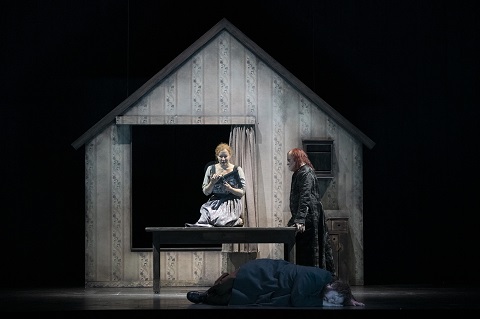 Marguerite (Julie Boulianne), Méphistophélès (Christopher Purves) and Faust (Allan Clayton). Photo credit: Richard Hubert Smith.
Marguerite (Julie Boulianne), Méphistophélès (Christopher Purves) and Faust (Allan Clayton). Photo credit: Richard Hubert Smith.
So far so good: the work’s hybridity is reflected in this conceit. And, if the work is to succeed on the stage it should surely do so on its own terms. But, immediately Jones starts meddling. The entry of a Méphistophélès - a Paganini-like figure, swathed in a black, embroidered trench coast, with lanky red hair and clutching a battered violin case - marks the first of Jones’s ‘amendments’: he has added spoken text, written by Agathe Mélinand and based upon Goethe but with, in Jones’s words, “what’s germane to Berlioz”. Presumably such text is designed to ‘fill in’ the gaps in the narrative but it simply unbalances the ‘theatre v. oratorio’ relationship still further - and it didn’t help that Christopher Purves’ weary opening lines had a few unintended hiatuses.
In a programme booklet interview, Jones also purports to have been influenced by cinema, describing the beginning of his Faust as “like Rosemary’s Baby, in the scene where they all meet in that spooky building on the Upper West Side … [which] looks Satanic”. Similarly, Choreographer and Associate Director Sarah Fahie alludes to “a Blue Angel version” of the Faust legend: Joseph von Sternberg’s 1903 film starring Marlene Dietrich. “Faust was the professor in The Blue Angle and the whole sequence by the Elbe was the club in the film ...” One might agree that Berlioz’s Faust would lend itself to cinematic presentation; one recalls the much-admired 2009 staging at the Met by Québec playwright, director and actor Robert Lepage, whose fusion of sound and image was summed by the appropriately allusive term ‘techno-alchemy’.
But, Jones and his designer Hyemi Shin rely on more mundane means, sliding kitchen tables, blackboards, doors, trees and other props on and off the stage to suggest the different locales visited or remembered by Faust, or dropping them from above: the cottage where Marguerite lives with her mother descends from the flies, as do the three lampposts that form a backdrop for the aforementioned ‘D’amour l’ardente flame’.
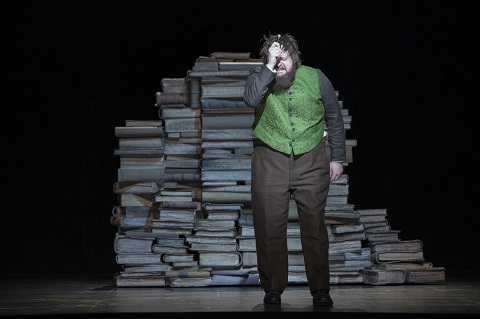 Faust (Allan Clayton). Photo credit: Richard Hubert Smith.
Faust (Allan Clayton). Photo credit: Richard Hubert Smith.
There are plentiful recurring visual symbols: a portrait of the King of Thule, into whom Faust morphs at the close, sporting a scruffy white ti-shirt that spouts blood; a photograph of Marguerite, visible in the military students’ desks as they slam the lids up and down, disrupting the hapless Faust’s lessons on Romantic poetry, and posted on the front page of the newspapers held up by the chorus in the balcony, proclaiming her a Murderess. Jones deliberately bleaches such imagery of any Romantic idealism or lushness: it’s all broken and bereft, ugly and passionless. Even during their ‘love-making’, Faust and Marguerite have to be directed by the demons to slap a buttock, clutch a breast, thrust a hip. Marguerite’s mother shuffles back and forth in pink slippers and a stupor, drugged by the daughter who holds a tankard to her lips and roughly pours poison down her tilted neck.
Berlioz’s Faust is not Goethe’s over-reaching idealist who longs for the knowledge which is truth; instead, he is a man consumed by boredom, a man whose response to music - such as the Easter hymn which draws him back from the suicidal brink - is the sole thing that keeps alive transcendent desires which, however, remain unfulfilled. Scholar Daniel Albright has described this ‘anti-Goethean’ Faust, as a sort of ‘dead frog seeking Prof. Galvani for an electric charge’, and Allan Clayton seemed to embody such a figure at the start: listless, apathetic, heedless of the future. Though introspective, he was pulled from his inward gazing by external objectivities. This is a big sing and Clayton mounted a valiant essay, singing with earnestness and dramatic nuance; but he doesn’t have the high notes for the role, and this further diminished Faust’s already fragile heroic dimension.
The role of Marguerite is not enormously interesting for a singer: essentially passive, Marguerite has to be both sublime and real. While Julie Boulianne conveyed her innocence, it was a purity of a rather vacant kind. And, a reticent one: perhaps intended to infer delicacy and sweetness of character, the effect was disengaging, particularly as Boulianne’s enunciation was so poor. She grew in stature, strength and warmth in the post-dinner-interval Part IV, however.
Purves sang with a lovely seductive colour and nobility of line - not all that apt for the dark fiend, but pleasing to the ear, nonetheless. And, this Méphistophélès was a winner. Marguerite’s apotheosis was presented as a self-deluding indulgence of the disorientated Faust’s imagination; as Méphistophélès nonchalantly conducted ‘his’ choir of angels, it was plain who was calling the shots. As Brander, Ashley Riches dangled a rat before the terrified Marguerite with wicked glee and sang with assurance.
Conductor Robin Ticciati’s approach was perplexing. Carefully, oh so carefully, he gently teased out the nuances but so delicately, making us strain to hear the details, that we barely sensed the desire that the music communicates. The ‘big’ moments sometimes made their mark, but given the restrained, rarified tenor of the whole, the effect was one of discontinuity and disruption, adding to the incoherence of Jones’s conception.
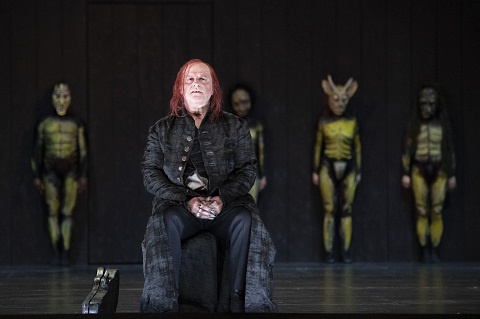 Méphistophélès (Christopher Purves) and Dancers. Photo credit: Richard Hubert Smith.
Méphistophélès (Christopher Purves) and Dancers. Photo credit: Richard Hubert Smith.
But, then, any semblance of theatrical or structural coherence was unfortunately destroyed by Jones’s final coup de théâtre. With the curtain re-raised and Méphistophélès apparently preparing to take his applause, we were halted in our tracks by the fiend. Just when I’d been reflecting that it was a pity that the dancers - who had largely just shimmied across the stage pushing props and set - had had so little to do, Méphistophélès demanded that, after the ‘entertainment’ he had provided, his band of devils should reciprocate. So, now came the Minuet of the will-o’-the-Wisps (which is itself a musical quotation from Méphistophélès’ serenade): a wild dance of Dionysian ascendancy. Berlioz ensures that Faust’s ideal, though unfulfilled, is kept alive at the close by the transfiguration of Marguerite: here, Jones stamped on such an ideal with hob-nailed boots and cruelly confirmed that it was as dead and buried as the dancing demon’s leaps were high and free.
Where does that leave the audience? How are we, like Faust, to be lifted from despair? To what are we to aspire? Jones’s vision was not simply bleak: just as Berlioz’s Faust is worn down by “mon ennui sans fin”, so, by the end of Jones’s production, was I.
Claire Seymour
Faust - Allan Clayton, Méphistophélès - Christopher Purves, Brander - Ashley Riches, Marguerite - Julie Boulianne; Director - Richard Jones, Conductor - Robin Ticciati, Associate Director/Movement Director - Sarah Fahie, Set Designer - Hyemi Shin, Costume Designer - Nicky Gillibrand, Lighting Designer - Andreas Fuchs, London Philharmonic Orchestra, Glyndebourne Festival Chorus, Glyndebourne Youth Opera Trinity Boys Choir, Dancers and Children.
Glyndebourne Festival; Saturday 18th May 2019.
image=http://www.operatoday.com/Glyndebourne%20Faust%20title%20image.jpg image_description= product=yes product_title=La damnation de Faust: Glyndebourne Festival 2019 product_by=A review by Claire Seymour product_id=Photo credit: Richard Hubert Smith
May 20, 2019
Jean Sibelius: Kullervo
Kullervo is a musical act of defiance, written as it was at a time when Finland was resisting efforts by Russia to curb its freedoms. This adds context to the figure of Kullervo himself, a child born into suffering. One can appreciate Kullervo without knowing the Kalevala, but it does enhance meaning. Runes XXXI to XXXVI give Kullervo’s background. He’s cruelly mistreated by an uncle who stole his patrimony. He’s tortured and sold into slavery. When he meets the maiden, he rapes her because he wants what she represents, yet, raised in cruelty, he doesn’t have what we might call “social skills”. Dreams of his long-lost mother have kept him going , so when he discovers that the woman he has violated is his sister, he suffers such guilt that he must offer his own life in appeasement. I’ve often wondered if Sibelius himself realized how daring Kullervo was and, being a worrier, pulled back, as he might have pulled back from the enormity of his conception for the Eighth? Once, Sibelius performance practice presented the composer in sub-Tchaikovsky terms, which really doesn’t do the work justice. Kullervo resets the balance so we can think ahead to the inventiveness of later Sibelius.
The first modern recording took place in 1970, shortly after the rediscovery of the manuscript, with Paavo Berglund and the Bournemouth Symphony. For fifteen years, there was no other recording until Berglund’s second version, with the Helsinki Philharmonic, a darker re-evaluation. In recent years, the work has been critically re-edited, (Glenda Dawn Goss for Breitkopf & Härtel), and performance practice greatly enhanced. Dausgaard’s approach with the BBC Scottish Orchestra captures the audacity in the piece. From a hushed opening, the Allegro Moderato grows with ever increasing impatience, as if it were an Overture to an opera, for a quasi-opera this is. One cannot overestimate the impact of Wagner and his”forest murmurs”, though even at this early stage in his career, Sibelius was seeking a new sound world. Kullervo comes alive with the rhythms of the Kalevala, with its strange, primitive pulse and shamanistic repetitions. Hence the short, sharp intervals in the brass and winds, and the driving pizzicato in the strings, creating a sense of tense, ritualized movement. Even to our ears accustomed to Stravinsky, Bartók and Janáček, Kullervo still sounds primeval. Yet it was written twenty-one years before The Rite of Spring.
Dausgaard also emphasizes the sophistication that lies beneath the ostensible rawness. This is not simply folk tale for grand orchestra but an imaginative approach to dynamics. The contrast between emotional extremes and the tight, staccato-like figures creates abstract narrative tension. It’s as if we’re hearing Kullervo’s nervous heartbeat, pulsating with frustration. In the second movement “Kullervo’s Youth”, the pulse flows strongly, dotted rhythms suggesting forward thrust. Forceful chords suggest alarm, but the pulse returns, quietly but purposefully.
The heart of Sibelius Kullervo lies in the long central movement “Kullervo and his Sister”. A magnificent introduction, where Dausgaard and the orchestra make the string lines shiver : given what is to come this is no minor detail. The Lund Male Chorus enter with sharply focused attack, their lines intoned with menacing portent : this is incantation as much as song. “Kullervo, Karlevon poika !” The pulse in the orchestra surges even more powerfully, evoking at once the speed of the sledge and the implacable force of fate. Quieter moments intensify contrast. Kullervo (Benjamin Appl) and his sister (Helena Juntunen) confront each other. Juntunen’s lines tremble with palpable frisson, yet her every syllable is clearly defined. Her soliloquy “En ole sukua suurta, Enkä suurta, enkä pientä” is a tour de force. Her timbre is at once sensual and tragic, creating the complexity in the character. Woodwinds suggest the calls of birds, or hunting horns, for the prey here is human. Thrusting staccato surrounds Kullervo – testosterone in music – yet his lines curl tentatively : beneath his brutishness, Kullervo is also a victim of forces beyond control. Appl’s delivery is a bit too heroic, since Kullervo is no hero but a very fractured personality. Though he sings well, his need to channel Fischer-Dieskau, with whom he worked for a very brief period, increasingly works against interpretation. Voice is not enough : a singer needs to be himself.
A particularly dramatic “Kullervo goes to Battle”, string lines flying, winds shrill and piercing. In this movement, one can hear the driving sense of propulsion that Sibelius would later use so effectively. Again, passages of tenderness, lit by scintillating winds, add a poignant touch : once, Kullervo was meant for better things. A rousing, exhilarating finale – by seeking death he will at last overcomes shame and find redemption. Thus the return of Chorus in the final movement, intoning solemnly, accompanied by mournful brass. The steady pulse returns, too, though now funereal and hushed. The movement reaches its final, valedictory climax, the orchestra in full flow, the chorus singing with powerful force. “Loppu ainaki urosta, Koulema kovaosaista.” Heard live this can blast you out of your seat. Dausgaard and the BBC SSO demonstrate what a remarkable work Kullervo can be.
Anne Ozorio
image=http://www.operatoday.com/2011_04_23.png
image_description=Hyperion CDA68248
product=yes
product_title=Jean Sibelius: Kullervo, Op. 7
product_by=Thomas Dausgaard, BBC Scottish Symphony Orchestra, Helena Juntunen, Benjamin Appl, Lund Male Chorus
product_id=Hyperion CDA68248 [CD]
price=$19.98
product_url=https://amzn.to/2VQODjD
Hampstead Garden Opera presents Partenope-on-sea
HGO describe Partenope as an ‘opera not so seria’ and it certainly spices seria conventions with gentle parody and self-parody. With history and heroism losing favour with the London public, Handel embarked on a period of experimentation that was to result in masterpieces such as Alcina and Ariodante, and Partenope - described by Handel scholar Winton Dean as an ‘anti-heroic’ opera - was a step in this direction. One of the first works to be produced by Handel’s newly re-organized company, it was premiered on 24th February 1730 at the King’s Theatre.
Given the long reign of the period’s era-defining monarch, HGO’s Victorian setting seems apt. After all, Partenope tells of a presumed episode in the history of the mythical founding Queen of Naples, a monarch who was just as determined as Queen Victoria - who proposed to her beloved Prince Albert on 15th October 1839 - to take matters of love and war into her hands. Pursued by three suitors - Arsace, Armindo and Emilio - Partenope wears the figurative pants, while Rosmira, abandoned by Arsace, literally dons the trousers, disguising herself as Eurimene in order to seek revenge and win back her fickle beloved.
In a sense, the Victorians didn’t just love to be beside the seaside, they invented it. A refuge from everyday routines, the pleasure piers offered new entertainments - acrobats, carousels, Punch & Judy, donkey rides - and the laced-up middle classes relished the chance to indulge in some unbuttoned fun. The stiff-upper-lipped Brits imbibed the sea air and cast off both their crinolines and their inhibitions in the bathing machines. Ladies could flirt with their parasols as they flaunted their new outfits along the promenade. The young chaps could peer through telescopes at women descending into the sea.
And so, during the overture, when Arsace and Rosmira arrived at sands glistening in the glare of the mid-day sun (lighting design by Daniel Carter-Brennan), Arsace was only too pleased to kick off his tight leather shoes, fling aside his tweeds and let his hair down in a game of beach volley-ball with a rumbustious gang liberated by their stripy bathing costumes. Meanwhile, Rosmira slipped out of her high-necked blouse and ankle-length skirt into the leggings and tunic she found conveniently hanging in a nearby changing booth, and assumed her gender-crossing disguise.
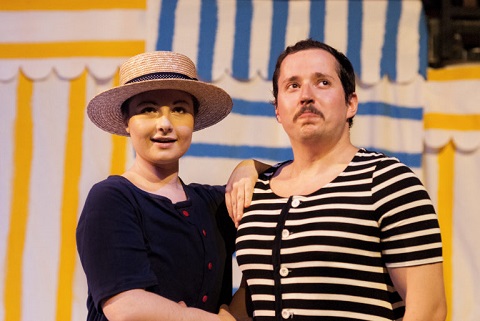 Rachael Cox (Rosmira) and Erik Kallo (Armindo). Photo credit: Laurent Compagnon.
Rachael Cox (Rosmira) and Erik Kallo (Armindo). Photo credit: Laurent Compagnon.
In the event though, for all director Ashley Pearson’s interesting and earnest comments about the concordance between the preoccupations of Partenope and Victorian mores - the clash between ‘strong social morality and a desire to be free’ and between ‘public persona and private desire’ - the action of the opera playfully took its course without the Victorian setting contributing any significant impact or meaning. But, it served an dramatically efficient and visually appealing purpose. Laura Fontana’s set design had the virtues of economy and simplicity: blue and yellow striped bathing tents formed a jolly backdrop to the strip of strand upon which the action unfolded.
Romantic suitors played musical deckchairs as they strove to win Partenope’s heart. Battles with buckets and spades ensued. The azure sky remained cloud-free but the warring characters faced shadows and storms, until female common sense unravelled the romantic knots. The arias ofPartenope are generally briefer than conventional da capo marathons and the scuffles and shenanigans whipped along breezily. I did wonder, though, whether HGO’s decision to present the opera (the original 1730 version) in Italian with surtitles was the right one: given that we had travelled to one of the most English of environs, might not the vernacular have been apt? Particularly as English text would surely have carried clearly in the fairly small Jacksons Lane Theatre, without the need for the tiny surtitle screen perched aloft the orchestral balcony, upon which text was squashed in often miniscule script.
That said, the young cast - current students and alumni from the capital’s music conservatoires - delivered some idiomatic Italian and sang with a convincing grasp of Baroque style. Arsace is the chief object of gentle ridicule in Partenope, but Hamish McLaren’s strong and sweet-toned countertenor won some sympathy for the fickle waverer, communicating Arsace’s growing self-knowledge and genuine suffering in Act 2’s ‘Fatto è Amor un dio d’inferno’ and proffering a beautifully crafted plea for forgiveness in Act 3 (‘Ch’io parta?’).
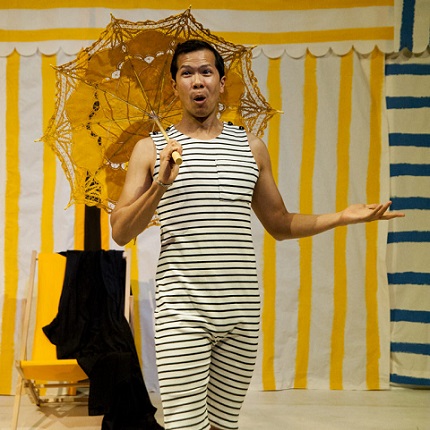 Saran Suebsantiwongse. Photo credit: Laurent Compagnon.
Saran Suebsantiwongse. Photo credit: Laurent Compagnon.
As the object of the men’s affections, Kali Hardwick was a fiery and spirited Partenope. Her characterisation of the be-turbaned beach-queen was sustained and compelling: all sneering eye-brows and dangerously pointed parasols. Her soprano is clear and has a nice glint - though occasionally she pushed it a little hard at the top, and the edge hardened into shrillness. Hardwick has a lot of power at her disposal, but she didn’t always judge the acoustic and sometimes over-sang. Though the coloratura of her first aria wasn’t entirely crisp, her voice later relaxed, the precision improved; Partenope’s Act 2 aria ‘Qual farfalletta’ was especially moving.
Rachael Cox exhibited a lovely warm lower range as Rosmira/Eurimene and didn’t struggle at all with a role that dips down into the deep. She sang with a sure sense of line, musical and dramatic focus, and an overall poise that imbued the feisty revenger with an appealing integrity of spirit.
Erik Kallo’s Armindo was a snivelling cry-baby - the dupe on a comic picture postcard - whose shoulders hunched and drooped with self-pity. Fortunately, his countertenor had more backbone and colour than the character he impersonated! Kallo sang with confidence and accomplishment, as did tenor Peter Martin as Emilio - who comes to do battle with Partenope, and then finds himself enamoured and warring instead with the rival suitors. Martin has a pleasing, agile tenor; he executed the coloratura with aplomb, and alone among the cast had mastered a Baroque trill.
Saran Suebsantiwongse’s stuffed-shirt Ormonte couldn’t quite decide if he wanted to be in on the fun or was disapproving of it, and the baritone delivered his single aria persuasively. The choruses brought the cast together in vigorous ensembles: ‘Viva Partenope!’ was a persuasive choric salute.
Music director Bertie Baigent directed a 13-strong instrumental ensemble playing on period instruments and tuned at Baroque pitch. The French overture is one of stature, and there are several orchestral sinfonias which the young musicians performed with confidence once the tuning had settled down after a slightly ropey start. The long thin balcony above the stage isn’t the most accommodating space, and sometimes the separation of the obbligato woodwind (standing behind Baigent) from the body of strings did not aid ensemble and intonation, but there was plenty of colour and energy.
Despite its general good humour and humorousness, there are serious strains of satire and sexual tension in the opera which Pearson’s production didn’t really tap. But, HGO’s Partenope offers - as the Victorians would have appreciated - levity and laughter: a pleasurable ‘day-trip’ to the seaside.
Claire Seymour
Partenope - Kali Hardwick, Rosmira - Rachael Cox, Emilio - Peter Martin, Armindo - Erik Kallo, Ormonte - Saran Suebsantiwongse, Arsace - Hamish McLaren; Director - Ashley Pearson, Music Director - Bertie Baigent, Assistant Music Director and continuo - Richard Gowers, Designer - Laura Fontana, Lighting Designer - Daniel Carter-Brennan, Fights Director - Matthew Coulton.
Jacksons Lane Theatre, Highgate, London; Friday 17th May 2019.
image=http://www.operatoday.com/Partenope%20Hardwick.jpg image_description=http://www.operatoday.com/Partenope%20Hardwick.jpg product=yes product_title=Partenope: Hampstead Garden Opera product_by=A review Claire Seymour product_id=Above: Kali Hardwick (Partenope)Photo credit: Laurent Compagnon
May 19, 2019
The Operas of Benjamin Britten – Expression and Evasion by Claire Seymour
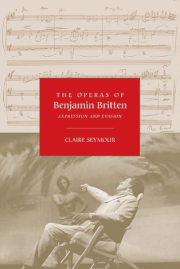 “The delicate balance between private and public communication, and the tension between art as self-expression and art as moral resolution were key concerns in Britten’s music. Seymour examines ways in which Britten’s operas explored and articulated the inherent ambiguity and latent sexuality of music, particularly song, and suggests that Britten’s operas may illustrate his search for a public ‘voice’ which would embody, communicate, and perhaps resolve his private beliefs and anxieties.
“The delicate balance between private and public communication, and the tension between art as self-expression and art as moral resolution were key concerns in Britten’s music. Seymour examines ways in which Britten’s operas explored and articulated the inherent ambiguity and latent sexuality of music, particularly song, and suggests that Britten’s operas may illustrate his search for a public ‘voice’ which would embody, communicate, and perhaps resolve his private beliefs and anxieties.
Analyses of Britten’s operas from Paul Bunyan to Death in Venice, the three Church Parables, and several of the ‘children’s operas’ offer evidence that, for Britten, opera was the natural medium through which to explore, express and, paradoxically, repress his private concerns.”
Henze's Phaedra: Linbury Theatre, ROH
The story of Phaedra’s tragic incestuous desire for her stepson, Hippolytus, as told by Euripides (Hippolytus), Seneca ( Phaedra) and Racine's (Phèdre), has attracted composers as diverse as Rameau and Britten, Paisiello and Massenet, Schubert and Honegger. It was the myth that the then 81-year-old Hans Werner Henze’s turned to for his fourteenth opera, Phaedra, in 2007, five years before the composer’s death.
The freedom with which Henze and his librettist, Christian Lehnert engaged with the Greek myth might be thought to resemble Stravinsky’s and Cocteau’s ‘re-composition’ of Sophocles in Oedipus rex. But, instead of the neoclassical distancing of Stravinsky’s ‘opera-oratorio after Sophocles’, with its Latin libretto (translated from Cocteau’s French by Abbé Jean Daniélou) and cool static quality - the narrator, in contemporary dress, stands apart from the soloists who barely seem to interact with one another - Henze’s and Lehnert’s ‘concert opera’ presents a visceral variation on Euripides et al which embraces both violence and surrealism. And, this terror and strangeness is embraced with engrossing intensity by director Noa Naamat in this production, performed by five Jette Parker Young Artists, in the ROH’s Linbury Theatre.
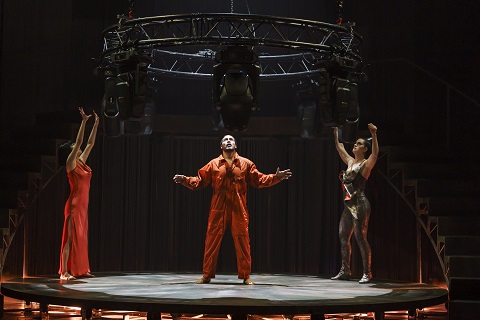 Hongni Wu (Phaedra), Filipe Manu (Hippolyt), Jacquelyn Stucker (Aphrodite). Photo credit: Bill Cooper.
Hongni Wu (Phaedra), Filipe Manu (Hippolyt), Jacquelyn Stucker (Aphrodite). Photo credit: Bill Cooper.
Part One of the opera follows the classical tale - more or less- in which Phaedra, rejected by Hippolytus and driven by all-consuming lust and self-loathing, lies to her husband, telling him that Hippolytus has raped her. Theseus curses his son, and Hippolytus is dragged to his death under a chariot when his horses are frightened by the Minotaur which as been resurrected by the sea-god Poseidon. Phaedra hangs herself.
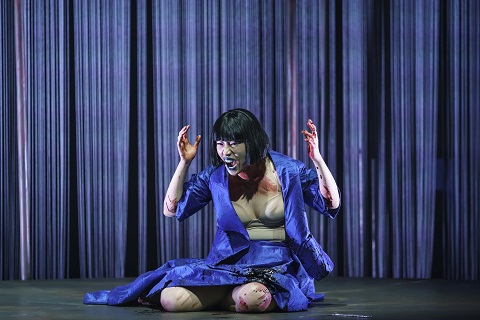 Hongni Wu as Phaedra. Photo credit: Bill Cooper.
Hongni Wu as Phaedra. Photo credit: Bill Cooper.
Part Two takes off into disorientating realms. Drawing on Euripides, and incorporating symbolic allusions to the composer’s own life, Henze and Lehnert make Phaedra and Hippolytus victims in a battle between Aphrodite and Artemis. The latter, to whom Hippolytus has sworn chaste devotion ( rejecting the cult of Aphrodite), resurrects the young man, renames him Virbius and brings him to Nemi in Italy. Phaedra and Aphrodite attempt to drag Virbius back to the Underworld, imprisoning him in a cage. Artemis rescues him and hides him in a cave, but Hippolytus’ identity and consciousness become ever more fragmented and kaleidoscopic, until he is subsumed into nature itself.
Lehnert’s abstractions and poetic elaborations render the strange stranger still, and can be alienating. But, Naamat tells the story with startling directness. The set (by takis) is simple, the characterisation strongly defined and powerfully sustained. A double staircase rises boldly centre-stage, carving slicing curves as it ascends to a platform from which the Minotaur - resurrected in the opening moments with jolts of electric light, horned and armoured like a walking armadillo, skulking with Dionysian dynamism - looks down upon Hippolytus’s suffering. A ribbon-curtain drapes from floor to ceiling, merging with the walls of the Linbury, glistening, twitching, swishing, as the characters appear and retreat. Part One’s bold aquamarine gives way to passionate orange after Hippolytus’s rebirth. Lee Curran’s lighting isolates the characters with starkness; a circular lighting-rig descends chillingly, like a giant iron manacle, to imprison Hippolytus in a cage.
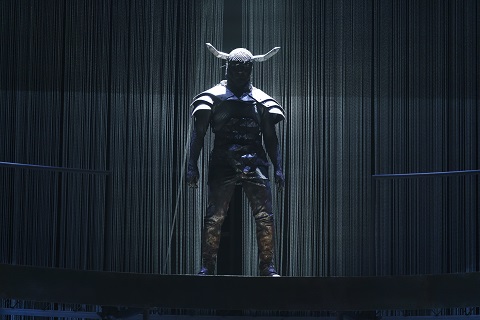 Michael Mofidian as Minotaur. Photo credit: Bill Cooper.
Michael Mofidian as Minotaur. Photo credit: Bill Cooper.
Henze does make use of some Greek oratorical devices, and at times his characters address the audience directly, but Naamat emphasises their interaction with each other, and the cast did battle with fierce, terrifying intensity. Chinese mezzo-soprano Hongni Wu’s Phaedra prowled with seductive menace, her voice darkening and searching for ever more opulent colours as her decline deepened. Wu and Jacquelyn Stucker, as Aphrodite, excelled in the episodes of climactic Bergian lyricism. Stucker’s stage presence was thrillingly intense, emphasising the palpable danger posed by the angry, vengeful goddess.
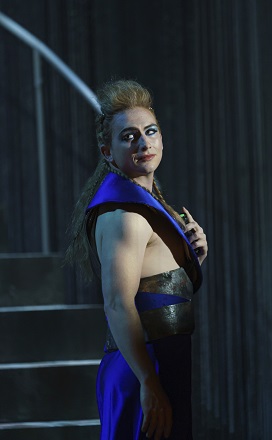 Patrick Terry as Artemis. Photo credit: Bill Cooper.
Patrick Terry as Artemis. Photo credit: Bill Cooper.
The first countertenor to participate in the JPYA scheme, Patrick Terry relished the demands of the role of Artemis, which forced his voice high and low, down to a speaking baritone. His confident performance skilfully captured Artemis’s complexity. As Hippolytus, tenor Filipe Manu, who joins the JPYA scheme in September this year, displayed both nobility and vulnerability, his lyrical outbursts ringing with emotion. Michael Mofidian, silent until the closing moments, sang with a warmth which drew some sympathy for the Minotaur.
The timbral inventiveness of Henze’s orchestral score surprises and scintillates, and the Southbank Sinfonia (supplemented by pre-recorded sounds), conducted by Edmund Whitehead, relished its lyricism and discordances equally. The percussive energy and distortions of the score were tempered by moments of unexpected, haunting beauty, luring one into the misty, dreamlike narrative. For all its storms, earthquakes and destructive dialectics, this Phaedra throbbed with a strange, almost hypnotising energy and life.
Claire Seymour
Henze: Phaedra
Phaedra - Hongni Wu, Aphrodite - Jacquelyn Stucker, Artemis - Patrick Terry, Hippolyt - Filipe Manu, Minotaur - Michael Mofidian; Director - Noa Naamat, Conductor - Edmund Whitehead, Designer - takis, Lighting Designer - Lee Curran, Movement Director - Mandy Demetriou, Southbank Sinfonia.
Linbury Theatre, Royal Opera House, Covent Garden; Thursday 16th May 2019.
image=http://www.operatoday.com/Bill%20Cooper%20title%20image%20for%20Henze.jpg image_description= product=yes product_title=Phaedra: Jette Parker Young Artists perform Henze’s opera in the ROH’s Linbury Theatre product_by=A review by Claire Seymour product_id=Above: Phaedra: Linbury TheatrePhoto credit: Bill Cooper
May 17, 2019
Un ballo in maschera at Investec Opera Holland Park: in conversation with Alison Langer
It’s a smallish trouser role, with two arias (pretty fiendish despite their brevity), and Oscar does not normally make that much of an impact of an audience. Indeed, one reviewer recently ventured that “Oscar, Gustavo’s page, is the opera’s most thankless role. The character can seem chirpy and annoying, but the role requires quick coloratura and quite a bit of glamour-less ensemble singing.”
But, soprano Alison Langer, who is to perform the role of Oscar at Investec Opera Holland Park next month, tells me, without giving away any details or secrets, that director Rodula Gaitanou’s conception of the page will surprise me: that the role has been integrated much more fully into the wider action and that there is “something new” about this interpretation. We’re only a few minutes into our conversation and already I’m intrigued!
Alison is returning to Opera Holland Park for this new production of Un ballo in maschera following her participation in the OHP Young Artists Scheme last year, which saw her win accolades for her performance in the title role of La traviata. One critic remarked that she “made a poised and moving Violetta, bringing out the character’s youth, moving successfully from the brilliance of Act One, through the tragedy of Act Two to a powerful final scene … and in Act One she really made the coloratura part of the performance, rather than a florid add-one”; another that “Alison Langer presented a heroine who was all of a piece, naturally sympathetic and retaining a certain reserve … her vocal interpretation, anchored in the caressing warmth of her middle register, was admirably integrated”. One reviewer concluded, “I have to confess that Violetta's death scene was one of the most moving I have witnessed in a long time.”
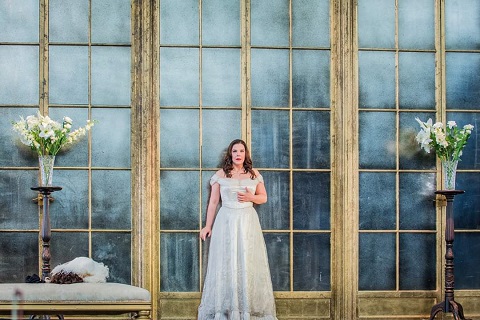 Alison Langer (La traviata, Investec Opera Holland Park). Photo credit: Robert Workman.
Alison Langer (La traviata, Investec Opera Holland Park). Photo credit: Robert Workman.
I ask Alison what she learned and gained during rehearsals for and performances of that OHPYA La traviata? She replies that while she was nervous about taking on the role, her repertoire had been moving in that direction, so she decided to jump in the deep end and go for it. She immediately knew that she’d made the right decision: “There was no ‘pressure’. The Young Artists Scheme offers a sort of ‘safety blanket’, though the participants are absolutely treated as professional soloists.”
Alison explains that she was always made to feel on a par with Lauren Fagan , and as the latter’s understudy she was immensely grateful that Lauren was happy for her to watch rehearsals. So, she had two weeks observing the way the opera was being staged. The Young Artists would work in a downstairs room at St Gabriel’s Pimlico, while the main cast rehearsed above, so she felt really involved in the production. The Young Artists had a full sitzprobe and were able to get used to the Opera Holland Park stage. The YA performances are very much an integral part of the season, and Alison remarks that OHP “make quite a thing” of the YA performance, and that the young singers are encouraged to engage with the audience after the performance.
La traviata did not just offer Alison the chance to perform a new role; it was also the first time that she had covered a role. After her studies at the Guildhall School of Music and Drama, she became a member of the Glyndebourne Chorus in 2015 and in 2016 made her debut in the role of Bridesmaid in Le nozze di Figaro. So, she hadn’t had any experience as an understudy, and La traviata “killed two birds”, so to speak.
The wide stage at Opera Holland Park is quite formidable, and Alison comments that during the dress rehearsal she found herself “over-singing”: “I came off-stage and if felt as if I had sung Violetta twice!” Her teacher had observed the dress rehearsal and advised her that she didn’t need to ‘sing out’ so much; the acoustic at OHP is quite tricky, but the sound does ‘come back’. “It may be ‘outdoors’ but you don’t have to push so much,” she explains.
So, Alison has begun rehearsals for Un ballo from a ‘running start’, though the role itself finds her in unfamiliar waters. “I’m used to playing characters who die at the end of the opera, so it’s strange to find myself as the ‘comic relief’!” she says. She does consider previous productions and interpretations when tackling a new role, but she likes to find new ways of inhabiting the character: “it’s more fun”. She looks back to La traviata and explains that, while she had to ‘fit into’ the production, she couldn’t “just copy what Lauren was doing. I had to do it my own way.” And, arias such as ‘Sempre libera’ offered such an opportunity; Alison was pleased that Rodula Gaitanou gave her ‘permission’ to explore the role for herself.
In this production, she explains, Oscar and Gustavo are very good friends. Alison has enjoyed getting into Oscar’s shoes and developing her understanding of his character during rehearsals. She explains that one might arrive with conceptions about a role, but then find that because the people that you are acting with have different ideas, and you thus need to change and adapt. And, of course, this affects the way that you use the voice to communicate character and feeling.
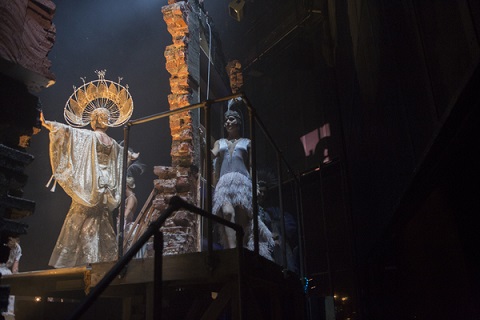 Alison Langer (Young Heidi, Follies, National Theatre). Photo credit: Johann Persson.
Alison Langer (Young Heidi, Follies, National Theatre). Photo credit: Johann Persson.
Alongside her operatic roles, Alison has been performing the role of Young Heidi in Follies, which opened at the National Theatre in July 2017 and ran until January 2018; following January rehearsals this year, it’s returned to the NT and she has performed for eight shows each week since February. When I ask if it feels a bit relentless at times, Alison responds, “Yes, it’s tough, but an experience I would recommend to any young opera singer to build one’s stamina and appreciate the different work ethic required - summoning the energy required day after day, and travelling into London to perform show after show”. The musical theatre world is a totally different terrain to the world of opera, she observes. Not only are the cast performing night after night, but they are also simultaneously auditioning for new roles - often for the same roles, which can be difficult if eight performers are sharing a dressing-room - and, they need to be ‘fresh’ every night! This is where the Assistant Director plays a huge role: if things have gone a little ‘stale’, he/she will need to encourage the cast to find new ways of approaching their roles - “different thought processes”.
There are technical challenges too, such as adapting one’s voice to the microphone. But, Alison had the good fortune to be performing with two ‘Dames’. Alison clearly relished working with Felicity Lott - “she’s so poised and can do some many things with her voice” - and Josephine Barstow: “she’s so dramatic and sings out with real relish and style”. Alison also has nothing but praise for the sound engineers who have only one opportunity to hear a singer, after which they must make adjustments to balance levels. In a way it’s nice to have someone to make necessary adjustments, she says! But, after a morning of rehearsals at OHP, she’s very much aware of the need to listen to her own voice.
Musical theatre also requires performers to sing, dance and act with equal panache. While Alison does have some ballet training - and her dance skills, she tells me, will be put to good use in Un ballo! - she’s had to learn new skills and adapt to the genre. When I ask if she would be keen to do more musical theatre, it’s immediately clear that if Rodgers and Hammerstein, or such like, were to be offered, she would snap up the opportunity. She really enjoyed learning the role of Rose in Opera North’s Street Scene and will participate in a concert performance at West Green of Guys and Dolls this summer.
In fact, in her younger days, Alison might have envisaged a career in musical theatre or as a straight actor. Her family’s music interests were largely classical and she feels that initially she might have been inclined to ‘rebel’ against that. But, she’s clearly delighted to be performing at Opera Holland Park this summer, remarking the quality of the casting at OHP. She is very much looking forward to working with Matteo Lippi, who sings Gustavo, and the whole Un ballo cast. And I, too, am looking forward to finding out about this ‘new’ Oscar!
Un ballo in maschero runs at Investec Opera Holland Park from 8th - 29 th June.
Claire Seymour
image=http://www.operatoday.com/Alison%20Langer%20Victoria%20Cadisch.jpg image_description= product=yes product_title=Un ballo in maschera at Investec Opera Holland Park product_by=An interview with Alison Langer, by Claire Seymour product_id=Above: Alison LangerPhoto credit: Victoria Cadisch
Martin Duncan directs the first UK staging of Offenbach's Fantasio at Garsington
The elements which make up Jacques Offenbach’s Fantasio don’t immediately sound like a bundle of laughs, but there is mirth alongside the melancholy and Martin Duncan will aim to draw forth both, and the operetta’s slightly surreal quality, when he directs Fantasio at Garsington Opera next month.
I begin by asking Martin, who’s directed several of the composer’s works in the past, why he was keen to bring Fantasio to the stage, and he replies simply, “I was asked!” Martin’s production of another ‘unknown’ Offenbach opera, the absurdist Vert-Vert, at Garsington in 2014 won accolades, with one critic describing it as ‘two and a half hours of unalloyed pleasure, excelling in every department’ and another remarking, ‘It’s seldom that I’ve witnessed an operetta by Offenbach as well performed as this’. And, Martin is looking forward to introducing Fantasio to audiences who will have no idea what to expect.
“I like telling people new stories. The audience will have no preconceptions. We’re performing in English [in a new translation by Jeremy Sams], so they won’t be looking up at surtitles, they’ll just be drawn into the story. I don’t want to direct, say, The Marriage of Figaro. I’ve seen it. It’s been done well, and it’s a brilliant opera: I’ve got nothing more to say. I want to tell new stories.”
This production is the first time that Fantasio has been staged in the UK, but not the first time is has been performed, and I ask Martin if he saw Opera Rara’s concert performance in 2013? He didn’t, but he has listened to the subsequent recording (which is in French). Mid-rehearsals at Garsington, he feels that because the cast are now actually acting, the drama inevitably has a greater freshness and energy. In 2013 I found the Act 1 exposition rather lengthy and the music occasionally a little humdrum (there’s quite a bit of self-quotation), but Martin feels that the English text will speak more directly to the audience. In any case, they’ve had to cut quite a bit of the spoken dialogue, not least because the three-act operetta has to be divided into two parts which are separated by the Garsington long-interval. Here, Acts 1 and 2 will precede dinner, with the short final Act serving as a digestif.
And, what does Martin make of the operetta’s ‘story’? It didn’t go down well with the Parisians in 1872 and was withdrawn after just ten performances at the Théâtre du Châtelet. Some have blamed the timing: the aftermath of the Franco-Prussian war, and a climate of growing nationalism and antisemitism, was perhaps not an opportune moment for a German-born Jew to stage a work based on a play that had been set in Munich. Others criticise the libretto which was fashioned by Alfred de Musset’s brother Paul from the former’s original drama, which had itself flopped at the Comédie-Française in 1866.
Martin remarks that it is odd that Offenbach chose to set a text which had been so unsuccessful! But, he feels that Fantasio shares with Vert-Vert a melancholy tenor. Once again, he finds himself staging a funeral, the burial of the eponymous dead parrot which opens Vert-Vert being matched by the slow, sombre funeral chorus which ends Act 1 of Fantasio. But, when people encounter the title, Martin notes, they will anticipate something ‘fantastical’ and there’s plenty of fantasy and fun too. A short YouTube clip of the 2017 Théâtre du Châtelet production reveals a predominantly dark stage, with brief splashes of light, but Garsington’s stage will be a riot of colour and brightness. Martin is delighted to be working again with designer Frances O’Connor - “we think on the same wave-length” - and hopes the set, which will open out at times to create multiple locations - will exude an air of surrealism: after all, Martin smiles, being a member of an audience seated in a ‘floating’ kabuki pavilion, in a country estate garden, watching opera is a slightly surreal experience.
Some operas seem to lend themselves perfectly to the Garsington pavilion, the action inside merging with the surrounding landscape as the light fades, the glass sides flicker and night falls. The action of Fantasio, however, starts at night, necessitating some prudent amendments from Sams, who has transformed Fantasio’s opening aria, ‘Voyez dans la nuit brune’, from an address to the moon, marvelling at its beauty, into an anticipation of the lunar glories soon to come.
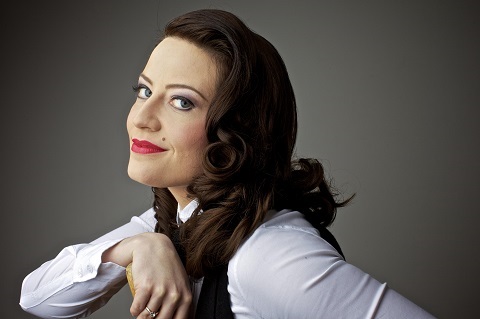 Hanna Hipp who sings the title role in Offenbach's Fantasio.
Hanna Hipp who sings the title role in Offenbach's Fantasio.
And, what sort of a character is the eponymous protagonist, I ask? “He’s a thinker, a scholar, there’s something of the poet about him.” A precursor of Hoffmann? “Yes, Fantasio is often seen as linking the earlier opera bouffes to the later Hoffmann,” Martin comments, which leads him to reflect on the humour in the operetta: “It’s not pantomime. Comedy in opera is difficult. Frequently, singers resort to stock gestures which are not really funny.” Martin began his career as an actor, and those twenty years of experience have obviously taught him much about ‘how comedy works’. He remarks that you “have to do comedy seriously”. Too often actors perform in a way which they ‘think’ is funny, but which isn’t. When he’s directing, it’s not enough for others to say something is comic, it really has to make he himself laugh; but it’s complicated - something that one finds funny one day, may leave one unmoved the next.
Martin certainly has a terrific cast to work with, all of whom, he emphasises, are really dynamic on stage. That morning they have been rehearsing Princess Elsbeth’s virtuosic aria, ‘Quand l’ombre des arbres’, and Jennifer France has been making the twirling runs and leaps sparkle. He’s delighted to be working again with Hanna Hipp, who will sing Fantasio, (she sang the Mad Hatter in Alice’s Adventures in Wonderland which Martin directed at Opera Holland Park in 2013). The Prince of Mantua and his manservant Marinoni, who get the lion’s-share of the comic capers, will be performed by Huw Montague Rendall and Timothy Robinson respectively.
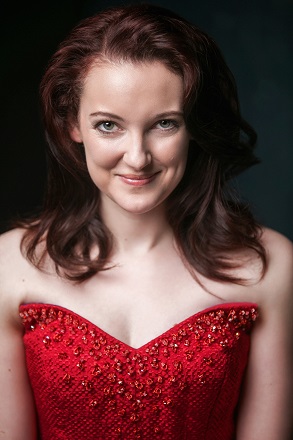 Jennifer France who is singing Princess Elsbeth in Fantasio.
Jennifer France who is singing Princess Elsbeth in Fantasio.
The chorus have a large part to play, too - Martin was surprised when the Garsington Chorus commented that they had more to sing in Fantasio than in The Bartered Bride - and they are fully integrated into the action. Many of the chorus have recently graduated from the country’s conservatoires, and they are “young and enthusiastic”. Indeed, several chorus members are alumni of the Royal Academy of Music and performed in Martin’s Royal Academy Opera staging of Orphée aux enfers at the Hackney Empire in 2017, a production I greatly enjoyed: ‘colourful, camp, [Duncan’s] production cheekily blended pantomime and postmodernism, and burst with vitality […] a zippy burlesque to banish February blues.’
Offenbach seems to have made regular appearances during Martin’s work as a director, and I wonder if this is simply coincidental or whether he feels a particularly strong affinity for the composer’s music? Certainly, he sees Offenbach as being at the start of a line which stretches from opera bouffe through Gilbert & Sullivan and on to the book musicals of the 1940s. The latter literally tell a story through words and music, spoken dialogue alternating with song, just as in an Offenbach operetta. And, Martin continues, listening to Princess Elsbeth’s aforementioned aria he was struck that morning by how closely it resembles Bernstein’s ‘Glitter and be Gay’.
He explains that, as a child, he listened avidly to his grandfather’s collection of G&S LPs, and went on to direct several D’Oyly Carte productions, including HMS Pinafore, a production which, after a successful performance at the Royal Festival Hall in 1999, transferred to the West End the following year, marking the Company’s return to its ‘spiritual home’, the Savoy Theatre. His 1993 Orpheus in the Underworld, a co-production by D’Oyly and Opera North, saw the former venture beyond its staple G&S repertory for the first time.
Returning to Fantasio, Martin remarks that, while there is a bit of self-borrowing, Offenbach’s score is “smashing” and that after a couple of weeks of rehearsals a few earworms have dug in! But, when I ask if there is anything else he’d like to share about the production, he’s reluctant to offer any ‘pointers’: “I find it difficult to comment on a piece until I’ve actually seen how it turns out. A director can explain what they ‘intend’, but then audiences may comment, ‘Well, he didn’t achieve that!’” Martin says he is nervous about a new work until he’s run through it in its entirety; then, he can go back and tighten and tidy up.
Looking ahead, I ask what future ventures Martin has planned? September will take him to Paris, for a grand spectacle, Parade , which will mark the re-opening of the Théâtre du Châtelet, following a two-and-a-half-year renovation project. It’s a bit of a step into the unknown, involving puppets from Mozambique, acrobats, clowns, and spilling out into the spacious square in front of the theatre. Everyone is being pushed out of their comfort zone, he comments. There is some radio work on the horizon too, but no opera: “Perhaps this will be my last opera?” he says, teasingly.
That doesn’t seem likely … but I ask, if he was told he could direct just one more opera, which would he choose. Silence. “I know which ones I don’t want to do!” He’s been reflecting on Janáček of late, and he would also like to re-visit an opera which he directed in Toronto with the Canadian Opera Company in 1991: Britten’s Albert Herring. Another ‘comedy’ with a darker side, and one which is often over-looked, I suggest? Martin agrees: the bitter undercurrents of parochial village life, a mother-son relationship that is quite sinister, and a boy who is not permitted to grow up don’t make for a light-hearted romp. Indeed, Martin’s May Queen jamboree featured that characteristic dampener of English summers, a sudden downpour, raindrops pummelling the roof of the festive marquee and mud sloshing inside. And, I add, just as Fantasio andVert-Vert have a melancholy strain, so there’s a funeral song in Albert Herring too - the faux-sincere threnody that the Loxford worthies sing for Albert, when they fear the worst.
According to the old adage, ‘Laughter is the best medicine’. But, comedy cannot banish all human pain and sadness. And, it’s the plaintive strain beneath the laughter, the elegiac tint that throws a shadow on the comic surface, that Duncan is so skilful at illuminating.
Performances of Fantasio run from 14th June to 20th July.
Claire Seymour
image=http://www.operatoday.com/Fantasio%20Garsington.jpg image_description= product=yes product_title=Fantasio: the first UK staging of Offenbach’s operetta, at Garsington Opera product_by=An interview with Martin Duncan, by Claire Seymour product_id=May 15, 2019
Thomas Larcher's The Hunting Gun at the Aldeburgh Festival: in conversation with Peter Schöne
And, when the operatic adaptation of the Japanese writer’s 1949 novella, The Hunting Gun, by Austrian composer Thomas Larcher and librettist Friederike Gösweiner, was premiered at Bregenz last summer, it was praised for its “clear, powerful text, some striking imagery and a luminous score of great beauty and originality” (The Observer) and its combination of “lyric beauty” and “explosive intensity” ( Financial Times).
Next month, the Bregenz production, directed by Austrian film director Karl Markovics and designed by Katharina Wöppermann, travels to the Aldeburgh Festival. Peter Schöne will perform the role of the elusive Josuke Misugi - a cold, remote but self-assured man who declares his hunting gun indispensable to him, no matter how successful his public and private affairs - and I spoke to the German baritone about the forthcoming production which will mark Peter’s debut in England.
I began by remarking my surprise that Inoue’s sparse, poetic style and introspective narrative have proved apt for operatic setting. In their translation of The Hunting Gun, for the Tuttle edition, Sadamichi Yokoö and Sanford Goldstein describe the loneliness that Inoue depicts as peculiarly ‘oriental’, “related to the weariness of life and its negation”. Certainly, silence and suicide pervade The Hunting Gun, which is dominated by two recurring images. Shoko’s painful vision of a love “unlighted by the sun, flowing from nowhere to nowhere, and buried deep in the earth like an underground stream” is crystallised by her memory of a glass paperweight, its petals “frozen immovably in glass, petals that could not stir if it was spring or autumn, petals put to death”. Then, there is the “snake” which Josuke observes each individual has within themselves, and which his lover Saiko imagines as one’s egotism, jealousy and destiny: “an unbearably sad thing that we carry inside us.”
The Hunting Gun recounts a tragic love triangle through the medium of three letters addressed to Josuke. Penned by wife Midori, his lover Saiko, and her daughter Shoko, the letters take us into the minds of these women as their reflections form a layered dialogue of opposing perspectives and narrative gaps are slowly filled. Midori, bold and rebellious, has kept her knowledge of her husband’s affair secret for thirteen years, but now reveals her awareness of Josuke’s deceit and demands a divorce. When she finally confronts her cousin Saiko, the latter commits suicide by poison after first asking her daughter to burn her diary. The bereaved Shoko, however, reads the journal and, learning of her mother’s affair, feels betrayed and bewildered.
We become privy to the women’s painful private reflections when the letters are sent by Josuke to a poet. Via a framing device, we learn of the unnamed, self-deprecating poet’s journey to the Amagi mountains where his attention had been drawn to a man, gun on his shoulder, pipe in his mouth, who had a strange contemplative air about him: an impression of loneliness. Recognising himself in the poem that the author published about this encounter, Josuke contacts the poet, enclosing the three letters which he trusts the poet will burn.
Despite his pleasure in the poet’s representation of him, and his admiration for “the uncommonly sharp insight of a poet”, Josuke reflects, “It seems to me that a man is foolish enough to want another person to understand him.” And, ironically, the poet explains that the details in the poem - such the type of gun, a Churchill, the finest gun in England - were selected by chance, declaring that “the real Josuke Misugi, the source of my poem, was still unknown to me.” All we have of Josuke are his brief words of address, his calligraphy - “huge characters”, “robust and gorgeous and flowing that threatened to jump off the page” - and the women’s enigmatic and frustrated wonderings. Can such a man be ‘brought to life’, made ‘real’ and ‘knowable’ by the music?
Peter begins by noting that despite the ‘strangeness’ of the novella, in which the characters do not actually speak to one another, there is a strong energy in the text, one which - having travelled in Japan, beyond the cities and into the countryside - he feels is distinctly Japanese: a balance of lightness and blackness, which brings back memories of Mount Fuji to Peter, and which he feels is sustained throughout the novel. One thinks of Buddhist teaching which asserts that pain and passion are inextricably entwined: “To love, to be loved - our actions are pathetic,” writes Saiko, moments before she takes her own life. It’s a dichotomy that Peter finds, too, in Larcher’s music, the post-Mahlerian tonality of which captures both the intense cruelty of the characters’ suffering and the delicate beauty and freshness that one might associate with Japanese sakura.
There is a resilience about Josuke Misugi, Peter notes; he is a strong character, and has had a successful business career, yet the private man has flaws, as do we all. Thus, we can relate to Josuke when, despite have a new, young wife, he loves another woman and succumbs to temptation. He makes a decision which brings the outside world into his own inner life. Larcher’s music is beautiful to sing, Peter says: the legato line enables one to show the strength and shine of one’s voice but there are dark moments too - a wide emotional and expressive bandwidth. Does the music encourage us to sympathise with Josuke, who seems so distant and ineffable in the novella, I wonder? Peter agrees enthusiastically!
When I mention that The Hunting Gun will mark Peter’s debut in the UK, he corrects me: he has actually performed in Scotland twice previously, first in a Youth Orchestra as a teenage violinist, and then at the 2011 Edinburgh Festival, singing songs by Hugo Wolf. Does he still play the violin, I ask? Peter explains that he began playing as a five-year-old, when living in East Berlin. When the Wall came down, many of the musical contexts in which he studied and performed disappeared. His mother looked for other possibilities for Peter to continue his musical development and her attention was caught by a television programme about a boys’ choir.
When she asked the then fifteen-year-old Peter if he wanted to join, he was adamant that he did not! But, she encouraged him to begin singing alongside his ongoing violin studies. As his voice became stronger, it was necessary to make a decision: it would not be possible to do the necessary seven-hours-a-day practice on both violin and voice, so Peter decided to audition for conservatoires in both disciplines and see what the results were. Ten offers to study voice against one for violin determined the future, and he completed his vocal training with Harald Stamm at the University of the Arts Berlin, though Peter did also graduate as a violinist, following studies with Valerie Rubin at the Academy of Music Nuremberg-Augsburg, and still plays violin for pleasure.
Interestingly, he remarks that he thinks that his training as a violinist helps him to read and learn music quickly, and is especially beneficial when he is learning the contemporary music to which he is dedicated, having performed in several world premieres such as Moritz Eggert’s Helle Nächte, Johanna Doderer’s Der leuchtende Fluss and Ichiro Nodaira’s Madrugad.
Peter will spend three weeks in Snape rehearsing The Hunting Gun, but before that he performs in another epistolary-related opera [pi:ps] by Swiss composer Luca Martin, based on the diaries of Samuel Pepys, at the Grand Concert Hall in Solingen. He joined the ensemble of the State Opera House of Saarbrücken last year, and recently took the role of Faninal in Strauss’s Der Rosenkavalier at Saarländisches Staatstheater. But, he explains that a house contract of this nature is both a blessing and a potential problem. There is the ‘luxury’ of regular work, but a company singer’s plans are made for them and sometimes one needs to feel free to listen to one’s inner self about what projects to take on next. Peter seems to be getting the balance right: he will soon dip his toes for the first time into Wagnerian waters, tackling the role of Wotan; and next year will travel to and Theater St Gallen, St Gallen, Switzerland to sing in George Benjamin’s Lessons in Love and Violence.
But, before that there is love and violence of a different kind, in the form of the secrets, sins and inner snakes of The Hunting Gun. What song could be more sad, or perhaps more truthful, than the song of human aloneness?
The Hunting Gun will be performed at the Aldeburgh Festival, 7-9 June.
Claire Seymour
image=http://www.operatoday.com/peterschoene16.jpg
image_description=
product=yes
product_title=The Hunting Gun: the first UK performance of Thomas Larcher’s opera, at the Aldeburgh Festival
product_by=An interview with Peter Schöne, by Claire Seymour
product_id=Above: Peter Schöne
Actress x Stockhausen Sin {x} II - a world premiere
Taking as it root inspiration Stockhausen’s Welt-Parlament, the first scene from his opera Mittwoch aus Licht, Actress (or, Darren Cunningham) has undoubtedly composed something impressively large-scale - though it is clearly neither Stockhausen nor conventional opera. I don’t think you feel short changed because of that, but over its 70 minutes it misses the mark on several fronts while being of quite a high order on others. The revelation here was often to be found in the vocal writing - as obliterated, and pixelated, as it often comes across - rather than the tremendous blocks of sound which ebb and flow with a semi-volcanic force, though they can ultimately seem quite restrained. Cunningham might have looked to the Stockhausen of COSMIC PULSES for that pyroclastic, cosmological power for a more penetrating effect built on his AI and electronica - instead, one often felt trapped beneath a thunderstorm or in a wind tunnel.
Welt-Parlament is not specifically sectional - though the complexity of the layered writing for the voices and the subdivisional way in which Stockhausen modulates rhythm, alternates between registers and creates multiple densities of sound to different choir groups can give it that impression. Actress x Stockhausen Sin {x} II is obviously a more sectional work, and needs to be, given it is almost twice the length. It takes considerable time for Cunningham’s piece to even become a sung work - one could argue if it is an opera it has one of the longest preludes of any - but the debt to Stockhausen when you get to hear the voices is quite apparent. There is a spatial aura, a sense of the unknown about where those voices first emerge from. They finally come, somewhat penitently, in white robes, down the steps of the stalls only to leave the auditorium and then reappear on stage without the robes.
Stockhausen is rather more concerned in Welt-Parlament (as he was in so much of his music for the voice) with exploring the limits to which it could be stretched and used as an instrument; the use of vowel sounds in Welt-Parlament is almost repetitively obsessive. Cunningham has largely avoided this approach - though not entirely because by using AI he has been able to tangibly change the structure of syllables and use linguistics in a specific way. You can barely make out that the words are German - and a libretto might have been more than helpful here. In the end it probably doesn’t matter because the quality of writing for the soloists is very impressive, and it was often indelibly striking enough to resonate. The sheer range of the vocal register is huge, stretching right from the bottom of the scale to the upper-most reaches. Cunningham has kept some of the effects which Stockhausen uses in Welt-Parlament - blocking, long tones, clicking, rushing sounds, the occasional click and the use of kisses. But thematically, this is very close to what Stockhausen intended - even if dramatically it departs significantly from what the composer asks for. I believe only two or three rehearsals may have taken place - but the sheer quality of the singing from Nederlands Kamerkoor seemed to have a lifetime’s experience of this music behind it.
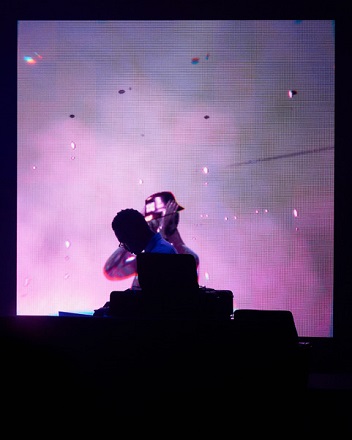 Photo credit: Denelle & Tom Ellis.
Photo credit: Denelle & Tom Ellis.
This is, of course, a parliament about love - albeit one where its people have been abandoned to make way for the brutal pursuit of power. A World Parliament is convened to debate the nature of love and to sign into law a universal treaty which will protect it because life cannot exist or be sustained without love. Like Stockhausen’s original, it is the “meaning” of the word love which is to be debated - though what Cunningham tries to achieve is a broader, more modern discussion that tries to focus on contemporary issues of gender, equality, identity and race. He fuses British and Dutch politicians - and if what emerges is sometimes a little stilted it’s probably because of the unorthodox subject for protagonists a little unfamiliar with debating something other than politics.
The roles of Eve (The Romantic), Michael (The Rationalist) and Lucifer (The Antagonist) are taken from within the choir - and were magnificently sung. However, the sectional - even fragmentary way - in which this work disintegrates, and the way in which the staging is designed, left me with a somewhat different impression as to who Eve, Michael and Lucifer might sometimes have been. A stenographer/pianist (Vanessa Benelli Mosell), the conductor (Robert Ames) and Cunningham himself (with a rather malevolent Darth Vaderish figure on screen behind him) seemed viable shadows of these three key roles.
Staging any Stockhausen work is fraught with difficulty - or, even staging a work which owes a debt to one of his pieces as Actress x Stockhausen Sin {x} II does. I remember the Birmingham Opera Company staging this particular scene in a factory with the parliament perched high up on ladders - a very different vision to what Stockhausen intended which is a glass dome on top of a skyscraper. The approach here in the Royal Festival Hall was ultimately more pragmatic (though it may well be staged slightly differently in the magnificent, and vast, gas building which will house this work’s next performance at the end of the month at the Holland Festival). If the strips of lighting across the top of the stage did give a semblance of the cosmos to it all, the actual parliament seemed as conventional as a session at The Hague. Lighting was almost minimal - especially during the vast opening and closing electronica sections which were played in a kind of tenebrous darkness. A video screen behind Actress proved less distracting than I imagined - though there was something fascinating about watching the pixels collapse until the colours deepen into red and finally it just blanks out.
The most notable weakness in this work is the piano part - which I simply failed to comprehend. Cunningham had mentioned during a discussion before Actress x Stockhausen Sin {x} II’s premiere that the only composer for piano with whom he really identifies is Ravel - and yet, oddly, almost nothing of Ravel came through in the writing for this part at all. This just felt whimsical, added nothing particularly revealing to the work and felt tonally out of context with the rest of it. Actress x Stockhausen Sin {x} II might have left an almost universally favourable impression without this entire section.
I don’t think this is a piece which challenges listeners in many of the ways that Stockhausen’s works do - twenty-five years after Welt-Parlament was composed the dynamics and complexity of that music are out of reach for many composers. Actress x Stockhausen Sin {x} II is an interesting diversion into a multi-format sound world - though perhaps not an opera - but at its best it is an impressive achievement for this young composer.
Marc Bridle
Actress x Stockhausen Sin {x} II , a co-commission with the Southbank and the Holland Festival
Premiere given by Actress, Young Paint, Robert Ames, Vanessa Benelli Moselli and Nederlands Kamerkoor.
Royal Festival Hall, London; 14th May 2019.
image=http://www.operatoday.com/Actress%20x%20Stockhausen%20Sin%20%7Bx%7D%20II%20-%20Denelle%20%26%20Tom%20Ellis%20-013%20%281%29.jpg image_description=Actress x Stockhausen Sin {x} II - Denelle & Tom Ellis product=yes product_title=Actress x Stockhausen Sin {x} II, a world premiere at the Royal Festival Hall product_by=A review by Marc Bridle product_id=Above: Actress x Stockhausen Sin {x} IIPhoto credit: Denelle & Tom Ellis
May 14, 2019
The London Handel Festival and The Royal Opera announce a co-production of Handel’s Susanna starring members of The Royal Opera’s Jette Parker Young Artists Programme
Samir Savant, Festival Director of the London Handel Festival, said: ‘We
are delighted to be working again with the Royal Opera House after the
acclaimed success of Berenice in this year’s London Handel
Festival. The Linbury Theatre is the perfect setting for Susanna,
and we look forward to working with the Jette Parker Young Artists. The
scheme provides outstanding opportunities for young talent, which is in
line with our major aim to encourage and promote the next generation of
performers’.
Director Isabelle Kettle, who joins the Jette Parker Young Artists
Programme from the 2019/20 Season, makes her Royal Opera directing debut
with Susanna. Patrick Milne, who joined the Jette Parker Young
Artists Programme in September 2018, will make his Linbury Theatre
conducting debut with Susanna.
The cast is led by South African soprano Masabane Cecilia Rangwanasha who
takes the title role. Chilean soprano Yaritza Véliz sings Daniel,
Scottish-Iranian bass-baritone Michael Mofidian sings Chelsias and Judge,
and Uruguayan tenor Andrés Presno sings the First Elder. American
countertenor Patrick Terry, who came second in the 2019 Handel Singing
Competition, sings Susanna’s husband Joacim. Terry recently made his Royal
Opera debut singing the role of Arsace in Berenice, the first
co-production between the London Handel Festival and The Royal Opera. The
remainder of the cast are two Link Artists of the Jette Parker Young
Artists Programme: April Koyejo-Audiger and Blaise Malaba, making their
Royal Opera debuts.
The London Handel Festival today also announces three further concerts this
year following the success of the 2019 Festival. The three concerts will
all take place at St George’s Hanover Square, Handel’s own church. On 18
June the London Handel Orchestra and Pegasus Choir perform Handel’s Choice of Hercules and Bach’s Magnificat, conducted by Adrian
Butterfield. The soloists are Joanne Lunn, Anna Dennis, Patrick Terry,
Laurence Killsby and Hugo Herman-Wilson. September sees the annual Handel
Singing Competition showcase, featuring Laurence Cummings and the 2019
finalists. Completing the year is the Festival’s annual presentation of
Handel’s Messiah, performed by the London Handel Orchestra and the
Choir of St George’s.
The full programme of the 2020 London Handel Festival, ‘Handel and the
Hanoverians’ will be announced later this year.
Susanna
cast
All cast are members of the Jette Parker Young Artists Programme, or JPYAP
Link Artists
Patrick Milne conductor
Isabelle Kettle director
Masabene Cecilia Rangwanasha Susanna
Patrick Terry Joacim
Yaritza Véliz Daniel
April Koyejo-Audiger Attendant
Michael Mofidian Chelsias and Judge
Andrés Presno First Elder
Blaise Malaba Second Elder
www.london-handel-festival.com
image=http://www.operatoday.com/LHF%20logo.pngRoyal Opera House announces 17 new productions for its 2019/20 Season
Building on the huge success of Olivier award winning Kát’a Kabanová, The Royal Opera stages the third opera in its Leoš Janáček cycle, Jenůfa, directed by Claus Guth with a stellar cast that includes Asmik Grigorian, who makes her Royal Opera debut in the title role, and Karita Mattila as Kostelnička.
In a co-commission between the Guildhall School of Music & Drama and The Royal Opera, composer Matt Rogers and librettist Sally O’Reilly bring the world premiere of She Described It To Death to the Linbury stage.
The Jette Parker Young Artists Programme welcomes five new singers and one stage director onto the Programme for the 2019/20 Season: their work will showcase world-class talent at its best, both in the Linbury Theatre and on the main stage.
The Royal Ballet draws on its rich cultural heritage while embracing the diverse and contemporary in its 2019/20 Season. The Company unveils five new productions, including four world premieres and co-productions. The Company will celebrate international partnerships and award-winning artists and companies from across the globe.
Alongside classics such as Manon, The Sleeping Beauty and Liam Scarlett’s critically-acclaimed production of Swan Lake, The Royal Ballet joins forces with Birmingham Royal Ballet in a Heritage programme capturing the unique history of the Company and the extraordinary choreographic creativity of Ninette de Valois, Frederick Ashton and Kenneth MacMillan. The Royal Ballet also partners with CCN Ballet de Lorraine to mark the Merce Cunningham centennial in a production of Cross Currents, which will see three dancers from The Royal Ballet join forces with dancers from Paris Opera Ballet and Royal Ballet Flanders in the first visit to Paris in 15 years. The Company is also looking forward to the long-awaited return of repertory classic Coppélia at Christmas, in its first staging by The Royal Ballet for more than a decade.
The Royal Ballet celebrates the contemporary with four world premieres, including new commissions from Liam Scarlett, Cathy Marston and Pam Tanowitz, who makes her Royal Opera House debut. Wayne McGregor presents the world premiere of The Dante Project in collaboration with Thomas Adès, Tacita Dean, Lucy Carter and Uzma Hameed.
The new Linbury Theatre provides a world-class stage for The Royal Ballet and a host of pioneering national and international artistic companies. Female choreographers lead the programme, with new work from Pam Tanowitz, Morgann Runacre-Temple and Sharon Eyal. Mlindi Kulashe makes his choreographic debut with Northern Ballet, and Carlos Acosta’s company Acosta Danza performs new, Cuban-inspired work perfectly suited to the state-of-the-art Linbury Theatre. In a co-production between The Royal Ballet, Rambert and BBC Films, Rambert also perform the world premiere of Aisha and Abhaya, a modern fairy tale with choreography by Sharon Eyal.
The Royal Opera House’s programme of free and ticketed daytime festivals, activities and events encompasses almost 200 separate events over the course of the next Season, and will include free lunchtime performances, the continuation of its popular Opera and Ballet Dots programme (for children aged three months to five years) as well as 11 Family Sundays, which welcome diverse new audiences to our art forms.
The Royal Opera House’s national learning programme, which has engaged more than 35,000 students, 531 schools and 1,255 teachers across the country so far this Season, has bold ambitions for 2019/20. The Royal Opera House will partner with Doncaster through ‘Doncaster Creates’ (Doncaster’s Culture Development programme), Cast (Doncaster’s £22m performance venue) and Doncaster Metropolitan Borough Council. Through the ROH National Learning Programme, the Royal Opera House will work with every school in Doncaster over three years, staging a mass community engagement performance in summer 2020. Alongside this, The Royal Ballet will perform in a gala in Doncaster, and the ROH’s popular Chance to Dance talent development programme will also continue.
Cinema highlights from the 19/20 Royal Opera House season include: The Royal Ballet’s Coppélia, The Sleeping Beauty and Swan Lake, and opera broadcasts featuring world-renowned opera stars such as Jonas Kaufmann (in Fidelio), Bryn Terfel (in Don Pasquale) and Nina Stemme (in Elektra). Free culture returns to communities across the country, from Aberdeen to the Isle of Wight as through our BP Big Screens we share three world class productions free of charge in 19/20. Full details and titles to be announced later this year.
image=http://www.operatoday.com/Royal%20Opera%20House%20exterior%20%28c%29%20ROH%2C%20Photo%20by%20Luke%20Hayes%202018%20%281%29.jpgMay 12, 2019
The BBC Singers and the Academy of Ancient Music join forces for Handel's Israel in Egypt
The first performance, in London on 4th April 1739, was not well-received. Handel made alterations for subsequent performances - initially importing arias from earlier Italian works. When Handel’s amanuensis John Christopher Smith revived Israel in Egypt in 1756, he created a kind of pasticcio from elements from his other late oratorios. But, contemporary audiences seem to have remained perplexed by the daring dominance of the choral numbers. The latter feature was a ‘hang-over’ from the grandeur and magnificence which had been necessary for the original context of Part 1 of the oratorio, which had been adapted from Handel’s Funeral Anthem for Queen Caroline.
Today, Israel in Egypt is most frequently performed without Part 1, commencing with the account of the Exodus - despite the fact that Handel himself retained the Funeral Anthem material for other 1739 performances and never sanctioned beginning with the solo tenor’s recitative ‘Now there arose a new king’ (though the 1756 version mentioned above had omitted the Funeral Music).
And it was this 1756 version that we heard here at Milton Court Concert Hall, performed by the BBC Singers and the Academy of Ancient Music, conducted by Gergely Madaras. Yet, while we had neither the work’s original first part nor, consequently, the full roster of solo arias, we did have a small chorus which, if it struggled a little initially to conjure sufficient strength and majesty, had stamina and spirit, and presented a performance which grew in narrative coherence and dramatic intensity.
The small forces and fairly intimate venue lent clarity, and the BBC Singers’ textual declamation was consistently rigorous. The choral singing initially lacked robustness, however - I found the account by alto soloist Nancy Cole and the Chorus of the cries of Israelites in bondage a little hesitant and diffuse, lacking rhythmic definition - as well as warmth and richness. The balance between men and women also seemed unsettled, and the sopranos’ tone a little thin and reedy at times.
Moments of momentousness underwhelmed: the assault of hailstones mingled with fire should chill the blood, but despite the stirring efforts of timpanist Benedict Hoffnung and the trombonists (Stephanie Mauncey Dyer, Tom Lees and Adrian France), I did not quake or tremble. In choruses such as those presenting the account of the people led ‘forth like sheep’ from a fearful Egypt glad of their departure, Madaras didn’t convincingly build expansive textures. Though dynamic contrasts were effective in ‘He rebuked the Red Sea, and it was dried up’, the choral forces simply seemed too small, lost behind the vigorous orchestral sound. Similarly, Madaras didn’t create sufficient drama from the dissonance and chromatic contortions which depict the ‘thick darkness’ that descends over all the land, and here the organ (Jan Waterfield) overshadowed the pianissimo voices.
Fortunately, the post-interval ‘Moses’ Song’ found the dramatic momentum and energy which had previously been lacking, as Moses and the children of Israel sang the Lord’s praises with persuasive spirit and strength. Madaras shaped the light counterpoint of ‘He is my God’ with skill and a sure sense of direction; the ‘Blast of thy nostrils’ that gathered the waters together made the spine tingle. Tempi were well-measured and created impetus.
To precede the opening recitative, Madaras chose the sinfonia of the Funeral Anthem and here the organ was a strong presence, dark and weighty, while the overall instrumental texture had real character, and sometimes treacly colour and texture. Throughout the instrumental playing was vigorous, the textures transparent, the collective spirit alert and energised.
The soloists were drawn from the BBC Singers. Tenor Tom Raskin informed us at the start of the new Egyptian king who afflicted Israelites and ‘made them serve with rigour’, his tenor fairly bristling with indignation; Raskin worked hard with the text, perhaps overly so at times, in relating God’s despatch of Moses and Aaron and the turning of waters into blood.
Jessica Gillingwater tellingly conjured plagues of frogs and pestilent cattle, the glossy fullness of her mezzo-soprano voice sitting effectively against the spiky string rhythms. The two basses, Jamie W. Hall and Andrew Rupp sang expressively and with focus, the light buoyancy of violins and oboe a welcome complement to their celebratory pomp. Soprano Emma Tring sounded rather shrill and under the note at the close, as she encouraged one and all to ‘Sing ye to the Lord, for he hath triumphed gloriously’.
This was a performance which grew in persuasiveness and interest. If it failed to convince entirely then that probably says more about the oratorio-in-perpetual-progress than about this specific presentation itself.
The performance will be broadcast on BBC Radio 3 on Thursday 16 th May at 7.30pm, and available on BBC iPlayer for thirty days after the broadcast.
Claire Seymour
Handel: Israel in Egypt (1756 version)
Gergely Madaras (conductor), Emma Tring (soprano), Nancy Cole (alto), Jessica Gillingwater (alto), Tom Raskin (tenor), Jamie W. Hall (bass), Andrew Rupp (bass), BBC Singers, Academy of Ancient Music.
Milton Court Concert Hall, London; Friday 10th May 2019.
image=http://www.operatoday.com/Gergey%20Madaras%20Marco%20Borggreve.jpg image_description= product=yes product_title=Israel in Egypt: BBC Singers and the Academy of Ancient Music at Milton Court Concert Hall product_by=A review by Claire Seymour product_id=Above: Gergey MadarasPhoto credit: Marco Borggreve
Measha Brueggergosman: The Art of Song – Ravel to John Cage
It wasn’t just the range of what she sang here – which in itself was relatively unusual, even by London’s standards – it was the level of artistry she brought to it. The voice is uncommonly dark for a soprano - it’s almost mahogany in its rich tones – which made some works on the program, such as Ravel’s Shéhérazade, sound like no performance I’ve come across before. On the other hand, when it came to Duparc’s Phidylé we really could have been listening to Wagner (and I didn’t mind that one bit at all). Her John Cage, however, channelled Cathy Berberian. There are clear traces of her Baptist roots in how she communicates and phrases the texts; but the heavier sonorities of Richard Strauss and Puccini give a firmness to the bottom of the register.
Initially I thought Shéhérazade perhaps lacked the eroticism it sometimes needs. Performances of Ravel’s cycle of three songs with an orchestra often allow a singer to establish a greater symbiosis, a more lyrical and expressive intensity – especially with some of the instrumentation such as the woodwind. Brueggergosman eschewed this kind of approach entirely. Right from the outset, ‘Asie, Asie, Asie’ had that meltingly, vivid darkness that she never really deviated from – the tone was like the most over-indulgent chocolate imaginable. It was undeniably voluptuous, much closer to Rimsky-Korsakov than one might imagine. But when the voice ended stanzas, such as at the end of ‘Asie’, the sense of illumination could be ravishing: how this voice can cast a shadow, a long-breathed umber is very striking. ‘L’indifferent’ is often difficult to pull off – and it doesn’t matter if the singer is with an orchestra or pianist – but Brueggergosman brought a palpable sense of androgyny to it. Ironically, her tone felt a touch brighter here – just enough to set up the impression of ambiguity required. It was just a glimpse into the diaphanous colour which would be a hallmark of her Duparc songs.
Some of Debussy’s songs can give the impression he was writing less for the voice and more for an instrument; their complexity – not to say difficulty – can appear very challenging. The opening of ‘La flute de Pan’ is a near-ideal example of this. The opening lines are punishing; the breath control required can sometimes seem insurmountable. If the title suggests a flute, the way Debussy has written for the singer often takes the voice in great arcs of flutist trills. Brueggergosman managed to sustain the long - almost comma-less stanzas – with a clarity of diction which was enormously poised. This was singing of the highest order. ‘Le tombeau des naïades’ didn’t really prove a problem either. The meaning behind the words might be suggestive of winter, ice and the end of an affair but Brueggergosman brought a more positive note to it. Perhaps the season itself – and even the grief that the end of love brings – allowed you to feel she was deeply inside this music. There wasn’t a trace of wobble or tremolo in the voice.
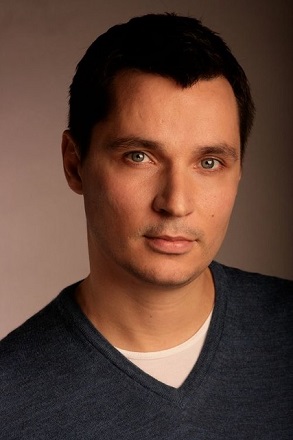 Simon Lepper. Photo credit: Jacquie McSweeney.
Simon Lepper. Photo credit: Jacquie McSweeney.
Henri Duparc – if Debussy tried to eradicate the influence of Wagner - fully embraced him. One of the most tragic of composers, he destroyed much of his music after he suffered a mental breakdown and ceased composing entirely at the age of 37. It’s a double tragedy because the very few songs that exist – just seventeen of them – are magnificent. Many of them positively drip in romanticism, and a kind of Parnassian nostalgia. Brueggergosman’s rich, plush tones – on the surface – seemed entirely plausible for all three of the songs she chose for this recital. However, I wasn’t entirely convinced ‘Chanson triste’ really delved deeply enough into the soul of this music. There is a fine balance between hope and despair here – and it felt just a little too safe. ‘L’invitation au voyage’ can sometimes trip singers up – do they focus on the geography of the text, which turns the song into an early example of Impressionism with its evocation of watery landscapes – or do they focus on Duparc’s ambiguity which stems from him shrouding the music in mystery over rhythms that are all too often unstable? Again, one didn’t really feel absolutely convinced which way Brueggergosman had landed this song either – though there was no denying the voluptuous tone she brought it.
On the other hand, when it came to Phidylé Brueggergosman knew exactly what she wanted. From the opening piano chords – almost like tolling bells – the voice had incredible range – it sometimes felt somnolent, the colour and dynamic range were painted with the broadest of strokes; often this reminded me of Wagner’s Isolde, especially as the voice moves in an ecstatic curve of languid tranquillity to its final, floating climax.
If the first half of this recital had been all about French music – and the influence in song of exoticism, expressionism, impressionism and chromaticism – then the second half was about modernism, jazz, rhythm and cabaret. John Cage might never really have cared profoundly about melody in much of his music but it’s perhaps a touch ironic that for his song, ‘The Wonderful Widow of Eighteen Springs’ he chose as the text for it one of the most lyrical of modernist and experimental books of the twentieth century, James Joyce’s Finnegan’s Wake. It’s easy to see why this book might have appealed to Cage – the very subtext of it, with its immersion into a world of stream of consciousness, and a format which completely deconstructs the nature of sentences, paragraphs and the very use of punctuation itself would seem attractive to a composer hellbent on embracing a radical aesthetic in his own music.
The song itself is based on a single passage of Joyce’s book – on page 556 – and the text of the song is published in upper-case though Cage abandons Joyce’s zero punctuation and inserts various commas and ellipsis. This does lead one to assume that perhaps the delivery of the song is very specifically aimed at a certain volume and pitch, but this isn’t the case - it’s actually composed in three pitches. Despite how it looks on the page, what you get in recital – or what Brueggergosman gave us – is largely a song that resembles modernist plainchant, almost sung in a single vocal register and which doesn’t deviate too much in volume.
What is, of course, unusual about this song is that the piano is played closed. The pianist taps his fingers against the keyboard lid, uses his knuckles against the wood – and basically establishes the rhythm which sets the momentum of the song. I don’t think one could have asked for a more incisive, or better judged performance, of the piano part than the one we received from Simon Lepper here. Cage asks us questions in ‘The Wonderful Widow of the Eighteen Springs’ – what is a song? Who sets the rhythm? What is the nature of music itself? It was certainly wonderful to hear it again in London.
Xavier Montsalvatge, in his Cinco canciones negras, changed the direction of the recital rather completely. These Spanish-accented songs, although written from the perspective of a Caribbean setting, and just after the end of the Second World War, can seem emotionally brutal. In terms of subject matter, they don’t really hold much back about American imperialism pre-Castro in Cuba; musically they can seem rather brutal as well. Brueggergosman brought real Cubanesque grit to all of these songs - and the sultriness was both oppressive and evocative. The brutality of these songs isn’t in the idiomatic writing of the music – rather, it’s in the sheer virtuosity required to sing them. Being able to establish the setting is one thing – but one was left somewhat reeling by the effortless speed with which Brueggergosman took ‘Punto de Habanero’. In ‘Canción de cuna para dormir a un negrito’ it was both the lilting motion to the voice and the slithering tongue work which so impressed. ‘Canto negro’ was a tour de force – a song which Brueggergosman not only sang with such impeccable diction but which she managed to pull off at a tempo like a bullet-train.
William Bolcom’s Cabaret Songs set a very different tone, but were no less remarkable for that. The songs are, in fact, a rather sublime balance of contrasts – often within the same piece. They can be both light-hearted, but seem tragic – they can seem trivial, but really quite sophisticated. It’s easy for a singer to strike a poor balance but Brueggergosman is not one to do that. I think she took much of her cue from the jazzy piano writing – so wonderfully captured by Simon Lepper – and this was especially the case in ‘The total stranger in the garden’. The clarity of her phrasing, the way in which she takes whole paragraphs is so natural you often find yourself not needing to look at the texts at all. ‘Song of Black Max’ is comparatively long – but almost every word was audible. It was a hallmark of Brueggergosman’s recital which was apparent no matter which language she sang in.
Recitals are, of course, a partnership and the pianist for this one, Simon Lepper offered the highest quality playing for Measha Brueggergosman. A recital of this breadth offers challenges for any pianist, but Lepper was never less than impressive in giving each composer a distinctive voice. Perhaps his Duparc most stood out during the first half – the tone was beautiful, those gorgeous chromatic passages highly evocative. Here is a pianist who also brings such colour to what he plays; some of the Ravel was immeasurably exotic, his Debussy floated off the staves and yet he brought an innate sense of understanding to jazz rhythms in music like Bolcom’s and Cuban dash to the Barcelonan music. It would have been easy to have made some of the dissonance in Montsalvatge’s songs emphatically over-edgy but he managed to not do that. His Cage was hypnotic, and despite the fact he probably tried not to draw attention himself I think the reverse might have proven the case – which is perhaps what Cage was rather menacingly, and thought provokingly, driving at in the question about ‘What is a song’?
This was a completely memorable song recital.
Marc Bridle
Measha Brueggergosman (soprano), Simon Lepper (piano)
Ravel – Shéhérazade; Debussy – Chansons de Bilitis, Duparc – Three Songs; Cage – ‘The Wonderful Widow of Eighteen Springs’; Montsalvatge – Cinco canciones Negras; Bolcom – Cabaret Songs.
Milton Court Concert Hall, London; 8th May 2019.
image=http://www.operatoday.com/Brueggergosman.jpg image_description=Measha Brueggergosman product=yes product_title=Measha Brueggergosman: The Art of Song – Ravel to John Cage product_by=A review by Marc Bridle product_id=Above: Measha BrueggergosmanMay 9, 2019
In interview with Polly Graham, Artistic Director of Longborough Festival Opera
But, the answer, so Longborough Festival Opera’s Artistic Director Polly Graham tells me, is that the drama in each of these stylistically diverse operas is focused around a central strong female figure. Moreover, in the course of our discussion another connecting thread emerges: excepting Anna Bolena, the operas all straddle the boundary between the tragic and the comic.
Longborough Festival Opera’s 2019 season marks Polly’s second season in her role as Artistic Director of the festival that was co-founded by her parents, Martin and Lizzie, in 1991. However, while her role was announced in March 2018, Polly did not personally plan last year’s season and was responsible only for the programming of La Calisto this year, so any ‘thematic’ links that have emerged are coincidental and serendipitous.
The 2019 season also marks the first instalment of Festival’s second, four-year Ring cycle, following 2013’s presentation of three complete cycles of Wagner’s epic music dramas. I begin by asking Polly about the preparations for this new Ring, which will once again be conducted by Festival Music Director Anthony Negus, and how it will build upon experiences gained during the 2013 cycle. There’s a real sense of adventure, she explains. The Ring works well in the Longborough theatre for, although undoubted technical challenges remain, the intimate quality of the theatre serves the discursive and often soloistic style of The Ring well; and, it facilitates a good balance between singers and orchestra, foregrounding the drama and the way that the singers use the text. Indeed, technical limitations may in fact be an advantage for, Polly suggests, Wagner demands that we use our imaginations. The composer does not present literal images but encourages us to be forward-thinking: while Wagner does set the action in literal locations, his scenographic demands require the creative team and the audience to travel imaginatively, from Niebelheim to Valhalla, for example.
One element of ‘newness’ in this Ring cycle is that it will be brought to life by a female director, the Royal Opera House’s Head Staff Director Amy Lane. Polly feels that, while Amy insists that her design and concept will not directly promote a ‘feminist angle’, the content of the Ring does draw attention to the strength of the female characters. After all, it is the daughter of a patriarchal god who challenges the system by which the male gods are granted domination through the power of the magic ring, forced by the Nibelung dwarf Alberich from gold stolen from the Rhine maidens.
Similarly, the strength of Donizetti’s eponymous queen is compelling. Ambitious, volatile of temper, prone to jealousy, contradictory and at times capricious, Anne Boleyn has inspired both admiration and contempt. But, whatever her flaws, she was intelligent and courageous, daring to stand up to the powerful monarch who, most now believe, condemned her to death on trumped up charges which were designed to enable him to swiftly dissolve his marriage to the barren queen in order to re-marry and produce the male heir needed to secure the Tudor succession. At her trial Anne showed both humility and integrity: accused of adultery and treason she responded calmly that, while she admitted her weaknesses, and had been an out-spoken and jealous wife, she was innocent of all other charges. She is a fascinating figure who, in her intrigues to oust Henry’s wife of 23 years, Catherine of Aragon, was a catalyst for the religious schisms of the Tudor and Elizabethan reigns and thus, unintentionally, changed the course of English history.
Donizetti’s opera, Polly notes, engages the chorus in a manner completely opposite to the solo-centric Ring; while bel canto opera does present us with starry virtuosi in the central roles, it is the commentary of the chorus on the protagonists’ actions that pulls the drama alive. Longborough has not previously presented bel canto of a serious nature, though Polly gained experience of exploring iconic figures from English history when working on Robert Devereux at Welsh National Opera where she was Genesis Assistant Director for two years; and, the strong creative team her mother Lizzie assembled, including conductor Jeremy Silver and director Jenny Miller who worked together on Longborough’s 2018 production of L’incoronazione di Poppea, have considerable experience of working in the space at the theatre.
Alongside Das Rheingold and Anna Bolena is a new production by director Martin Constantine of Mozart’s Don Giovanni , sung in Amanda Holden’s English translation. Polly speaks of Martin’s awareness of the ‘responsibility’ involved in presenting Don Giovanni in the present time and knows that he will be attentive the issues relating to the behaviour of domineering men and the abuse of power. Donna Elvira is sometimes presented as a ‘hysteric’, while Don Giovanni’s inherent cynicism is brought to the fore; Polly believes that Martin will think about the characters and their relationships in fresh ways.
I confess to Polly that, despite the exciting appeal of this year’s main productions, the production that I am most intrigued by is the 2019 Longborough’s Young Artist Programme production: Cavalli’s La Calisto, directed by Mathilde López and conducted by Lesley Anne Sammons. More women at the helm! And, Polly is sure that Lopez will create something that is thought-provoking and which will skilfully gage the tone of the opera which sits between comedy and tragedy, with the cross-dressing and buffoonery placed alongside the terrible humiliations and appalling treatment endured by Ovid’s heroine. It’s a discomforting tale, says Polly, and she’s sure that Lopez will explore the scornful and pejorative attitudes that men display towards women and the former’s presumptions about their ability to dominate in challenging ways.
Mathilde herself has commented: “Comical and colourful, La Calisto is a complex story of desire; a desire that is recognised and valued when it is male, but shameful and repressed when it is female. The farcical effect often dwells on men dressing up or playing female roles. For our production, the female roles will be performed by female singers, thus replacing at the centre of the piece the passion between two women (Calisto and Diana). Set in a derelict shopping mall, with broken vending machines, trolleys and various female shoppers with different animal heads - ex or future victims of Giove’s sexual appetite - our production will colourfully evoke the absurdity and exhaustion of a very masculine approach to sex and relationships.”
A new orchestration has been commissioned by Lesley Anne which pulls the opera, in Polly’s words, “out of the Baroque sound-box” and creates a more contemporary soundscape, blending recorders and harpsichord with accordion, electric guitar and percussion. While she is excited about this new production, Polly - having now heard the re-arranged score - regrets that she did not commission a new translation too: you live and learn, she says!
She’s certainly keen to develop new ideas and schemes, particularly those that extend the diversity of the Festival’s reach and its connection with its local communities. One such plan was a projected story-telling project involving a clown and which would travel to all farm shows in the Cotswolds. Polly explains that when she first pitched this idea to the Longborough board of Trustees she did not realise quite how long it would take to make things happen, not least because her own work as a freelance opera director takes up “loads!” of her time. But the five-year The Recycled Ring project is underway and will aim to sustain and develop a connection with children over time as they progress through their secondary school careers.
In addition, the Longborough Youth Chorus will again be in vigorous voice this year, meeting every three weeks to work on elements from a variety of operas from across the canon. Next year the Youth Chorus will participate in a production of Janáček’s The Cunning Little Vixen, alongside talented artists at the start of their careers, as part of Longborough’s annual Emerging Artist programme. Finally, a summer school project running from April to July will engage with 50 children, bringing the total number of children LFO engages with per annum through workshops, dress rehearsals and youth choir up to near 1000. Along with their parents and teachers, LFO hosts many of the children for the day at Longborough, where they attend a dress rehearsal performance, following tours and workshops.
Diversity and equality are obviously central to Polly’s aims and values, and I ask her if she is pleased with the way things are developing at Longborough in this regard, and whether there are particular challenges? “We’re moving in the right direction,” she replies. “I’m both satisfied and dissatisfied.” And, she insists that it’s just as important to engage with parents, even grandparents, as it is with the children themselves. There are different but complementary priorities: the children are the future, but its similarly essential to engage the imagination of the adults who provide the wider life-context for those children.
Polly’s independent work in this regard has involved collaboration between Loud Crowd, the company that she established, and Bold Tendencies, a not-for-profit organisation based at the roof-top spaces at Peckham Multi-Storey Car Park, which commissions site-specific art and produces an ambitious programme of live events including music, opera, dance and literature. Last September, Polly presented Viktor Ullmann’s The Emperor of Atlantis at the Peckham venue. Written in the concentration camp at Terezin in 1943, it is subversive satire of the Nazi regime. This production explored the creative energies of those incarcerated in Terezín, and examined how they used the fictional world of their drama to gain power, create joy and humour, and reclaim their humanity.
The performances were watched by large audiences who responded positively, despite the fact that the Car Park’s low ceilings make it quite a difficult space within which to work.
She will direct The Gondoliers at the Welsh College of Music and Drama in July. When I ask Polly about her ‘approach’ to directing, and how she judges the relationship between words, music and staging she is adamant that ‘theatre’ is fundamental: “it has to be dynamic, or there’s no point in spending so much on staging”; the dramatic pulse is essential and it’s important that the conductor sees it from that point-of-view too. “With well known operas, one has a responsibility to tell a story through a story”. She often adds ‘a text’ around the operatic text, providing a context which creates a clear reality and brings the work closer to the audience, aiming to blur the boundaries between the audience and the stage. I remark that this seems to me a perfect description of Polly’s 2018 production of Dido and Aeneas with Blackheath Hall’s Community Opera.
As our conversation draws to a close, Polly remarks, somewhat wryly, that she doesn’t get asked to direct that many ‘classic’ operas: “I usually get the weirder projects.” But, next summer will see her make her directorial debut at Longborough, presenting Monteverdi’s The Return of Ulysses, with Tom Randle in the title role, conducted by Robert Howarth. She’s not willing to offer any clues as to her plans at this stage. But, I come away from our lively, warm and interesting discussion reflecting on one particular comment by Polly: “Sometimes it’s interesting for a director to oppose what the music is doing. It depends upon the piece and the concept.”
Longborough Festival Opera 2019 opens on 5th June. The full 2020 Festival programme has now been announced.
Claire Seymour
image=http://www.operatoday.com/Polly%20Graham%20cr%20Matthew%20Williams-Ellis%202019%20%287%29.jpg image_description= product=yes product_title= product_by=An interview with Polly Graham, by Claire Seymour product_id=Above: Polly GrahamPhoto credit: Matthew Williams-Ellis
World premiere of Cecilia McDowall's Da Vinci Requiem
It has never been just the quality of da Vinci’s output that puts this Renaissance polymath on such a unique pedestal – it’s the breadth of it as well. Vasari had suggested da Vinci was a talented musician – indeed, Emanuel Winternitz published an entire book in 1982 devoted to this subject alone – but it is probably the crossover into science and invention which most fascinated him in relation to music as a subject rather than composition itself.
It’s perhaps an exquisite irony – though I’m unsure whether it’s intended - that in Cecilia McDowall’s new Da Vinci Requiem – of which this was the world premiere – the first quote she should use from a da Vinci source comes from his Codex Atlanticus, dating from between 1478 to 1519, and which in its more than one thousand leaves contains many drawings devoted to musical instruments – some, it should be said, of quite unfathomable complexity. It’s almost a nice touch.
McDowall’s previous choral works – the Stabat Mater, for example - have singled her out as a composer with a gift for combining lyricism and romanticism in her music – it can sound expressive, and often is, though the scale of the invention always looks backwards rather than forwards. You sometimes feel when listening to McDowall’s music that the voice is not an overly distinctive one – and that often felt the case in this new work. Her scoring for the orchestra doesn’t always favour their sound against the chorus – though, I think, this is largely because she tends to evoke a darker, more resonant palate from the lower strings; I rather thought six double-basses was a tad less than ideal, particularly when the double woodwind and brass could often appear so strident. But there were some beautifully constructed moments – the opening of the ‘Introit and Kyrie’ with a penetrating harp gliding through the orchestra was inspired, and the almost relentless beating of the timpani had the hallmarks of McDowall’s profound use of rhythm in her music.
I felt a little unsure about the translations of da Vinci’s codices into English (though the long ‘The Virgin of the Rocks’ was beautifully done in a text by Dante Gabriel Rossetti and was written as such). Rossetti’s poem is the only part of this work which is based on an actual da Vinci painting which the poet had written while standing in front of the work in 1848. If you often felt McDowall was in tune to the underpinned chromaticism and sonorities of the requiem elsewhere in this work, there sometimes felt in this part of it a tendency to pull that apart. Rossetti’s text is dark, painful to read and haunted by death – and yet McDowall strives for music which is quite the opposite – it reaches towards a dissonance (though a restrained one), a jagged edge and the weight in the strings is notably absent. Perhaps because the painting evokes so much of a Milan ravaged by plague, and Rossetti’s text is a response to the revolutions which politicised Europe in the year it was written the music has a distinctly southern Mediterranean feel to it; it almost glowers like a spiky Spanish habanera.
The choral writing – if some of that for the two soloists occasionally doesn’t – is often a model of clarity, especially when the male and female choruses sing divisi. The ‘Benedictus’ invokes the separation of the two – one floating angelically, the other singing in plainchant. That problem with the soloists sometimes straining to be heard was pronounced in the ‘Agnus Dei’ where the soprano voice seemed muffled, unable to soar as she should; less of a problem, because McDowall simply orchestrates it so differently – and more lightly – was the penultimate section for baritone where the voice had clarity.
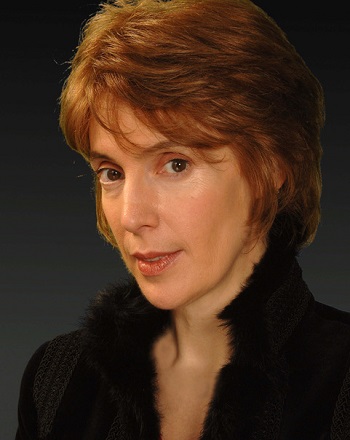 Cecilia McDowall.
Cecilia McDowall.
Kate Royal, the soprano, and Roderick Williams, the baritone, were largely impressive. Royal’s voice can sometimes sound overly small, though the lyrical beauty is often penetrating and rather intense even if the vocal strength to push through the orchestra and chorus is lacking. As a contrast to Williams’s darker, richer baritone, which often towered skyward, the melding of the two voices felt beautifully stated. It’s not often that the two voices sang simultaneously – and when they did McDowall was pointed in drawing out the contrast. In the opening ‘Introit and Kyrie’ Williams evoked the rosary-laced Latin of the opening of the requiem whilst Royal intoned the first statement of da Vinci’s codex. Rossetti’s ‘Our Lady of the Rocks’ is given over to the soprano but I wasn’t really sure that Royal delved too deeply into the text – though in part, I’m not at all sure the music asks for that kind of response either. It’s the one section of this work which seems puzzling to me. Royal seemed challenged by the ‘Agnus Dei’, her voice simply overwhelmed even if she strove for an intensity which wasn’t quite within her reach; Williams in his singing of the final da Vinci codex was deeply responsive to its somnolence and finality.
Perhaps McDowall’s strength has always rested in her ability to write for a chorus, and here the Wimbledon Choral Society were magnificent. Nothing seemed out of place – the women angelic, the men monastic – the intonation and timing exquisite. Neil Ferris controlled the chorus, soloists and Philharmonia impeccably – though perhaps a few lapses in orchestral balance, notably in the sometimes searing brass, seemed a little rogue in places.
The first half of this concert had begun with Vaughan Williams’s Five Mystical Songs. George Herbert’s poems, on which the composer based them, are simple and the music reflects this. Despite Vaughan Williams’s famed atheism – and later agnosticism – what he composed for them can sometimes sound quite the opposite, though they never really strike one as having any real intimacy with religion. But Roderick Williams, as he was to subsequently be in the Da Vinci Requiem after the interval, is never less than a revelation. He probably brought a greater sense of personal meditation, reflection and intuitive intimacy to the texts than one might normally experience in a performance of this music – and which it certainly needs. His intonation and impeccable phrasing borders on the luxurious at times – just as the richness and depth of his baritone cuts through an orchestra with impressive strength.
Such hallmarks were equally on display in Martin James Bartlett’s superb performance of Ravel’s Piano Concerto in G major. What was so notable about this performance was how inside the music this young soloist was – this is a work which whips back and forth in a geometric pattern of pianistic invention. The mastery of the jazz elements, the dizzying keyboard trills, the shifts from major to minor keys were very impressively navigated. But it was fascinating during the Adagio to watch Bartlett almost disappear completely as he bent his head to almost touch the keyboard. There was no lack of freneticism in his playing, but neither was there a lack of skill in bringing off the work’s lyricism and expressive elements either.
Marc Bridle
Kate Royal (soprano), Roderick Williams (baritone), Martin James Bartlett (piano), Neill Ferris (conductor), Wimbledon Choral Society, Philharmonia Orchestra.
Royal Festival Hall, London; 7th May 2019.
image=http://www.operatoday.com/DVR_end_concert_andy_langley%20%281%29.jpg image_description= product=yes product_title= Cecilia McDowall’s Da Vinci Requiem (world premiere) at the Royal Festival Hall product_by=A review by Marc Bridle product_id=Above: Da Vinci Requiem at the RFHPhoto credit: Andy Langley
May 7, 2019
Mahler: Titan, Eine Tondichtung in Symphonieform – François-Xavier Roth, Les Siècles
This allows us, as Anna Stoll Knecht and Benjamin Garzia of the Médiathèque Musicale Mahler note, “to follow the genesis of this first large-scale work, (which) opens the doors of Mahler’s artistic workshop at a crucial moment in the creative process". Mahler extensively revised his very first version, premiered in Budapest in 1889. For the Hamburg performance, in October 1893, he described it as "The Titan, A Tone Poem in the form of a symphony" in five parts, each with programmatic titles. In Weimar, in June 1894, he adapted it further, so it was no longer a symphonic poem but a ‘symphony’. While the text accompanying the Weimar performance retained the programmatic titles from Hamburg, the score was now devoid of them, heralding the transition from symphonic poem to the Symphony in D major, as the Berlin version from 1896 was to be called. Donald Mitchell has compared this working process to building with scaffolding, which is later removed to reveal the finished structure. Even after publication, Mahler reserved the right to make further revisions, continuing to do so until the last performance he conducted, in New York in 1909.
While the edition of the score is of great interest, the performance itself is superb, definitely worth hearing on its own merits. Roth has conducted the standard version many times, but here he conducts Les Siècles "sur instruments d’époque", using instruments of Mahler's time. They use instruments which would have been used in the pit of the Vienna Court Opera and the Musikverein, and selected Viennese oboes, German flutes, clarinets and bassoons, German and Viennese horns and trumpets, and German trombones and tubas. "These instruments are built quite differently from their French contemporaries" writes Roth. "The fingerings, the bores and even the mouthpieces of the clarinets were completely new to our musicians. The wind instruments have a singular quality that exactly matches the rhetoric of the Austro-German music of that time, with a darker colour than that of the instruments then used in France. Perhaps they are also more powerful, and their articulation is a little slower. In the case of the string section, each instrument is set up with bare gut for the higher strings and spun gut for the lower ones. Gut strings give you a sound material totally different from metal strings, more highly developed harmonics, and incisiveness in the attack and articulation." Each instrument is individually identified, as are the players.
This approach to instrumentation infuses the performance, giving it an invigorating sense of vitality. Given that Mahler was embarking on new adventures, Roth and Les Siècles capture the spirit of the piece with extraordinary expressiveness. The first movement of the first part, 'Frühling und kein Ende' comes alive from the start. Period horns emerge from the rustling strings to create an earthiness entirely in keeping with the idea of Spring and burgeoning new growth. The woodwinds call the "kuck-kuck" motif with such purity that they sound like birds. The movement builds up to a crescendo so joyous that it seems to explode with energy and freedom. In the song "Ging heut’ Morgen über’s Feld" the protagonist hears the birds sing "Ist’s nicht eine schöne Welt? Ei, du! Gelt? Schöne Welt!". Though the song ends on a minor key, Mahler ends the movement with a punch of an exuberant timpani.
In the past, the 'Blumine' movement has been attached to what is now known as Mahler's Symphony no 1, even though the composer himself pointedly removed it. The result is neither sympohony noit "symphonic poem" but a hybrid. Mahler dropped the piece, finding it too "sentimental", a "youthful folly" ((Jugend-Eselei), and it does inhibit the flow of the symphony. 'Blumine' includes passages from "Der Trompeter von Säckingen", incidental music to a play he'd written in 1884. Hence the prominent trumpet part, which here is particularly beautifully played : almost as evocative as the post horn in Mahler's third symphony, though 'Blumine' is a much slighter piece. The mellowness of the instruments Les Siècles employ enhances the section's function as a throwback to past times. There's not much point in including it as an add-on these days when the full symphony is is so well known, so it's better to hear it in proper context, as this new edition offers. It operates as an andante to the much more sophisticated scherzo of the (third) movement here. Originally titled "Mit vollen Segeln", it's played here with ebullient verve : the trio part earthy Ländler, part cheeky waltz.
Part Two of the Titan was titled Commedia humana (Human Comedy). It begins with "Gestrandet", a Totenmarsch inspired by an illustration of hunted animals following the cortege of a dead huntsman : the worldly order of power in reverse. Again, the usee of instruments Mahler himself would have known adds colour to this performance. The rhythms reference the folk tune Bruder Jakob: hence Mahler's comment that it should sound quaint "as if slaughtered by a bad orchestra". Ländler values again, with echoes of the motif 'Auf der Straße steht ein Lindenbaum' from the song "Die zwei blauen Augen von meinem Schatz" with which Lieder eines fahrenden Gesellen ends. The dark humour of this Dantesque "human comedy" comes to the fore in the last movement, an allegro furioso originally titled "Dall'Inferno". Such energy in this performance - proof that instruments of the right period can sound powerfully animated. Roth and Les Siècles perform with intense conviction. Each section of the orchestra sounds alert, aware of what's evolving in the music : the triumph of some heroic force of life, blasting away death and venality. Hence the term "Titan", refering to Jean Paul's Bildungsroman, where wisdom is won through fire, in search of higher purpose.
Anne Ozorio
image=http://www.operatoday.com/Mahler_1_Roth.png
image_description=Harmonia Mundi HMM905299
product=yes
product_title=Gustav Mahler: Titan, Eine Tondichtung in Symphonieform
product_by=François-Xavier Roth, Les Siècles
product_id=Harmonia Mundi HMM905299 [CD]
price=$16.99
product_url=https://amzn.to/2LsTyCw
May 6, 2019
Aribert Reimann’s opera Lear at Maggio Musicale Fiorentino
Nearly four decades later, Reimann’s opera has become a modern classic. It now seems to me both easily accessible and deeply moving; thus, I welcomed a chance to attend the second of three performances at this year’s Maggio Musicale Fiorentino. As is often the case with modern operas, even established ones, about 5% of the seats were empty, while another 5% of the audience slipped out at intermission. Those who remained, however, rewarded the performers enthusiastically—and were themselves rewarded when the 83-year old composer himself took a bow. It is a sign of how times have changed when elderly Florentines leave such a performance enthusing “bella, bellissima!”
This production reassembles the conductor, sets, stage team, and most of the cast of a 2016 run in Paris. Danish baritone Bo Skovhus owns the title role these days. (You can view his interpretation, in slightly fresher voice compared to what I heard in Firenze, on this DVD from Arthaus Musik DVD of a 2014 Staatsoper Hamburg performance.) His approach to the role is clear, forceful, well-enunciated and projects a coherent character. It is, of course, always unfair to compare any singer to Dietrich Fischer-Dieskau—especially in this case, since Reimann wrote Lear expressly for him. Yet doing so highlights a critical difference in emphasis. Fischer-Dieskau approaches the part with the Lieder singer’s understatement and subtlety, thereby underscoring the traditional view that Shakespeare’s Lear is an old man, tired and infirm at the start and dead at the end. This interpretation also made the most of the singer’s own advancing age: it was the last operatic part Fischer-Dieskau would record. In 1982, I remember being surprised that his aging voice, never the largest, sounded so small in the theater.
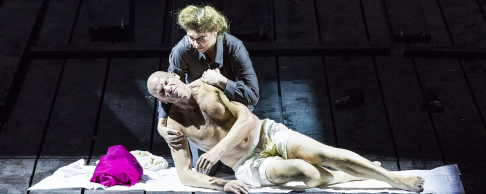
Skovhus, by contrast, is a large man who radiates good health—not to mention possessing some impressive pecs, which he displays for most of the show. He also prefers to use his resonant voice at forte. Thus, when bad things befall him on stage, he tends to comes across as a well-meaning Hollywood superhero temporarily laid low. One feels little of the human frailty and loneliness so central to Shakespeare’s Lear and particularly emphasized in Reimann’s opera, which purposefully drops “King” from the title to stress that he is an everyman. Watching Skovhus in this role, his musical mastery somehow never quite dislodges my expectation that he will somehow prevail in the final reel.
Two of the three daughters did not appear in the Paris cast. Spanish soprano Ángeles Blancas Gulin brings a powerful and steely tone to the role of Gonderil. The fact she seems so monochromatically brash may lie partially in the way Reimann wrote the role. Two Swedish sopranos, Agneta Eigenholz and Erika Sunnegårdh, add much. Eigenholz possesses a pretty and well-focused voice, though perhaps could do more to project Cordelia’s own painful self-realizations in the penultimate scene—Várady being the unfair comparison here. Sunnegårdh misses some chances to make more of the wild coloratura Reimann uses to express Regan’s hysteria: to judge by tapes, her voice has grown heavier since Paris three years ago.
British counter-tenor Andrew Watts portrays Edgar (aka Tom) with subtle inflection and a fully rounded sound, if occasionally wavering diction. Young Turkish Baritone Levent Bakirci, trained in Philadelphia and working his way up in the German system, cuts a dashing—if oddly young and good-looking—character as Gloucester, and sings with precision and a clear sound, particularly at the top of the voice. This is a singer to watch. German actor Ernst Alisch plays the speaking-singing role of the fool with astonishing vividness, subtlety and power—not least since he is 79 years old. Kor-Jan Dusseljee, Frode Olsen, Derek Welton and Michael Colton round out the cast, all singing in the full-throated manner this production treats as the norm.
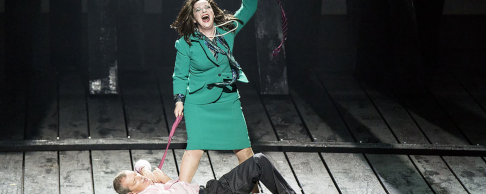
Reimann’s thick and complex score demands much of both conductor and orchestra. Fabio Luisi, the musical director of the Maggio Musicale, conducts—today less than 24 hours after leading a demanding orchestral program of Schubert and Mahler. Luisi’s approach is clear and detailed, and he drew excellent playing out of the orchestra—even if the tone sometimes seems to lack the full measure of delicacy, transparency and voicing, qualities one normally associates with Luisi. Some of this may be due to Firenze’s relatively new opera house, the acoustics of which I am still getting to know, or perhaps the orchestra, which otherwise responded brilliantly.
Calixto Bieito has achieved controversial celebrity in the opera world with a “throw everything at the wall and the s--- will stick” approach to stage direction. Here, uncharacteristically, he restrains himself during the first third of the work: a closed, narrow and essentially unchanging set amplifies the sound and invites the audience to trace intimate links among characters. At some point, however, Bieito begins to throw in assorted post-modern clichés: a slowly deconstructing set that diffuses the sound, Luis Buñuel-style projections of farm animals and eyeballs, disrespect for the “fourth wall,” a bloody half-suicide unmentioned by Shakespeare, some dominatrix play with neckties, and a full-frontal nude male of prodigious endowment. At the end, true to cliché, Lear does not die but sits quivering in mute madness.
Little of this illuminates Shakespeare’s text. If Bieito’s focus on sex and barnyards is meant to underscore humanity’s animalistic side, as one assumes, why do the shenanigans on stage began just at the moment when both Shakespeare’s play and Reimann’s music turn back inexorably toward the uniquely human quality at the center of the play, namely the ability to feel profound regret? Madness, rather than death, at the end similarly makes little sense in context.
This type of directorial self-indulgence tends to come from individuals with little ear for music—and correspondingly little confidence in its ability to carry the drama. For most of the second act, therefore, I gave up on Bieito. I sat back, closed my eyes and wondered at the compositional mastery underlying this marvelous score, which incrementally tightens the musical focus and raises the existential stakes up to the very last second, when Reimann’s music magically dissolves into nothingness.
Andrew Moravcsik
Aribert Reimann: Lear
König Lear - Bo Skovhus, König von Frankreich - Frode Olsen, Herzog von Cornwall - Michael Colvin, Graf von Kent - Kor-Jan Dusseljee, Graf von Gloster - Levent Bakirci, Edgar - Andrew Watts, Edmund - Andreas Conrad, Goneril - Angeles Blancas Gulin, Regan - Erika Sunnegårdh, Narr - Ernst Alisch; Director - Calixto Bieito, Conductor - Fabio Luisi, Orchestra and Chorus of the Maggio Musicale Fiorentino.
Maggio Musicale Fiorentino; Saturday, 5 May 2019.
image=http://www.operatoday.com/Lear%20MMF.jpg
image_description=
product=yes
product_title=Lear at Maggio Musicale Fiorentino, directed by Calixto Bieito
product_by=A review by Andrew Moravcsik
product_id=Above: Lear at Maggio Musicale Fiorentino
Photos courtesy of Maggio Musicale Fiorentino
May 5, 2019
Berlioz’s Requiem at the Concertgebouw – earthshakingly stupendous
The second of two performances conducted by Sir Antonio Pappano took place on the 4th of May and also functioned as a Memorial Concert. The 4th of May is when the Dutch honor all wartime victims since the outbreak of the Second World War with remembrance ceremonies and concerts across the country.
A day before, at the first performance, the enormous fortissimos literally made the Concertgebouw floor quake. But Berlioz’s Mass for the Dead, with its huge choir and instrumental arsenal, does not just overwhelm with shock and awe. Its hushed, timorous moments provoke pity. Unexpected changes of temperament and color buffet listeners about, leaving them disoriented. For the Rex tremendae Berlioz prescribes sixteen timpani and four brass orchestras, strategically positioned to produce a quadrophonic effect. In terms of size and span, this is the ultimate spatial theatre. Yet the sense of boundless space also comes from choral phrases that rise softly from or are suddenly swallowed up by silence. In a gripping, theatrical performance, Sir Antonio Pappano brought out the work’s myriad spatial and dynamic facets in fine detail. The first bars of the Introitus—confident, expansive and perceptively molded—heralded the character of his whole Requiem. The RCO don’t need a great conductor to play beautifully, but to hear them play in a thrillingly conceived account such as this one was an extraordinary experience.
For the world premiere in 1837 Berlioz envisioned 800 choristers and 465 musicians filling the huge church of the Invalides in Paris. Expense limitations cut that number to about half, and the published score calls for a 200-strong chorus. But the composer indicated that the number of singers and players should be tailored to the venue. The forces at the Concertgebouw were not as big as those set down in the score, but they were perfectly sufficient. There were around 120 choristers and the number of instruments in the brass bands, two flanking the onstage organ and two at the extreme ends of the balcony, had been halved. It was still enough to make the hall shake. No recording can approach hearing Berlioz’s Last Judgment fanfares live and so splendidly played. And his instrumental coloring, at times downright bizarre, makes perfect sense when rendered so exquisitely. Who but Berlioz could have conceived the improbable mix of male voices accompanied by flutes and trombones in the Hostias? The hopeful flutes reach towards heaven while the trombones drag them uncompromisingly down to earth. It’s a sobering device that he also employs in the Lacrimosa, when the choir basses and the bassoons counter the ethereal tenors with plummeting, despondent figures. The orchestra and choir could not have depicted this struggle between yearning and despair more perspicuously.
Besides being music director of the Royal Opera House, Sir Antonio Pappano is also at the helm of the Orchestra dell’Accademia Nazionale di Santa Cecilia, and he brought their chorus with him for the occasion. It was up to their chorus master, Ciro Visco, to meld the Roman choir and the local Netherlands Radio Choir into an integrated ensemble, a task he fulfilled with triumphant success. The choir produced sumptuous, full-bodied harmonies, with defiantly percussive consonants in the ferocious Dies irae and Rex tremendae. The lyrical lines of the unaccompanied Quaerens me flowed like clear honey. Blanched, fearful murmurs receded into an almost tangible abyss, high voices shimmered in heaven-bound invocations. Berlioz may have been a hardened unbeliever, but anyone who heard the tenors’ beautiful entrance on “Te decet hymnus” in the Agnus dei, after the series of hesitant chords in the woodwinds, must have at least been tempted to have faith in something. Heightening the intensity of the evening, tenor Javier Camarena was a prayerful, expressive soloist in the Sanctus, with irreproachable legato and top notes with brilliant overtones. This stupendous performance was captured for transmission on the radio at a later date. Hopefully, the RCO will also produce a commercial recording.
Jenny Camilleri
Berlioz: Grande Messe des morts
Javier Camarena, Tenor. Sir Antonio Pappano, Conductor. Ciro Visco, Chorus Master. Netherlands Radio Choir (Groot Omroepkoor). Choir of the Accademia Nazionale di Santa Cecilia. Royal Concertgebouw Orchestra. Heard at the Concertgebouw, Amsterdam on Friday, the 3rd of May, 2019.
image=http://www.operatoday.com/Berlioz_Petit_BNF_Gallica.png image_description=Hector Berlioz by Pierre Petit [Source: Wikipedia] product=yes product_title=Berlioz’s Requiem at the Concertgebouw – earthshakingly stupendous product_by=A review by Jenny Camilleri product_id=Above: Hector Berlioz by Pierre Petit [Source: Wikipedia]May 2, 2019
Matthew Rose and Friends at Temple Church
I met with composer Kate Whitely in February to talk about her new settings of Charlotte Mew’s poetry. One of the issues we’d discussed was the way Kate would respond to Mew’s occasional regularity - of rhyme or structure - which seemed to require a different approach to text-setting to that which she usually employed. In the event, what struck me most was the way that the prosaic quality of Mew’s poetry has shaped Kate’s musical response, but also, and correspondingly, the way that the composer imposes her own will on the poetic form and syntax to create persuasive musical structures and idioms.
Much of the success, I feel, of these settings lies in the craftmanship of the accompanying string quartet dramas and conversations. The first poem ‘Sea Love’ commenced with a beautifully free viola gesture (played expressively and confidently by Zoë Matthews) which simultaneously suggests both the capaciousness and capriciousness of the ocean, as the player’s bow whips in a whisper across the strings, mimicking the dynamic surges of wave and tide. But, the instruments are no mere ‘sea-scape’, a backdrop to the vocal line: instead, phrase-endings resume and rework vocal motifs. Matthew Rose’s sonorous bass rang out with the passion and poise of an old sea-farer evoking a man who, like Britten’s Captain Vere, “has experienced much”.
‘The Farmer’s Bride’ - a rural man’s frustrated account of his marriage to a woman who rejects his attentions and demands - was fittingly agitated, Corentin Chassard’s cello line fluttering with breath-consuming anger and impotence, further rent by stuttering leaps. Increasingly, as Rose’s narrative accrued a fearsome, repressed power, I found myself wondering, ‘Where is the woman’s voice?’ In the sustained tones, or in the gestures of movement and escape? The declamatory melodic idiom and steady rhythmic repetitions - “Shy as a leveret, swift as he,/Straight and slight as a young larch tree,/Sweet as the first wild violets, she,/To her wild self. But what to me?” - seemed to embody both the wife’s inscrutability and the farmer’s vexation. Both are violent energies which explode in a crescendoing tremolo at the close, tumbling gratingly through depths of anger, anxiety and ineffectualness.
After ‘Rooms’, in which the ppp violins (Fiona McCapra) evoked the rootlessness of identity and the struggle for communion that Mew seeks to explore and overcome, Rose was replaced by Katherine Broderick for the final three songs. McCapra’s shaping of the violin’s whimsical and impulsive flourishes - all open strings, slippery slithers and sparks - was masterful and established a spirit of youthfulness and rebelliousness in ‘I so liked Spring …’, while gentle pizzicatos, hushed and dry, hinted at the ‘Absence’ at the heart of the following poem-setting, though Whitley never let the momentum dissipate, pushing forward with the “beat, beat/Of hooves that tread dropped roses in the street.”, then allowing the music to succumb to languidness, vanishing at the close: “Over my mouth, I must answer. So,/I will come - He shall let me go.”
Restlessness returned in ‘Moorland Night’, where rushing scales, flutterings and oscillations characterised the string textures. I did find the shift to soprano voice after the first three bass songs, half-way through the sequence, a little unsettling, especially given the ambiguity of the poet-speaker’s voice (and in the light of Mew’s own equivocal sexuality), but in all three settings for soprano Broderick used the text and vocal colour to bring affecting emotion to the fore. Here, the image of the curlew, heard as it “start[s] out from the heath/And [flies] off calling through the dusk” was compelling, all the more so for the sudden quiet that followed its “wild, long, rippling call -:”.
The recital had begun with Tom Poster’s The Turning Year, Poster himself accompanying Rose. I heard the first performance of the pianist-composer’s settings of poetry by his father, Jem Poster, at Wigmore Hall at the start of the month, so won’t comment at length on details. But, I did find that this performance had a greater, and welcome, freedom in delivery. Perhaps it was the Temple Church acoustic that carried the piano’s paradoxically fragile-steely glitterings aloft, and enriched the innate amplitude and warmth of Rose’s capacious and communicative bass, or perhaps it was familiarity - on my part, and on the part of the performers - but The Turning Year engaged me much more intently and emotionally on this occasion. If only Rose had more frequently looked up from his score, so engrossed did he seem to be in the music’s progress. The pictorialisms of the summer landscape - “a fuzz of sound: the hum of bees fumbling the heather-bells,/the burring flight of beetles, the crickets’ seamless song” - here acquired a fresh, urgent presence, and the gradual swirling of the autumn wind burst forth with a frightening, visceral force, which seemed to propel Rose through the text with dynamism and drama, making the easing of the final line - “You draw the curtains, bring food to the table, set the evening right.” - even more affecting. With the coming of winter, the high piano turned brittle, though a melodious falling 6 th in the vocal line, “the hills are white with snow”, offered consolation. Rose’s inky bass wonderfully conveyed the “gathering darkness” at the close which “brings them home”.
In contrast, I found Jordan Hunt’s Songs Without (in which the composer sets his own text) rather tiresome, though there could be no fault with the performances of Broderick, Poster, violinist Jan Schmolck and cellist Sally Pendlebury. The biography offered in the programme suggests that Hunt, drawing on his experiences as a violinist in The Irrepressibles ‘creates vivid, emotive music, weaving melodic ‘sad pop’ and symphonic-inspired textures’; I found the minimalist rockings, repetitions, oscillations and harmonic stagnation to be disengaging, though the musicians made every effort to introduce dynamic gradation and variety, and Broderick sought to imbue the vocal line with colours inferring popular and folk influences, and to find drama in the text. The voice’s fortissimo rise at the close of ‘Song Without Love/Song Without Abandon’ (“Your pinion to fly/ Your atlas to be free”) generated real movement and freedom. And, there were onomatopoeic accompaniment gestures - as in the metallic snap of “Clipped wings” at the start of ‘Song Without End/Song Without Return’; or the soporific translucence of the string repetitions in ‘Song Without Sleep/Song Without Death’ - that did focus one’s attention. The almost Straussian gloss and richness of Broderick’s soprano at the close seemed to carry the music on into eternity.
David Bruce tackles some challenging texts in Out of Hours, the five poems of which share a theme, being connected by times of the day when we may feel ‘connected to life and emotions’. However, the poetry by Shakespeare, Blake, Dunbar, Donne and Keats expresses its ‘meaning’ as much by its formal patterning and control as by individual images and words, and Bruce’s fragmentation of the text into disjunction words and phrases did not aid our comprehension of the broader semantic and poetic meaning. Thus, the minimalist throbbings and oscillations accompanied Matthew Rose in ‘Full Many a Glorious Morning’ (Shakespeare) seemed to inspire a melismatic elongation of syllable and word which I found disruptive to communication of the poem’s intent. The frisky rhythmic interplay of the violins and violas did conjure the vivacity of the children’s communal games depicted by Blake in ‘The Nurse’s Song’ - the pizzicato playfulness reminded me of Britten’s Simple Symphony - which was dynamically sung by Broderick. And, ‘On Leaving some Friends at an Early Hour’ was notable for some ethereal colours in the strings and the ‘strangeness’ of unearthly harmonics. But, despite the commitment of both Rose and Broderick, I found it hard to engage with these settings.
Bruce employed a string septet, and this offered the opportunity to close the concert with a performance of Strauss’s Metamorphosen arranged for the same forces. I heard the Britten Sinfonia perform this version at Wigmore Hall in February: it’s not easy to master its scale, form and intensity with just seven players. Here, the ensemble was sometimes less than precise - Schmolck did not really seem to ‘lead’ the ensemble, and there were some anxious glances between the players - and the performance was tense rather than imbued with dramatic tension and release. It’s a repetitive work, so the recurring motifs need to be carefully delineated and calibrated for the structural backbone to be discernible; here there was no persuasive sense of gradation, progress, climax and resolution. Perhaps the players had not had adequate time to rehearse? Whatever, it was a competent rather than a compelling performance.
During the evening Kate Whitley was awarded the 2018 Critics Circle Award. Her Six Settings of Charlotte Mew, alongside her other compositions and community-orientated activities, more than justified this accolade and I greatly look forward to hearing more from this talented young composer in the future.
Claire Seymour
Matthew Rose and Friends : Temple Music, Temple Church, London; Tuesday 30th April 2019.
Matthew Rose (bass), Katherine Broderick (soprano), Fiona McCapra/Jan Schmolck/Eloisa-Fleur Thom (violin), Zoë Matthews/Douglas Paterson (viola), Corentin Chassard/Sally Pendlebury (cello), Lynda Houghton (double bass), Tom Poster (piano)
Jordan Hunt - Songs Without; Tom Poster -The Turning Year; Kate Whitley -Six Charlotte Mew Settings (world premiere); David Bruce - Out of Hours (world premiere); Strauss - Metamorphosen.
image=http://www.operatoday.com/Kate%20Whitley%202%20credit%20Ambra%20Vernuccio.jpg image_description= product=yes product_title=Matthew Rose and Friends: Temple Church product_by=A review by Claire Seymour product_id=Above: Kate WhitleyPhoto credit: Ambra Vernuccio
May 1, 2019
Handel's Athalia: London Handel Festival
As Paul Henry Lang points out in his 1966 biography of Handel, both Handel and Racine were both in their element when ‘sketching women’, both admired matriarchs, and they excelled at depicting jealousy: ‘both of them drew an infinite variety of female characterisations, from virginal tenderness to murderous passion’.
Handel’s Athalia, performed at St John’s Smith Square by the London Handel Orchestra and Singers, is a good illustration of Lang’s observations. Similarly, of his argument that ‘what was congenial to Handel in Racine’s work was the purely internal tragedy; suffering, hesitation, love, jealousy, bravery, and renunciation. The action arises from the characters in spite of external events’. And, spicing up the Old Testament story with the dramatic intensity of Greek tragedy, what characters Racine and Handel give us. The eponymous Queen of Judah, daughter of Jezebel, is a ferocious tyrant: a wicked usurper who annihilates her son’s children, save Joas, to clear her own path to the throne and suffers a similarly violent death herself. In contrast, Josabeth, who, with her husband the High Priest Joad, is guardian to Joas - known as Eliakim and brought up ignorant of his origins and of his status as the only survivor of the House of David - epitomises the tenderness and devotion expected of a wife and mother, though she is not without resilience and nerve. Joad himself is a man of both human passion and divine insight. We have the Machiavellian Mathan, Athalia’s henchman and priest of the Baalites, and Abner, the upright Captain of the Jewish forces, who helps Joas regain his rightful throne.
That Handel’s violent monarch retains the overpowering presence of Racine’s queen is in no way thanks to Handel’s librettist, Samuel Humphreys, who had previously provided textual additions to Esther and the libretto for Deborah. Humphreys appears to have found Racine’s tragedy rather too strong: he simplified (Racine’s moral ambiguities did not survive), excised (explanatory detail and backstory was cut, obscuring motivations), watered down (Racine’s Joad had been a terrifying zealot), and weakened the ending: Athalia does not die at all, but is merely deposed, her future fate left unclear. The dramatic balance was also upset by Humphreys’ dispersal of the arias: Josabeth gets the lion’s share, Athalia one three (and only one of them a da capo).
But, if Humphreys’ text lacked a coherent dramatic structure, dynamic action and evident motivation, then that was not going to stop Handel supplying all three. Esther and Athalia, along with Deborah (1733) - another strong woman who rules in her own right, though in that case legitimately - mark Handel’s early experiments with the oratorio form. But, while Esther and Deborah are largely adaptations of earlier music (the 1727 Coronation anthems, theBrockes-Passion and Il Trionfo del Tempo),Athalia (though it reuses a little material from the Brockes-Passion), is essentially a newly composed work, commissioned by the Vice-Chancellor of Oxford University where it was performed in the Sheldonian Theatre on 10th July 1733 as part of the ceremonies surrounding the Public Act (the conferring of degrees), an occasion on which Handel himself was probably awarded an honorary degree.
And, Athalia represents a big step forward in Handel’s handling of the oratorio format. In particular, the Chorus are fully integrated into the drama - representing both the Jews and the Baalites as well as priests and young virgins - and the London Handel Singers were in terrific voice, capturing the different tenors and sentiments, expanding ambiently into eight-part textures. The Chorus even interpolate in the arias themselves, and supplement the recitative exchanges, creating exciting momentum. Typical is the moment in Act 1 when Mathan urges Athalia, who is stricken with terror at the vision of a young slayer which has come to her in a nightmare, “Swift to the temple let us fly, to know/What mansion hides this youthful foe”, as Abner declares that he will “haste the pontiff to prepare/For this black storm of wild despair”. The concluding couplet of the Chorus of Attendants, “The traitor, if you there descry,/Oh, let him by the altar die”, here whipped up enormous dramatic energy. The ‘Allelujah’ which closes Act 1, and the Israelites’ declaration of unanimity and faith - “With firm united hearts, we all/Will conquer in his cause, or fall” - had all of the majesty and muscularity of Messiah’s grand choruses.
Anna Devin’s titular tyrant was disdainful from the first, fairly spitting the words of her initial accompanied recitative and matching the restless agitation of the strings’ introduction to her first aria: it was evident that this was a queen on the emotional rack. Thwarted by Joas’ innocence and integrity, in her plan to abduct the young boy whom she fears, this Athalia bristled with vengeful fury, as Devin raced buoyantly through the incessant runs and riles. The Queen’s final aria, “To darkness eternal/And horrors infernal/Undaunted I’ll hasten away”, was as fiery as the hell Athalia imagines. This was a performance in which dramatic and musical values convincingly cohered.
The role of Josabeth finds Handel in somewhat sentimental vein. Grace Davidson delivered Josabeth’s many lyrical outpourings with fitting serenity of manner and loveliness of tone - Act 2’s ‘Through the land so lovely blooming’ was particularly fluid and smooth’ - but her soprano sometimes lacked the colour and nuance which would infer the emotional and dramatic engagement which is somewhat lacking in Humphreys’ text. The duet between Josabeth and Joas which ends Act 2 was, however, one of the highlights of the performance: here Davidson’s fragmented vocal line captured all of Josabeth’s breathless fear, and Joas’s sympathy and understanding were conveyed with care by treble James Thomson, who was sensitively accompanied by the upper strings.
Rupert Enticknap was a confident and commanding Joad; the countertenor’s recitatives at the start of Act 3 were particularly striking and textually pointed. The ironically tender accompaniment and flowing phrasing of Mathan’s appeal for “Gentle airs, melodious strains” to becalm the agitated Queen’s woes were complemented by Anthony Gregory’s mellifluous delivery and sweet tone - he was every bit the oleaginous intriguer. The small role of Abner was well sung by baritone Christian Immler.
Laurence Cummings conducted with ceaseless energy and flexibility: tempi were swift, orchestral rhythms punchy, timbres finely delineated. The arrival of two baroque horns and two baroque trumpets for the closing chorus was the icing on the instrumental cake.
The musico-dramatic persuasiveness of this LHF performance was confirmed by the fact that, though English oratorios came about in response to the failure of his opera company and the public’s disaffection with the opera seria genre, as the closing Chorus of the Israelites rang out - “Give glory to His awful name,/Let ev’ry voice His praise proclaim” - I found myself reflecting on how successful a staged presentation of Athalia would surely be.
Claire Seymour
Handel: Athalia HWV52
Athalia, Queen of Judah - Anna Devin, Josabeth, Wife of Joad - Grace Davidson, Joad, High Priest - Rupert Enticknap, Mathan, Priest of Baal - Anthony Gregory, Abner, Captain of the Jewish Forces - Christian Immler Joas, King of Judah - James Thomson (Treble from Westminster Abbey), Conductor - Laurence Cummings, London Handel Orchestra, London Handel Singers.
St John’s Smith Square, London; Monday 29th April 2019.
image=http://www.operatoday.com/Anna%20Devin.jpg image_description=Anna Devin product=yes product_title=Handel: Athalia - London Handel Festival product_by=A review by Claire Seymour product_id=Above: Anna Devin